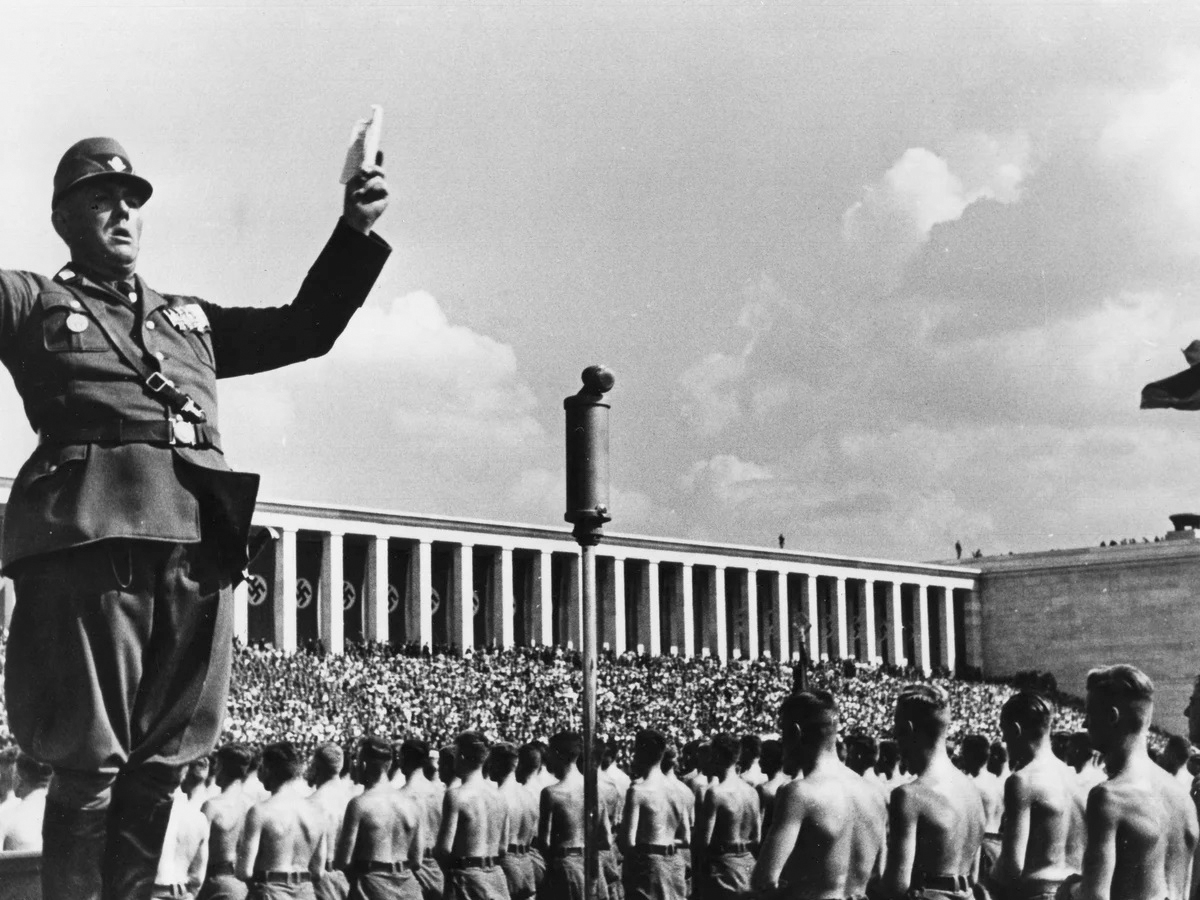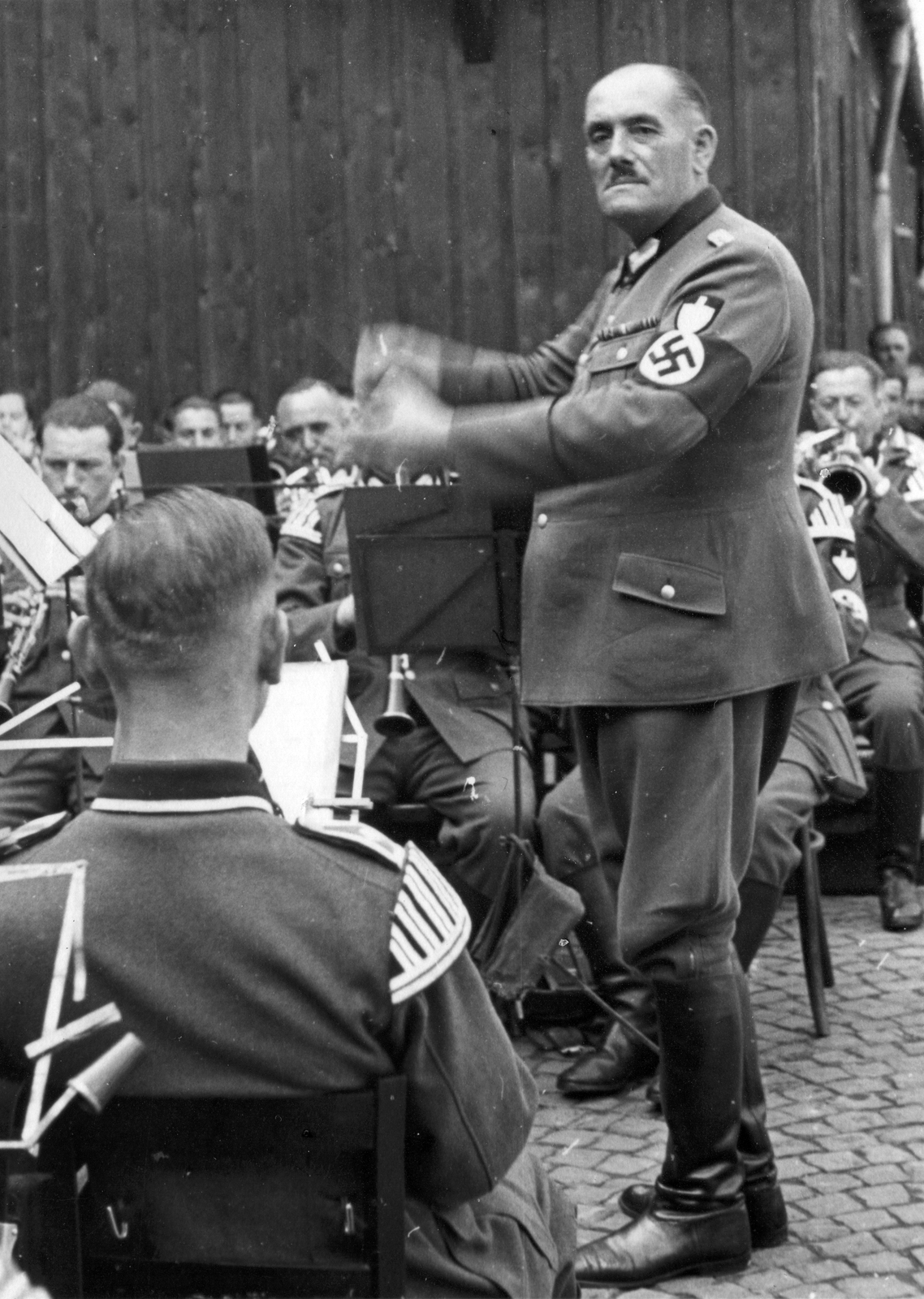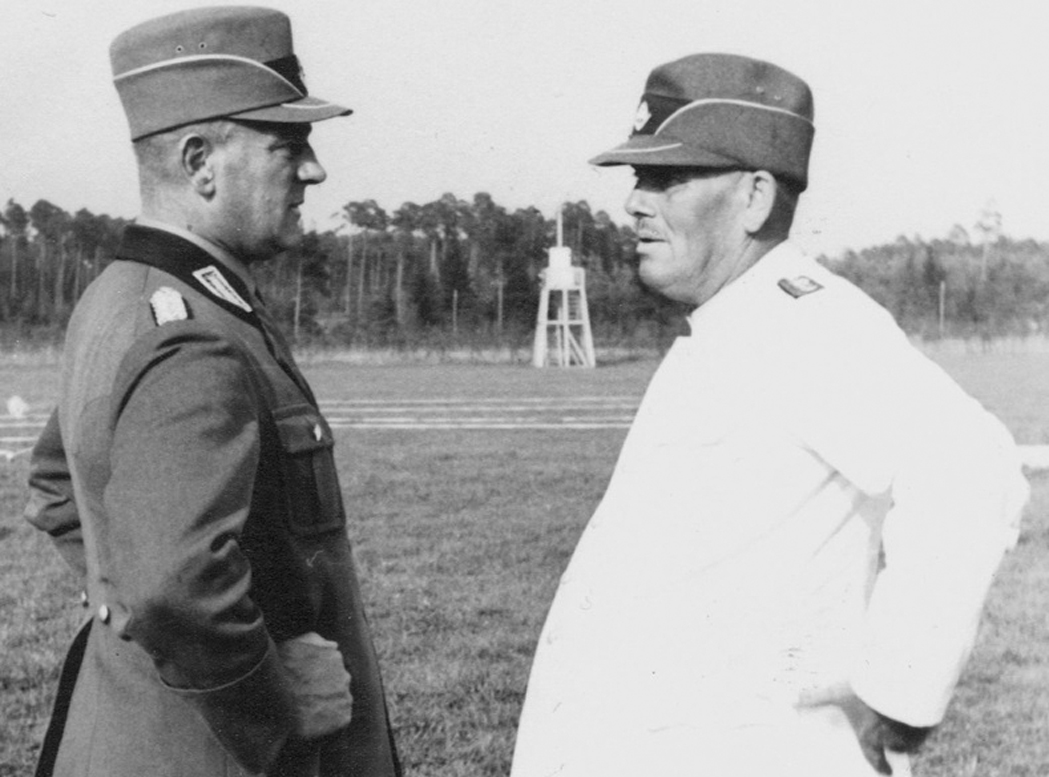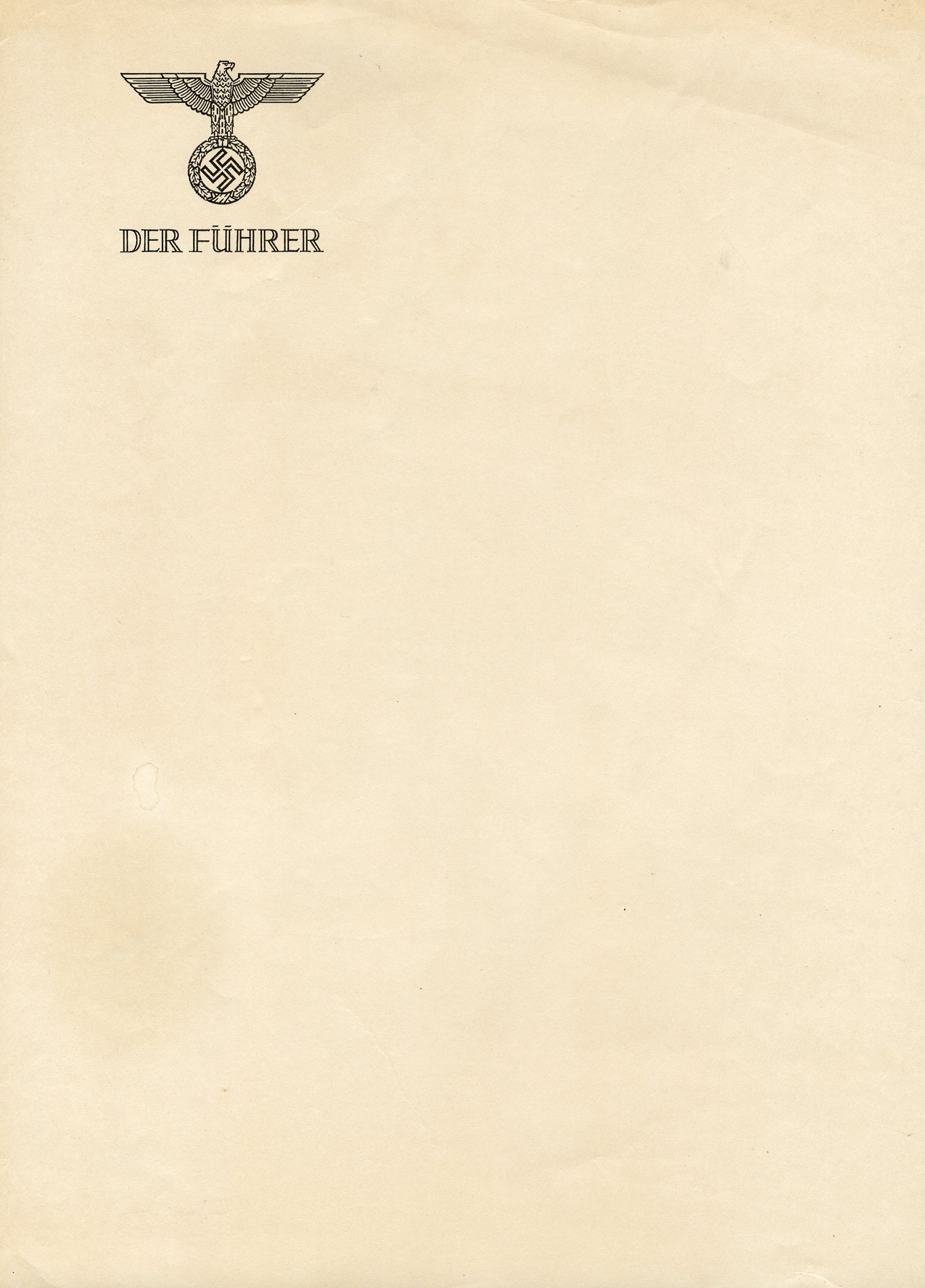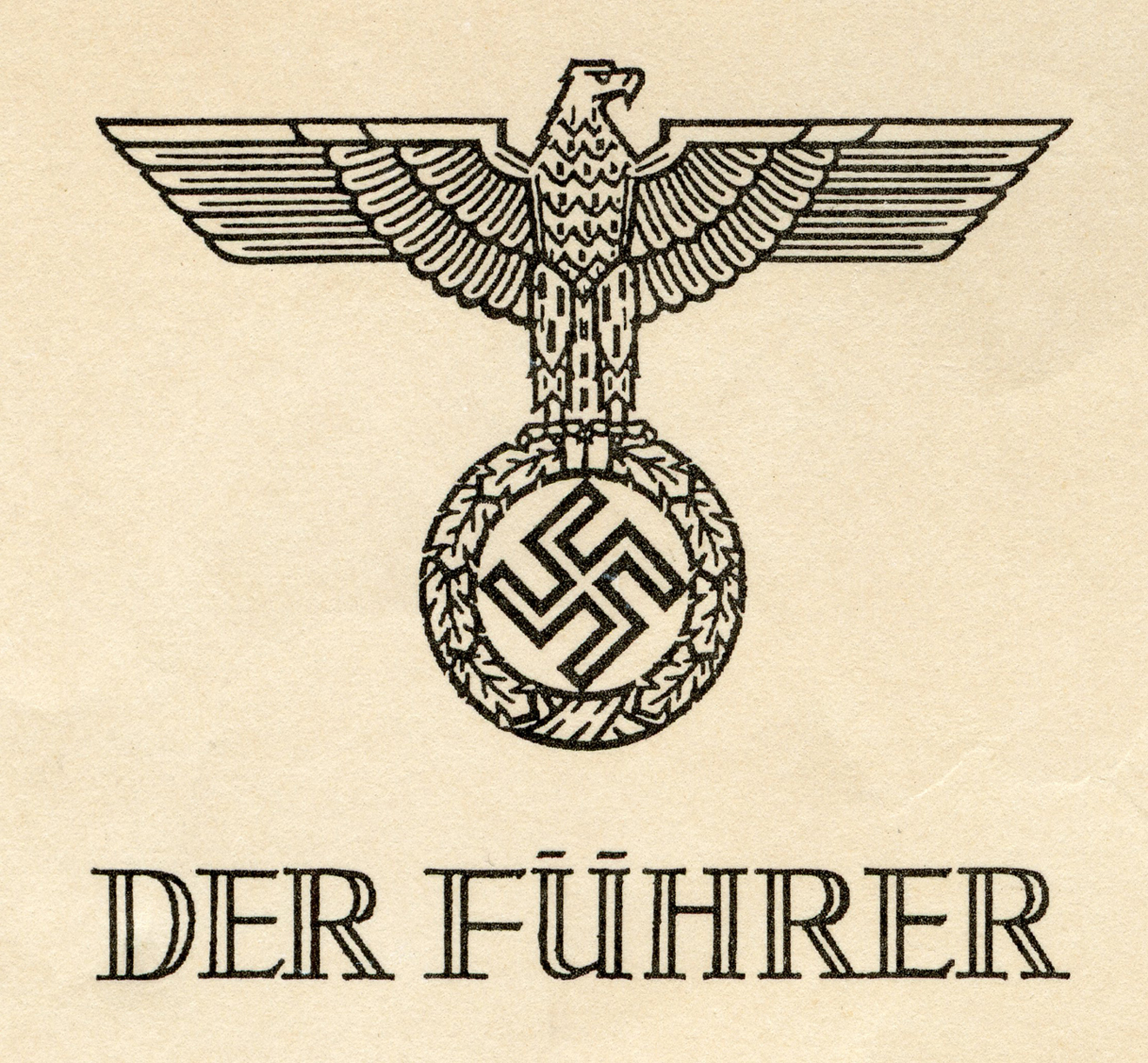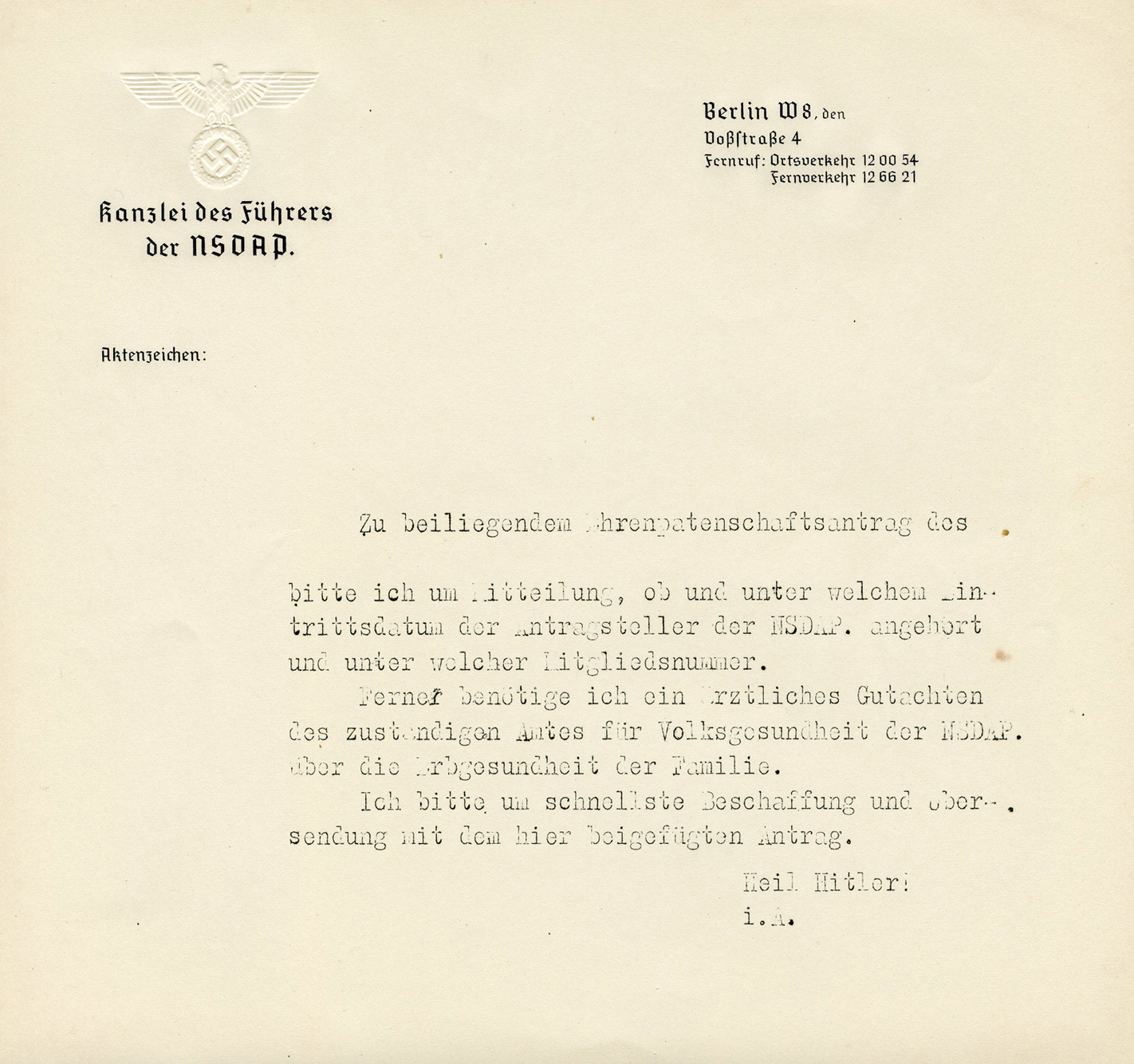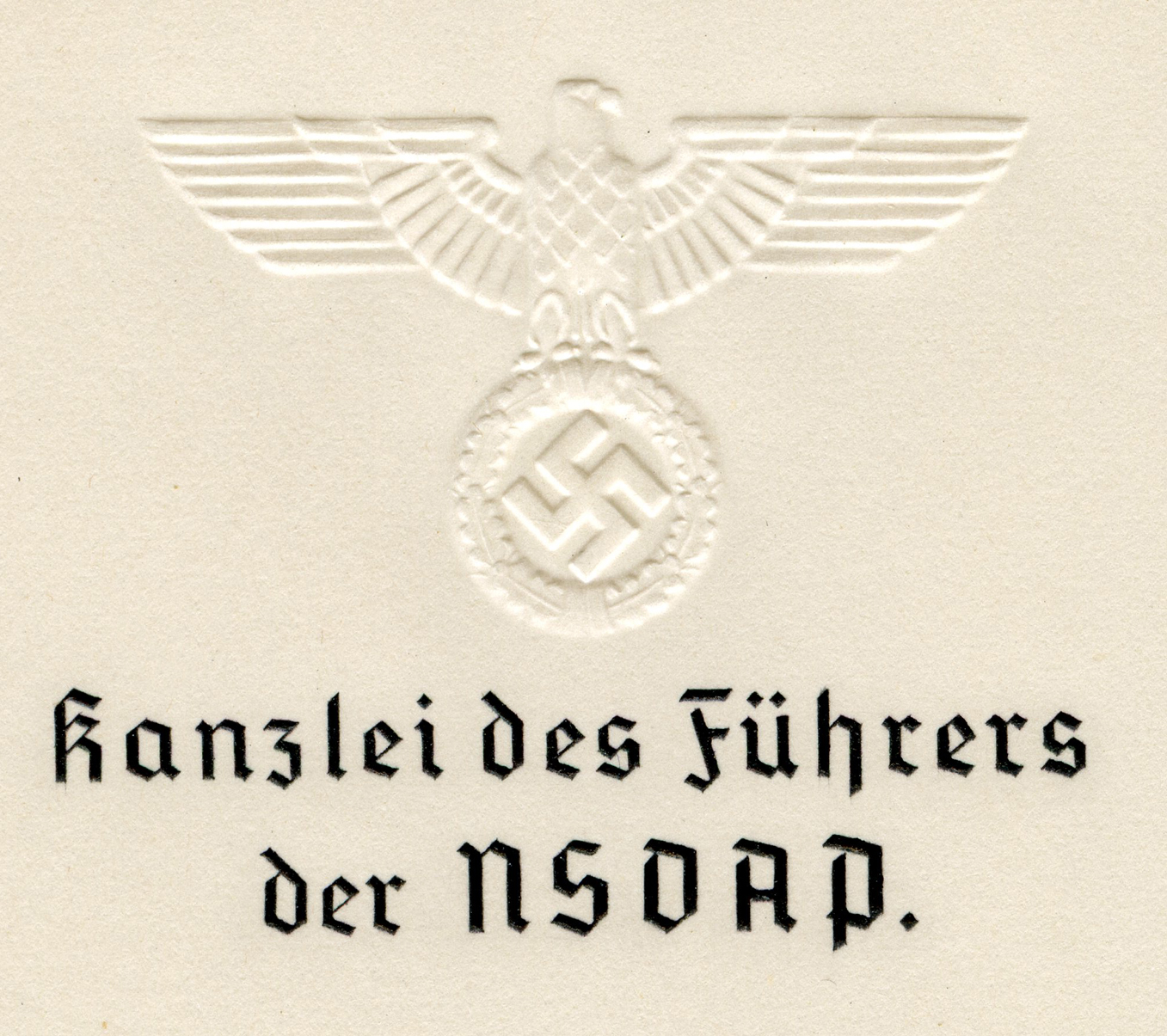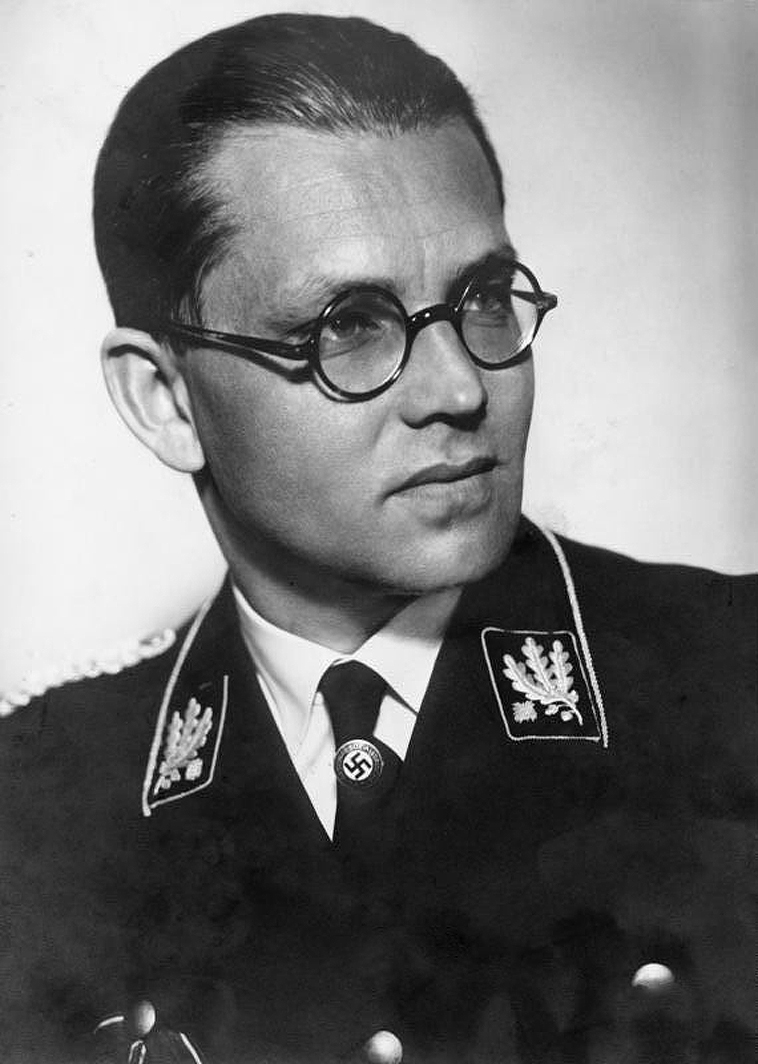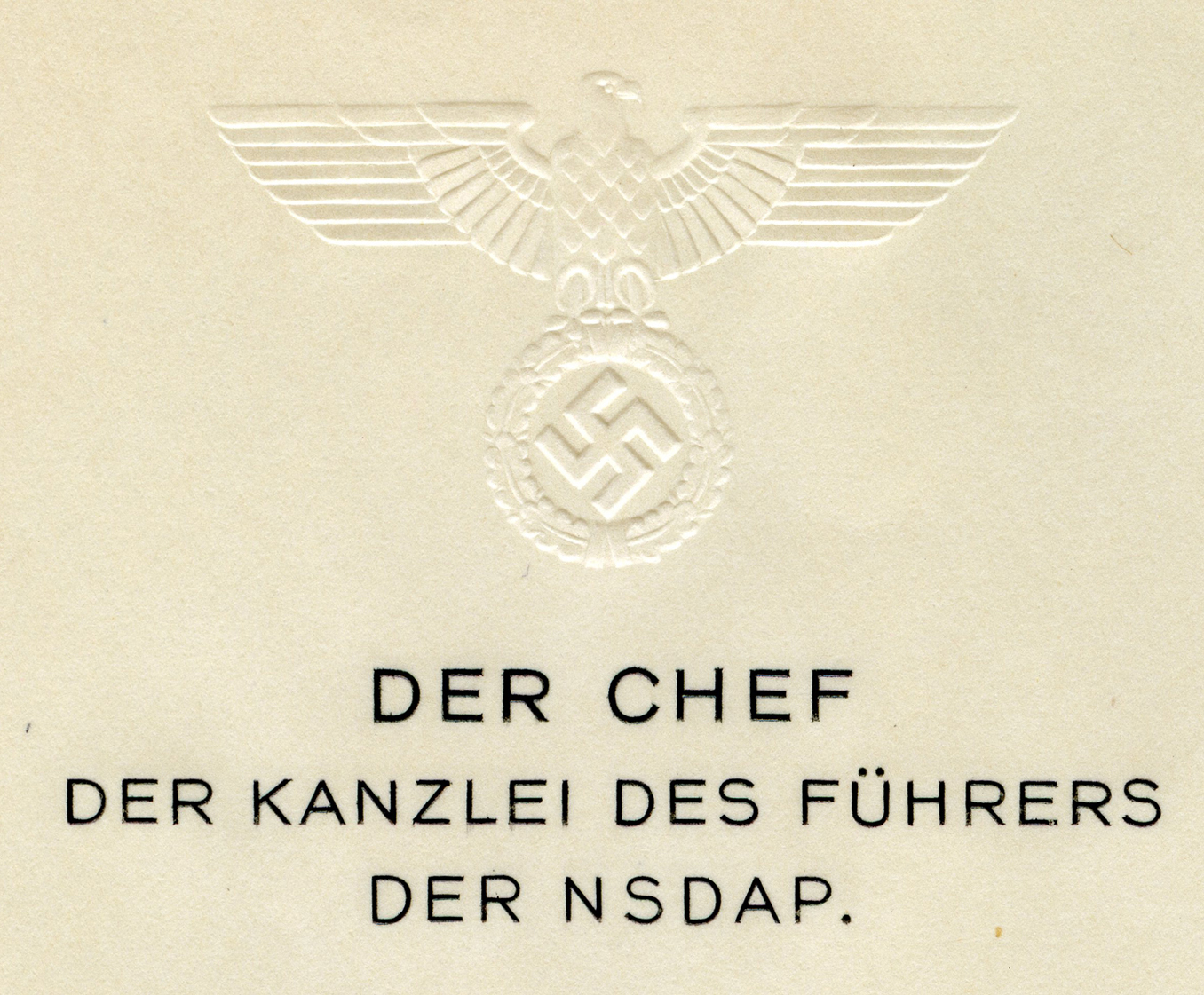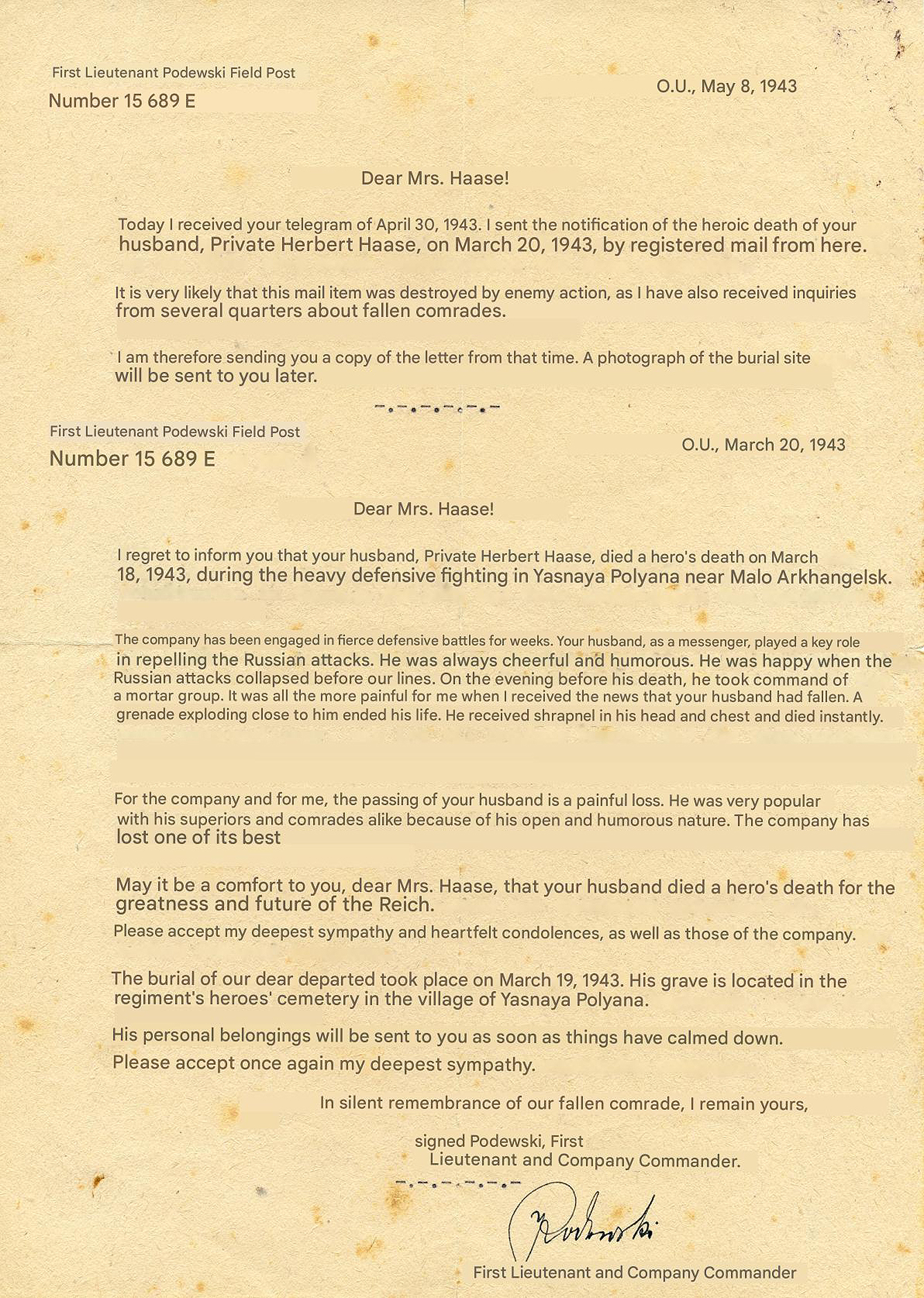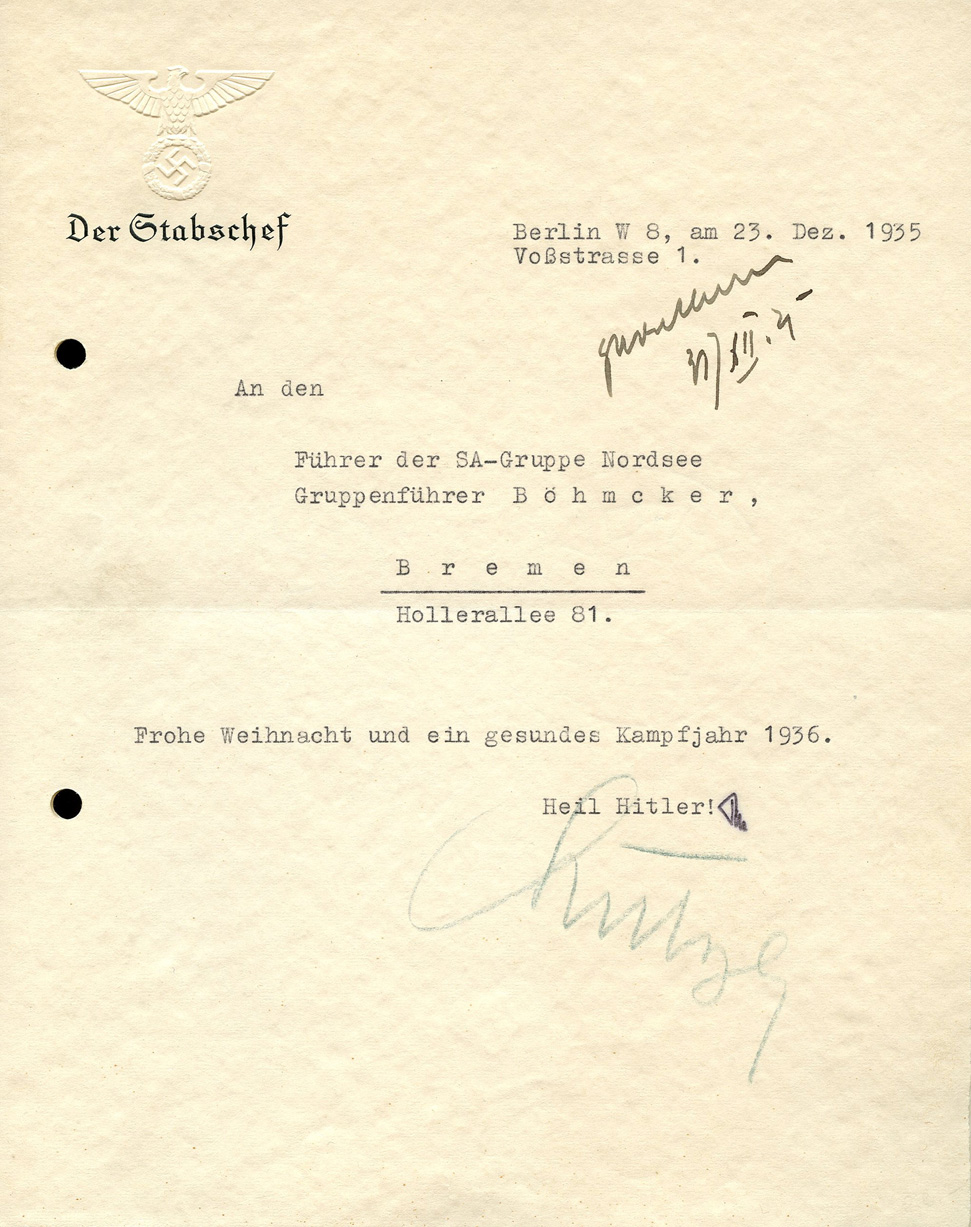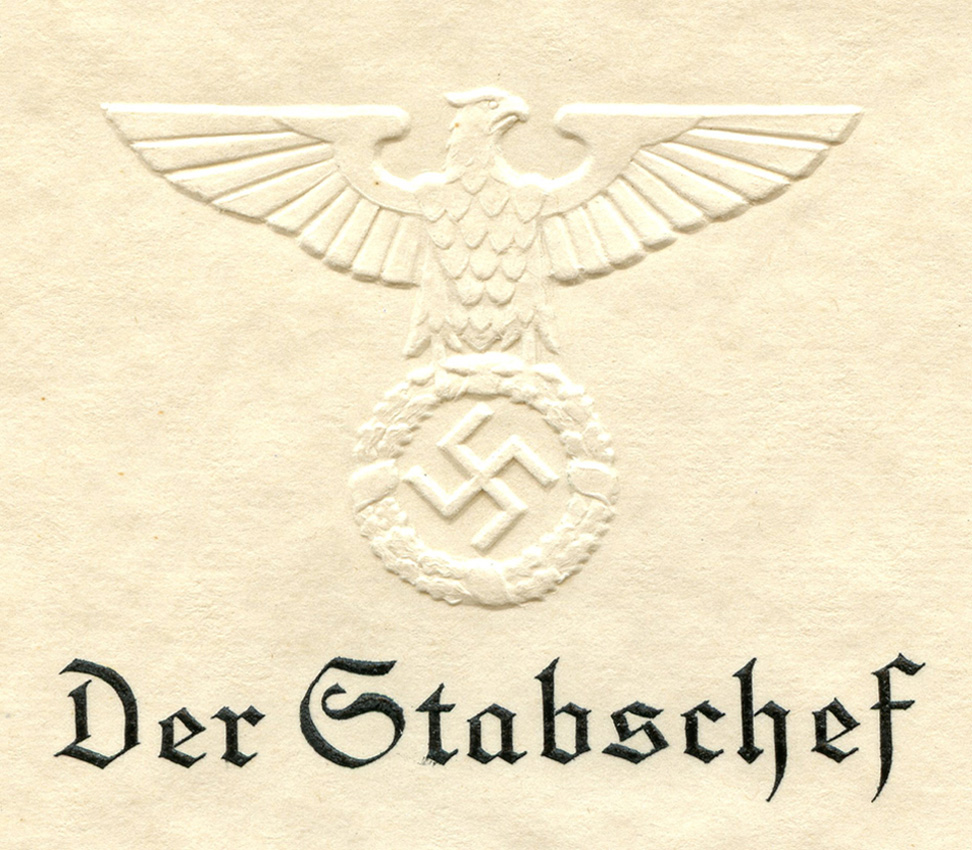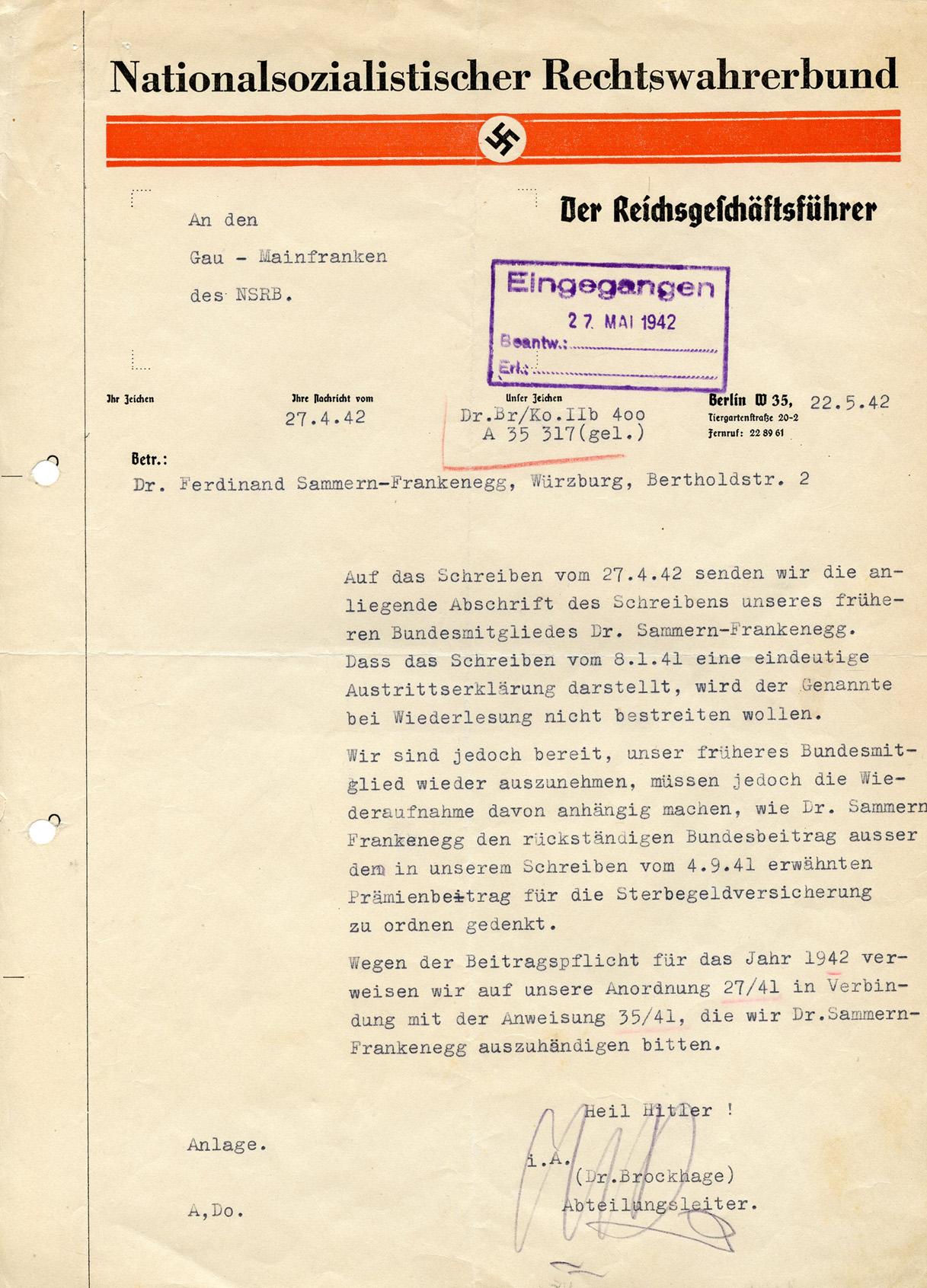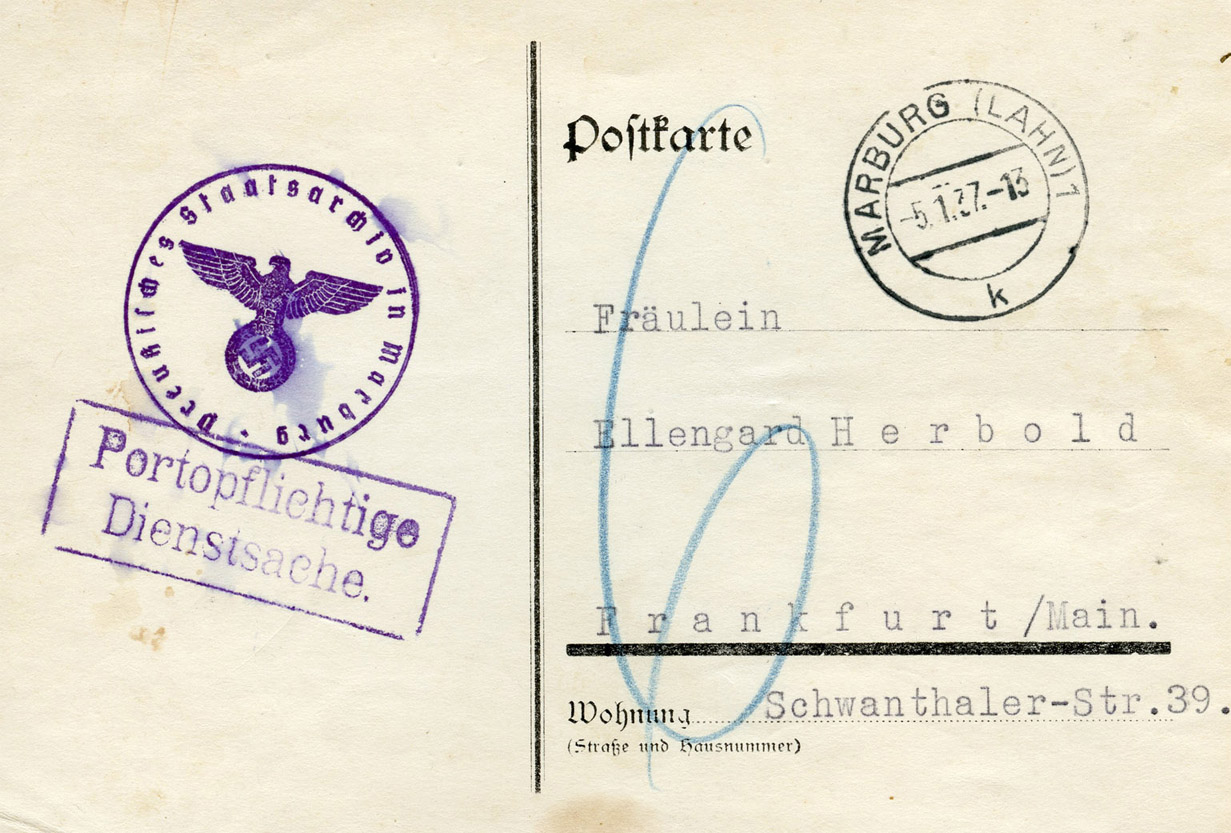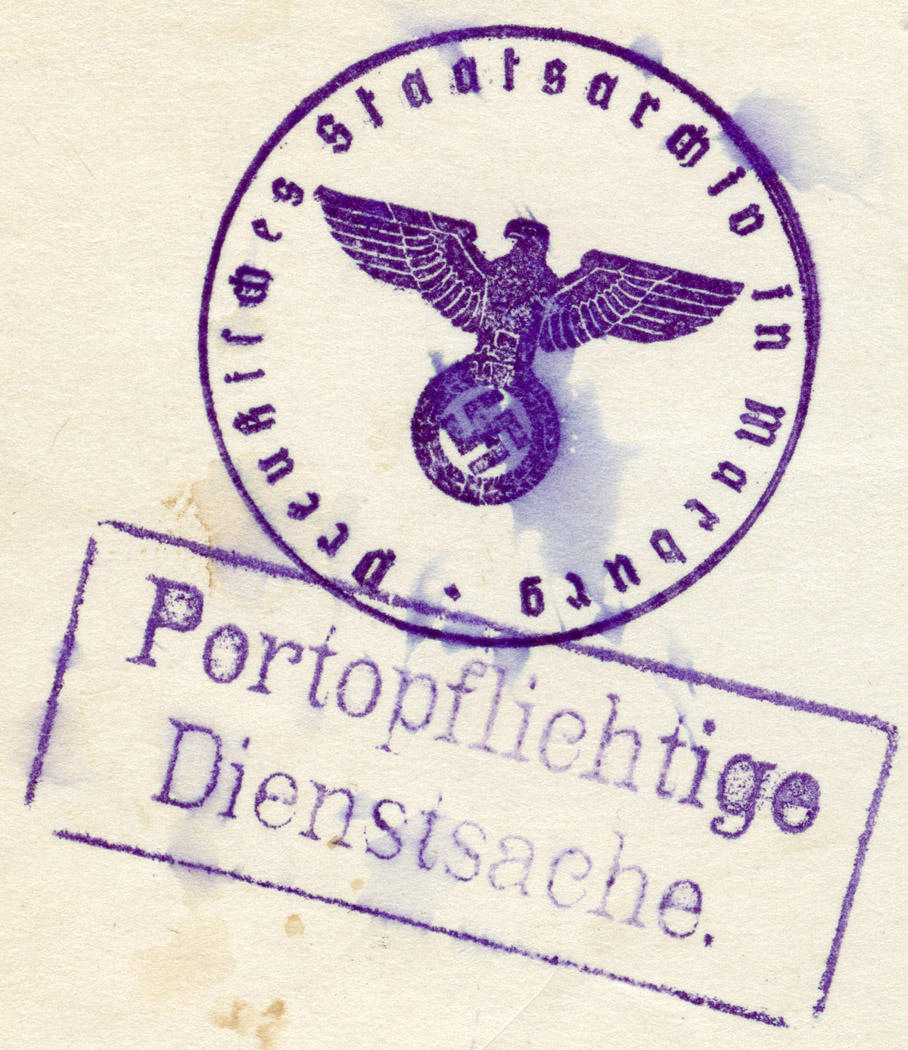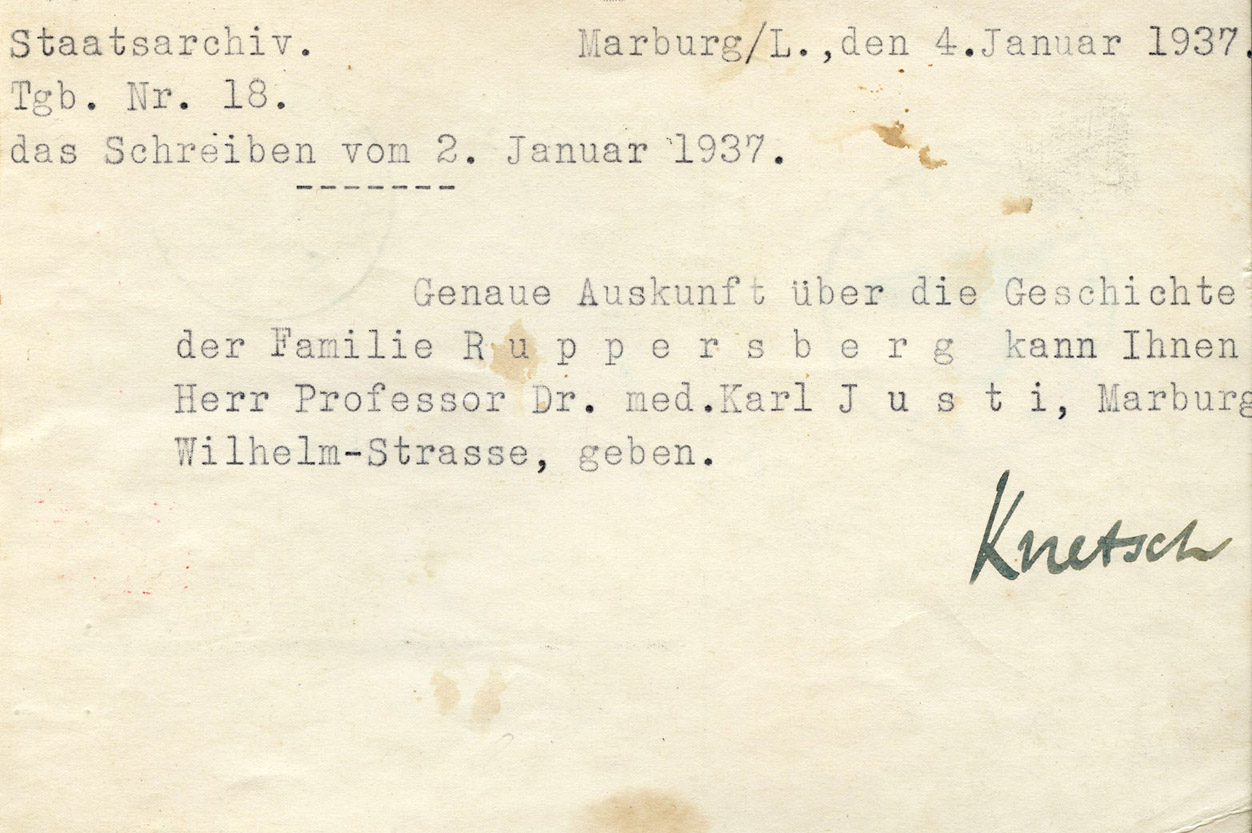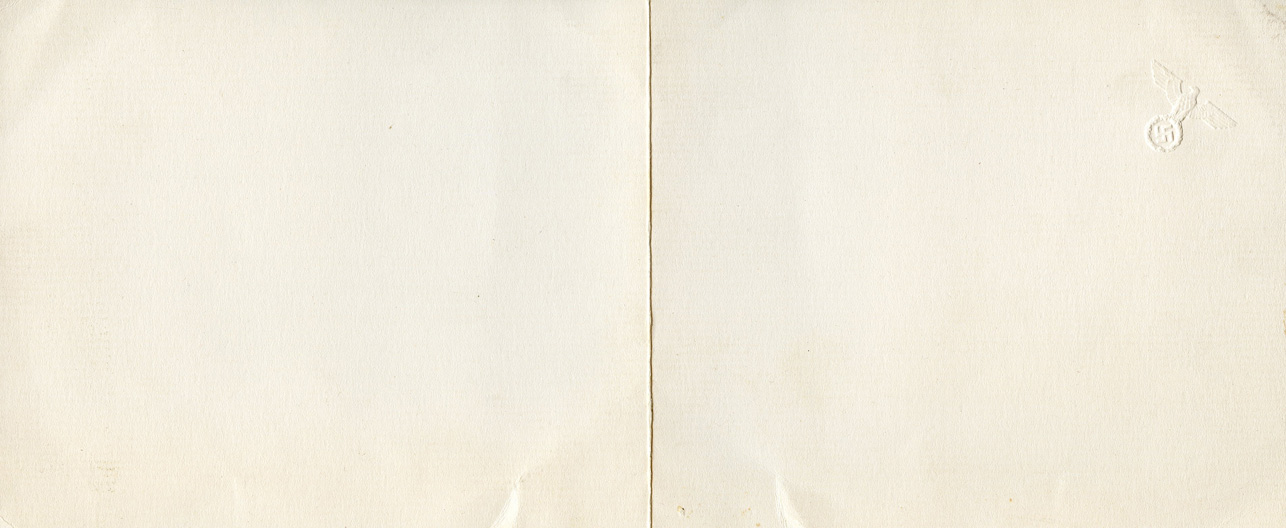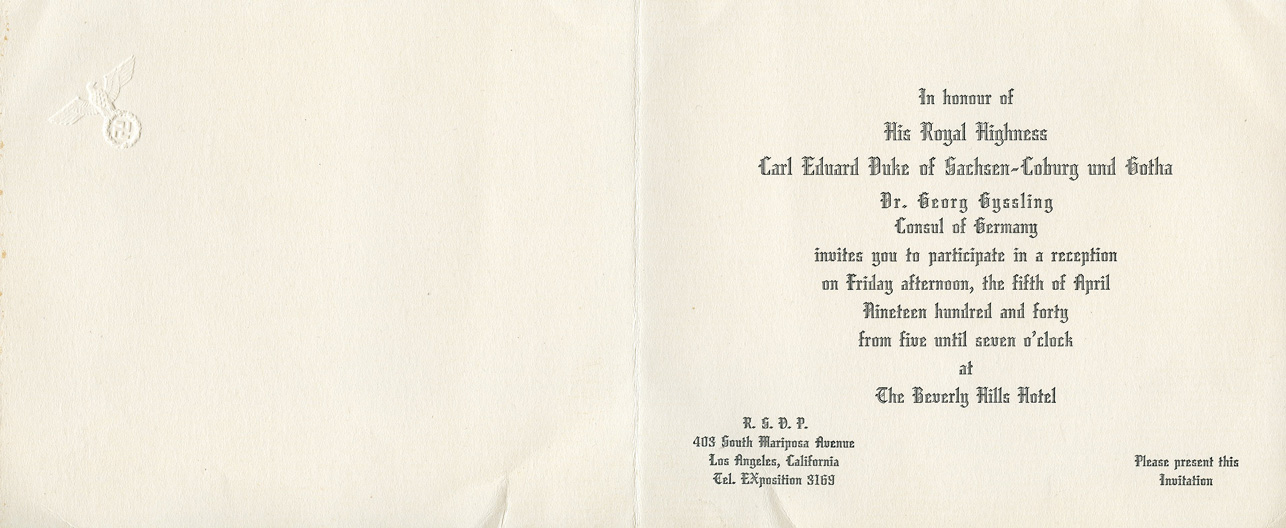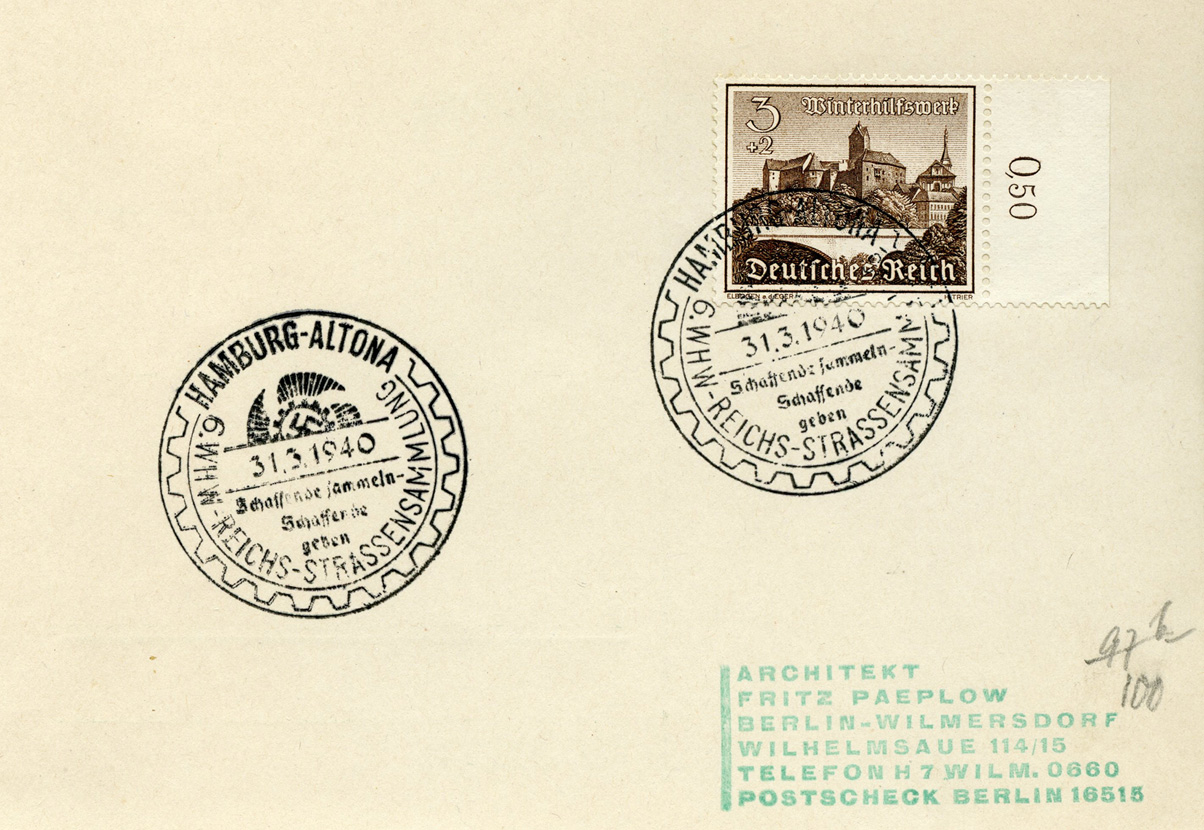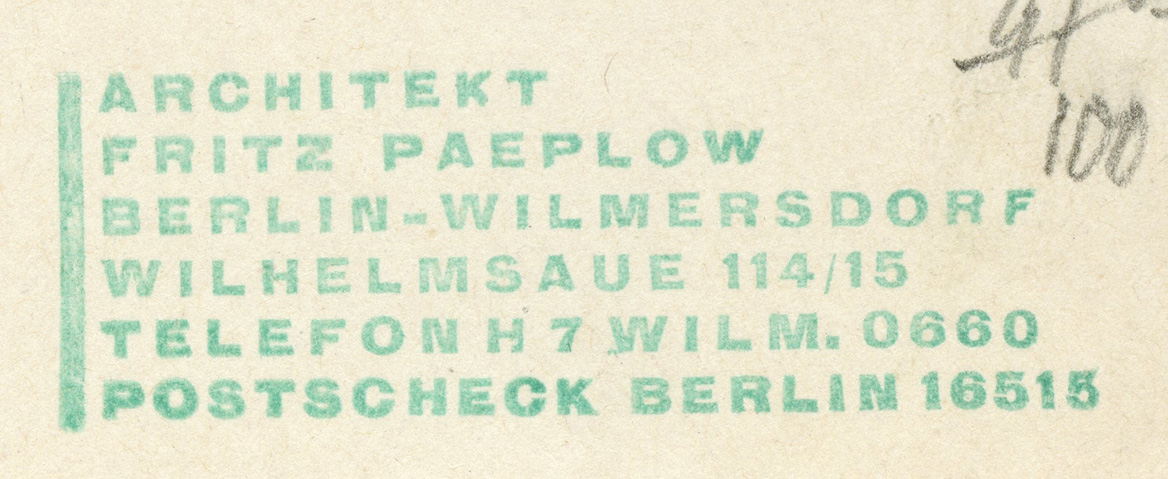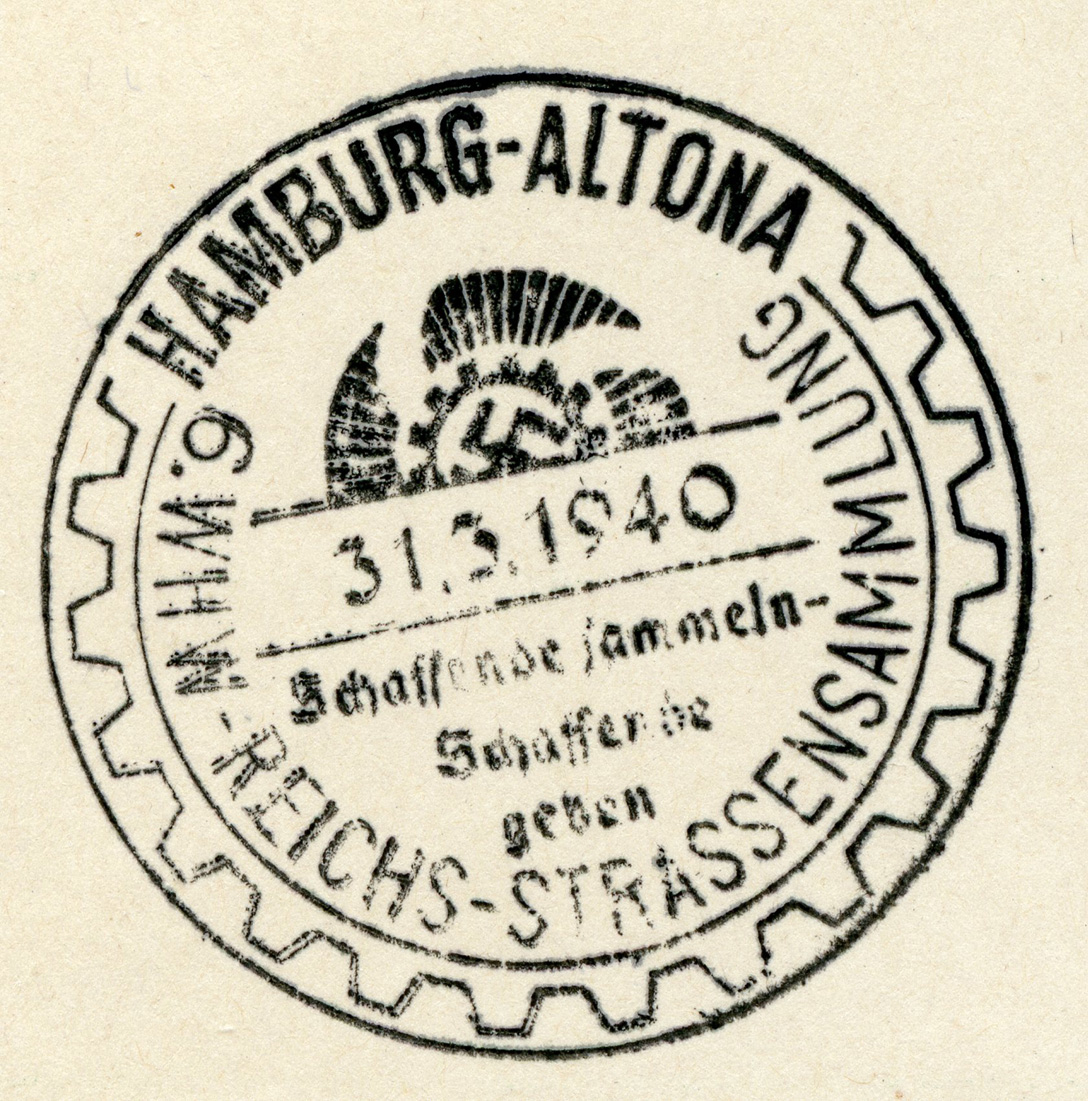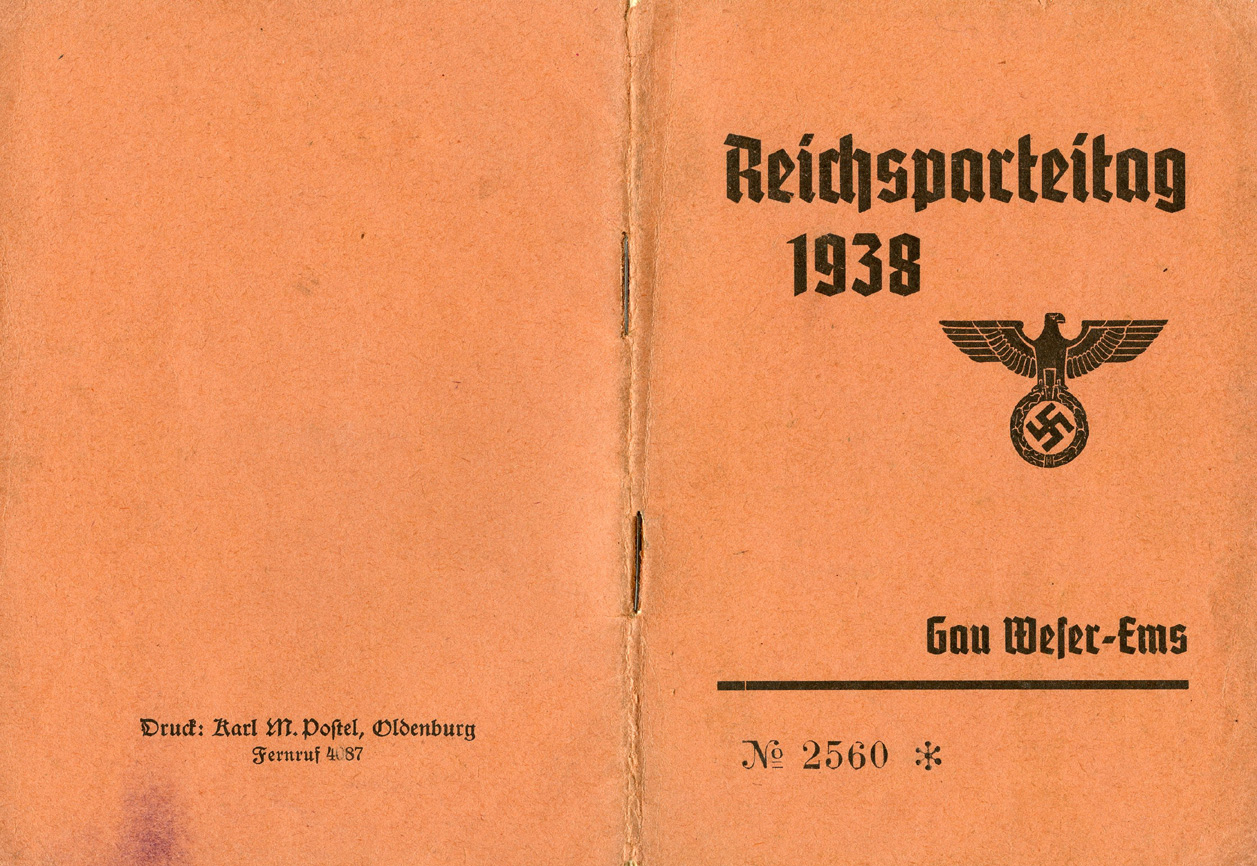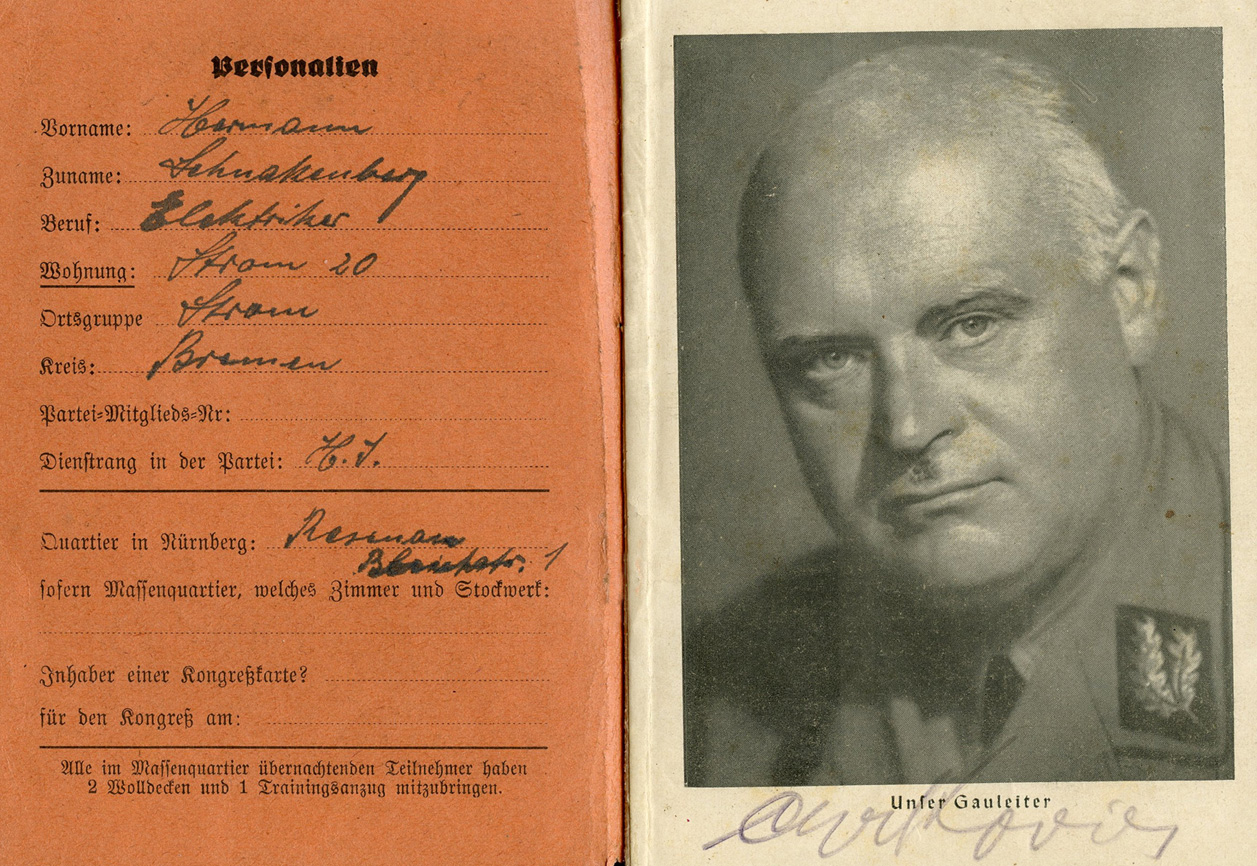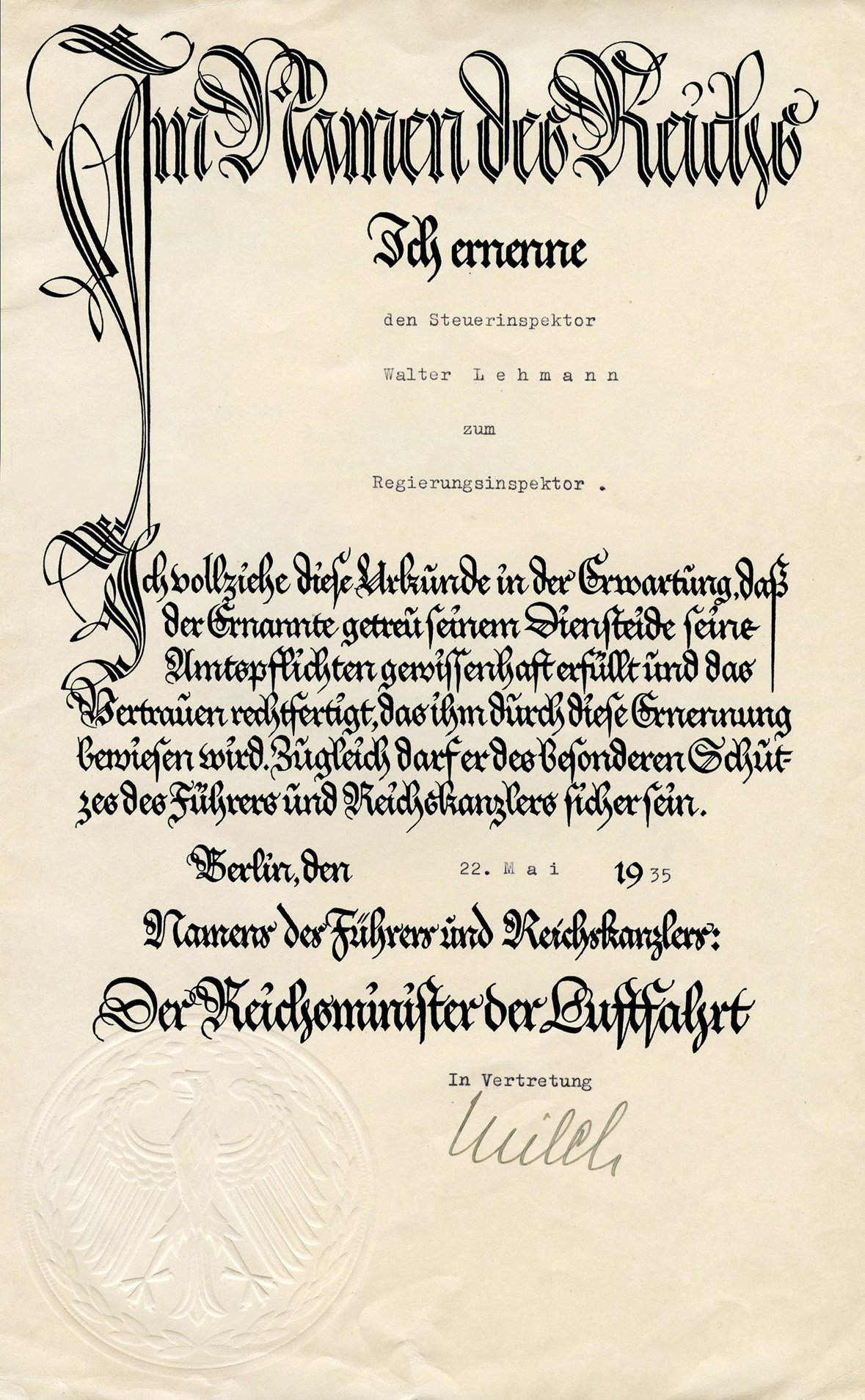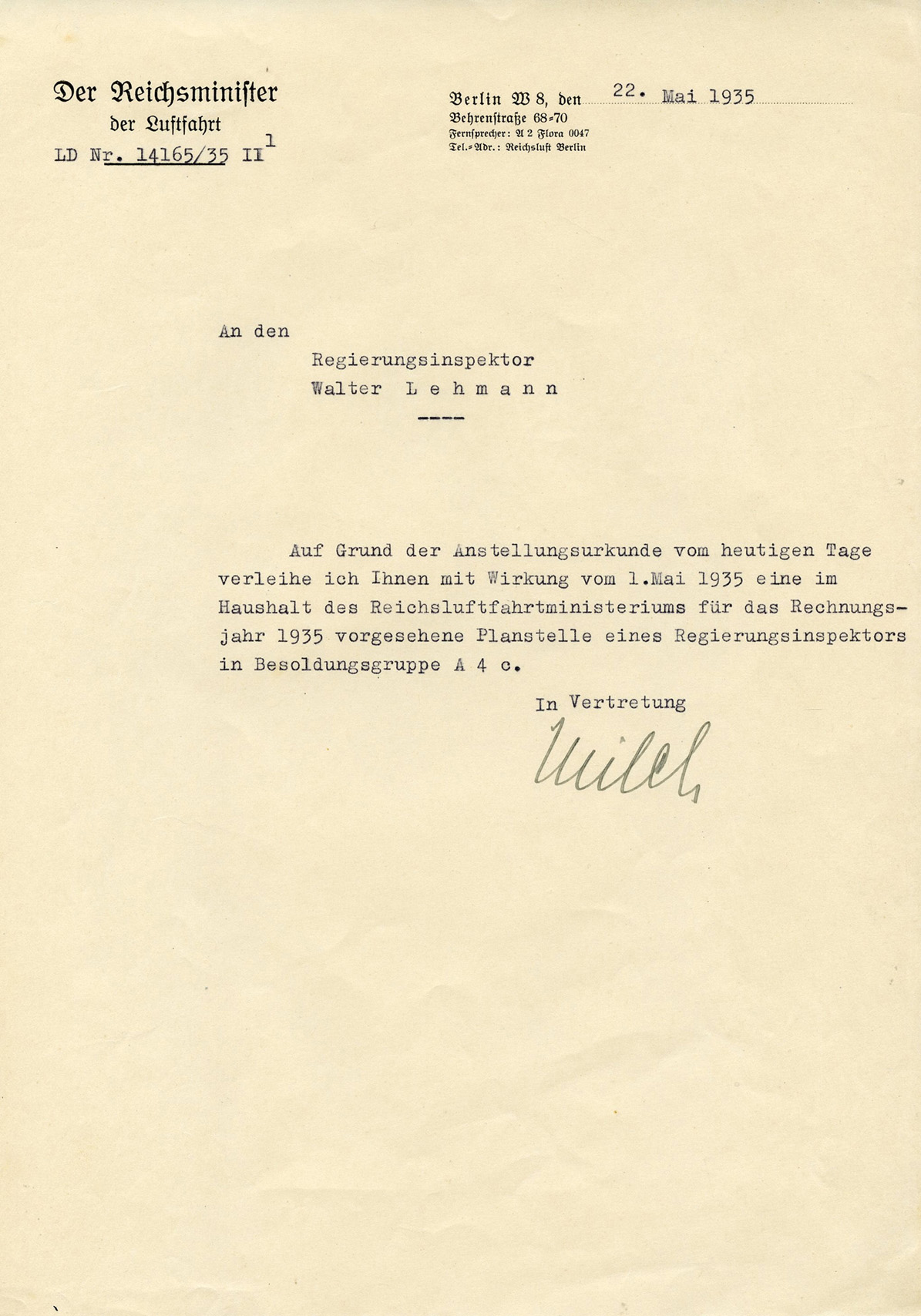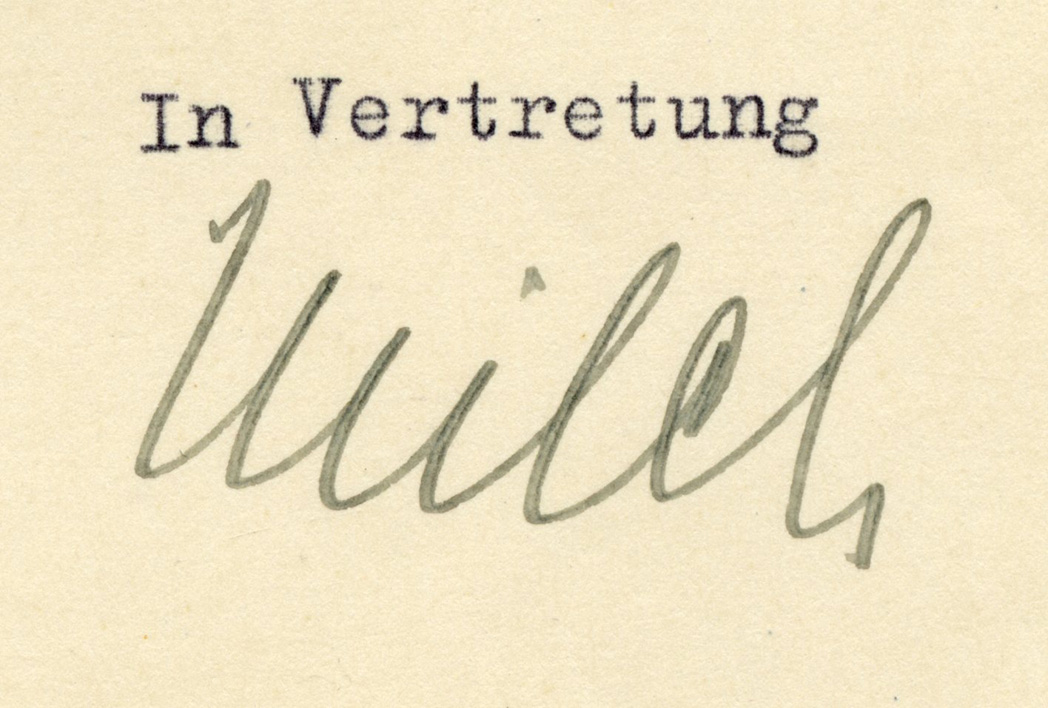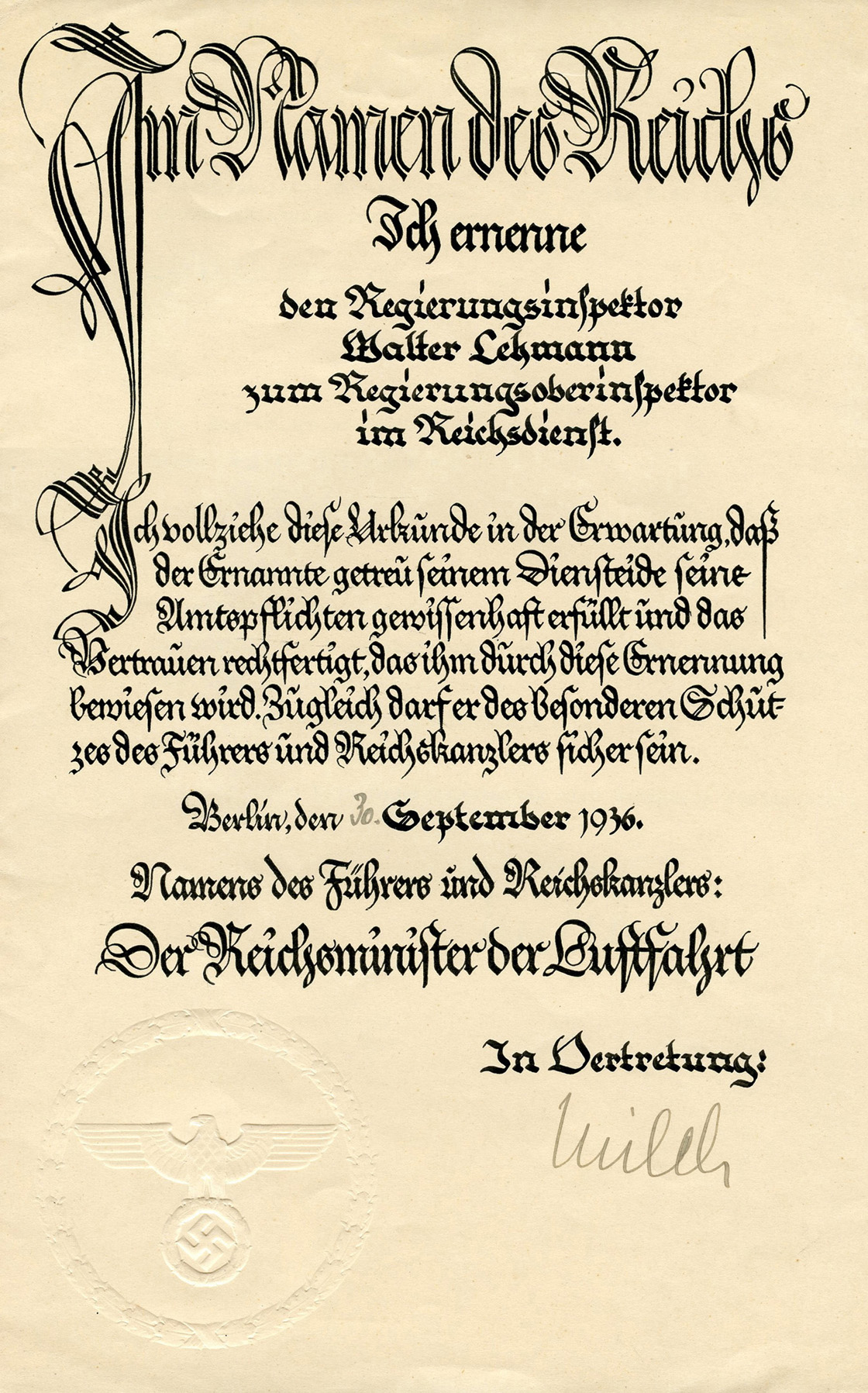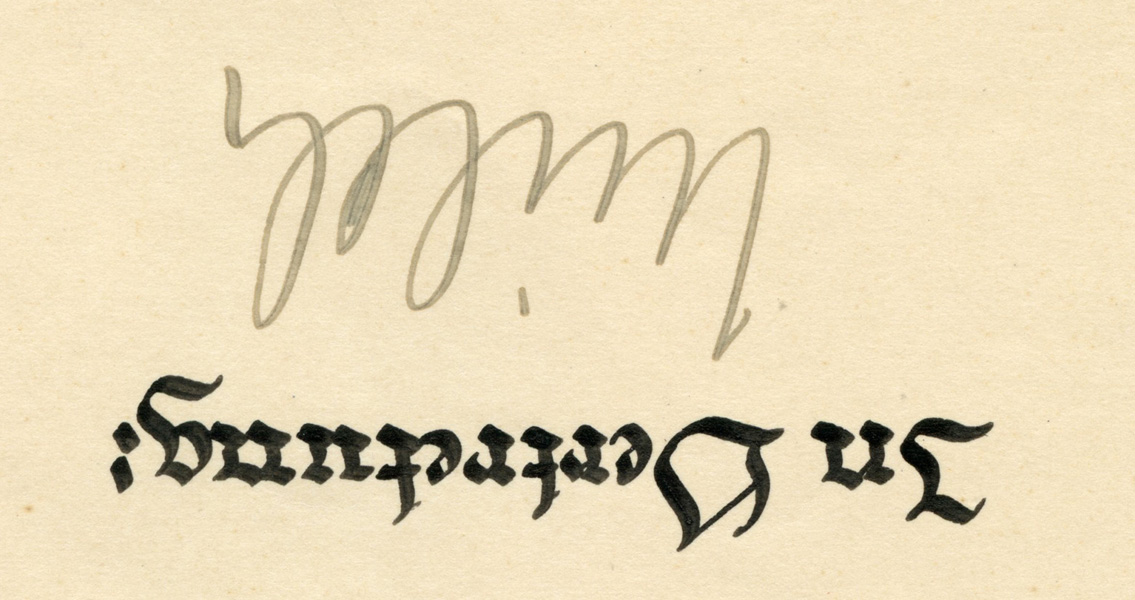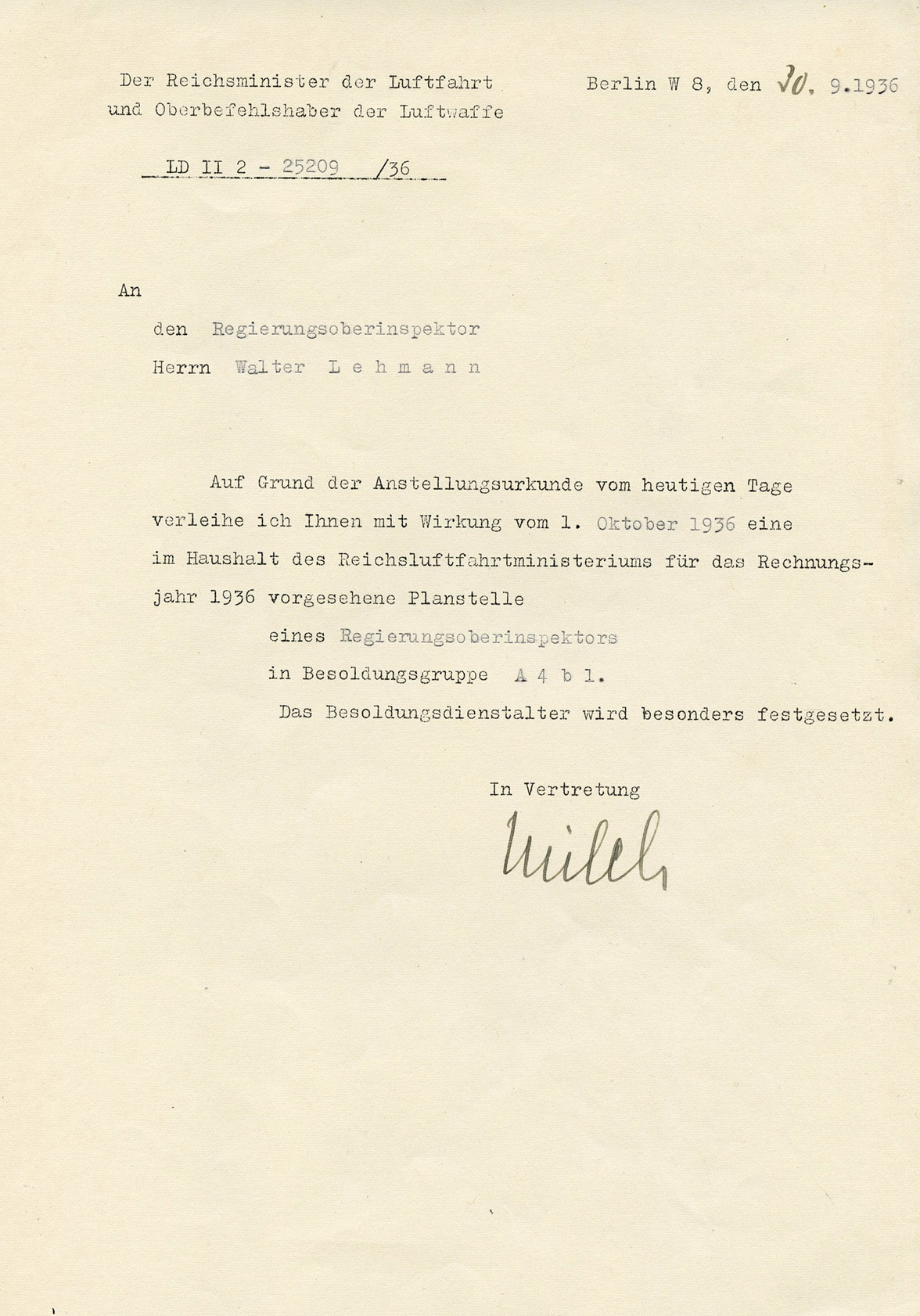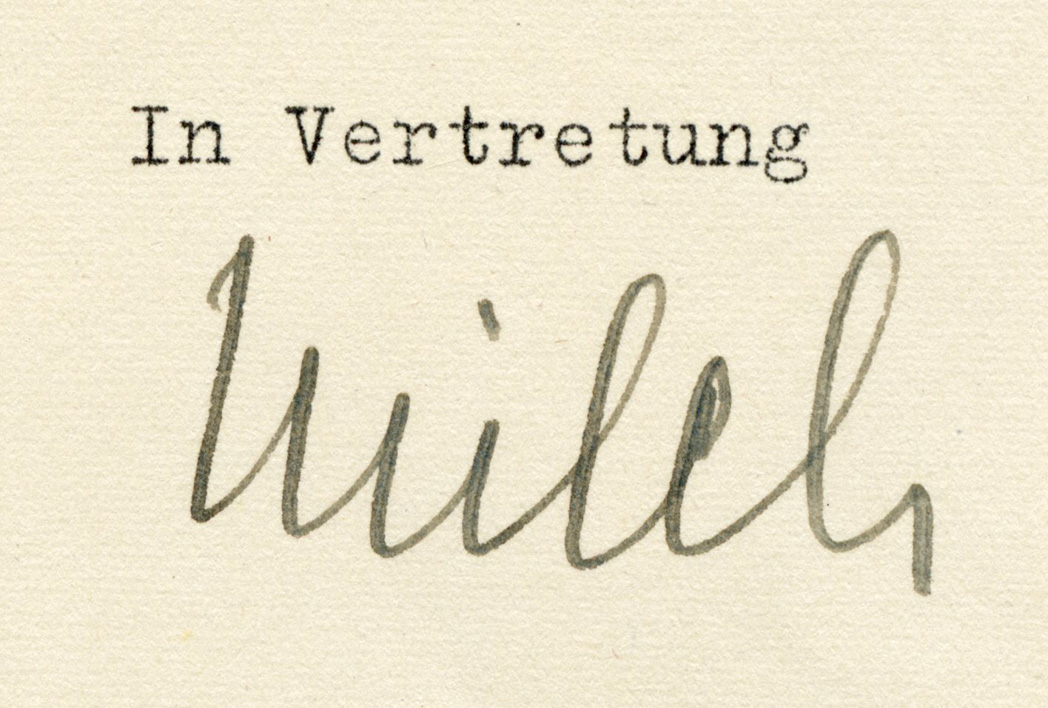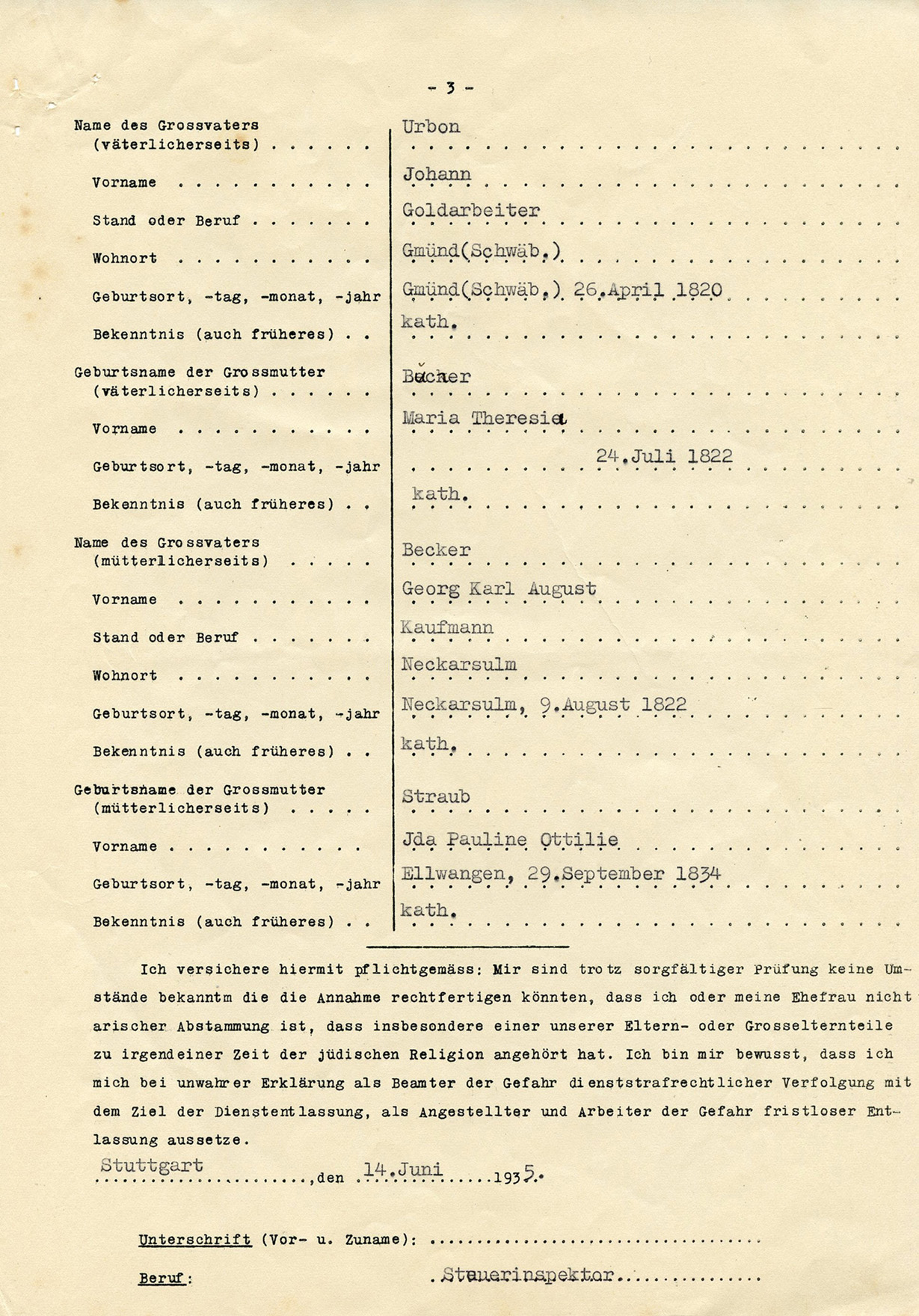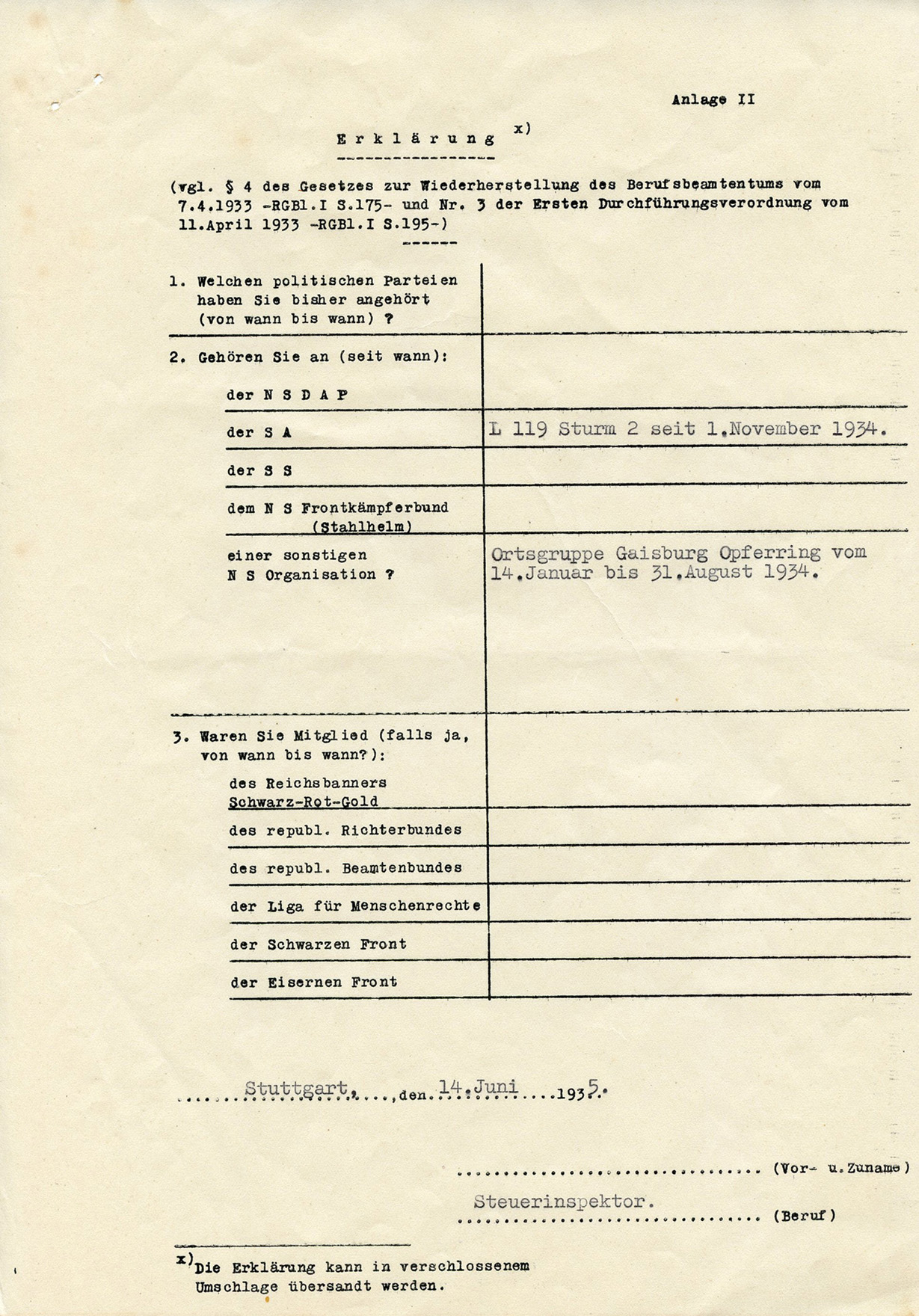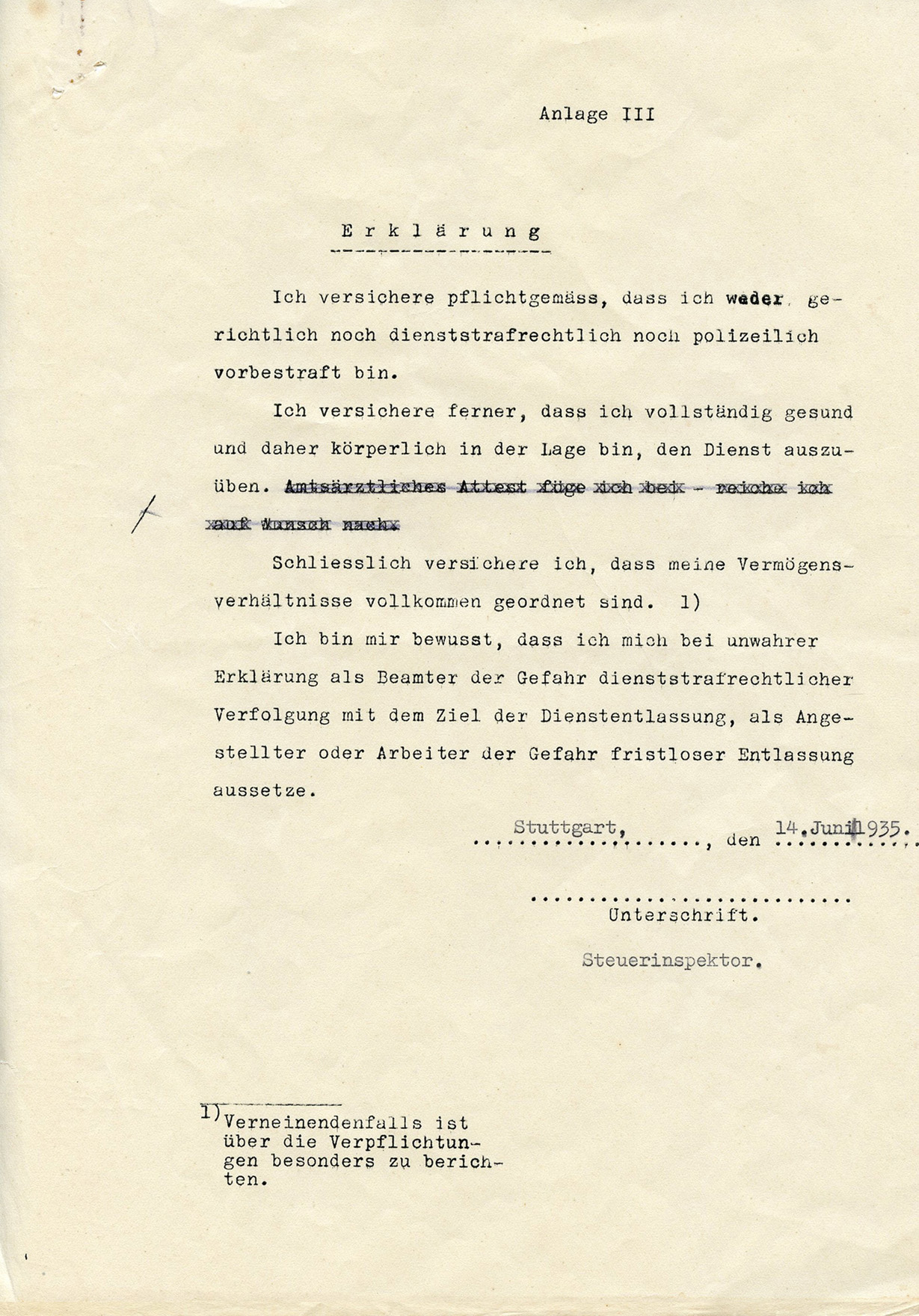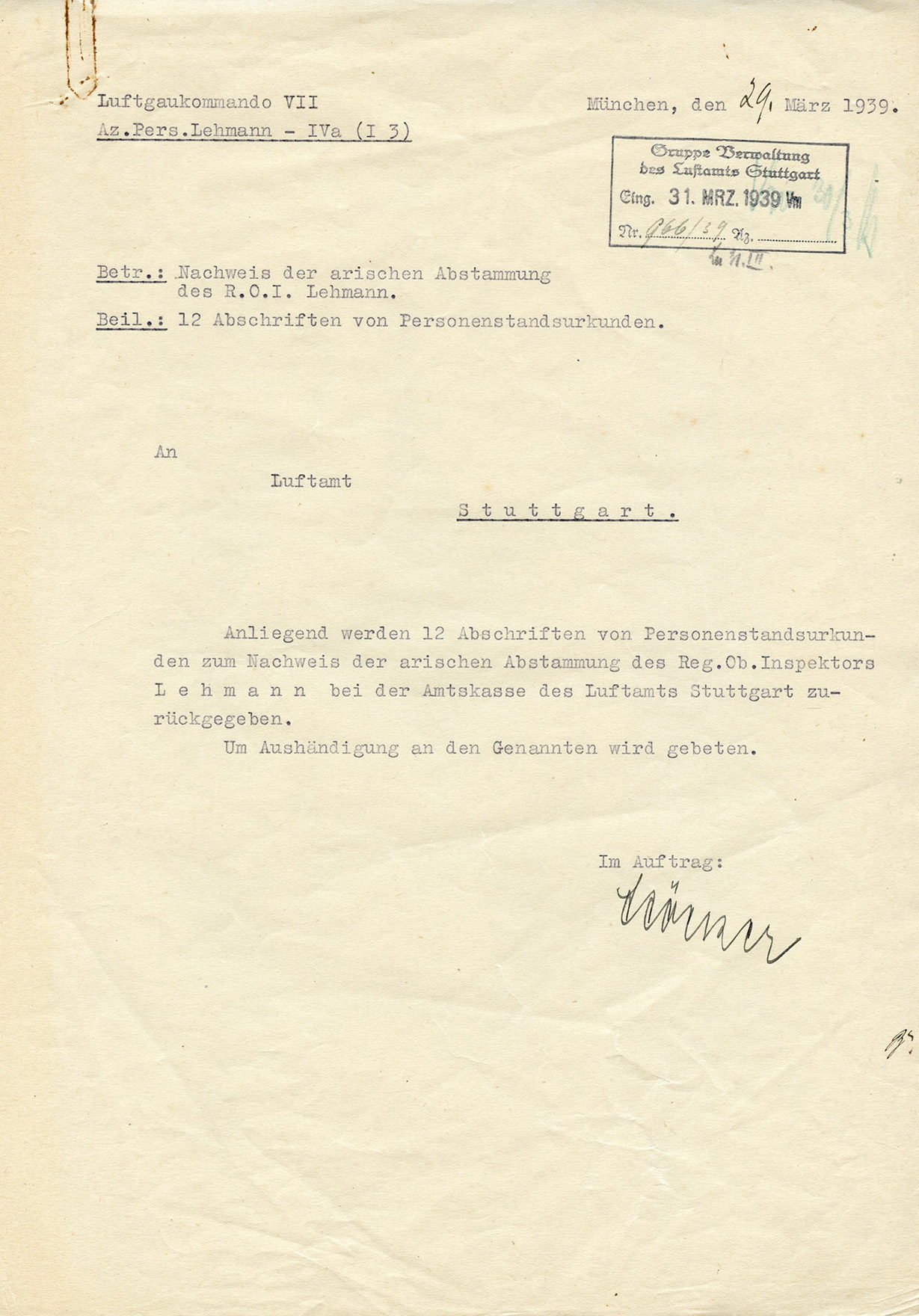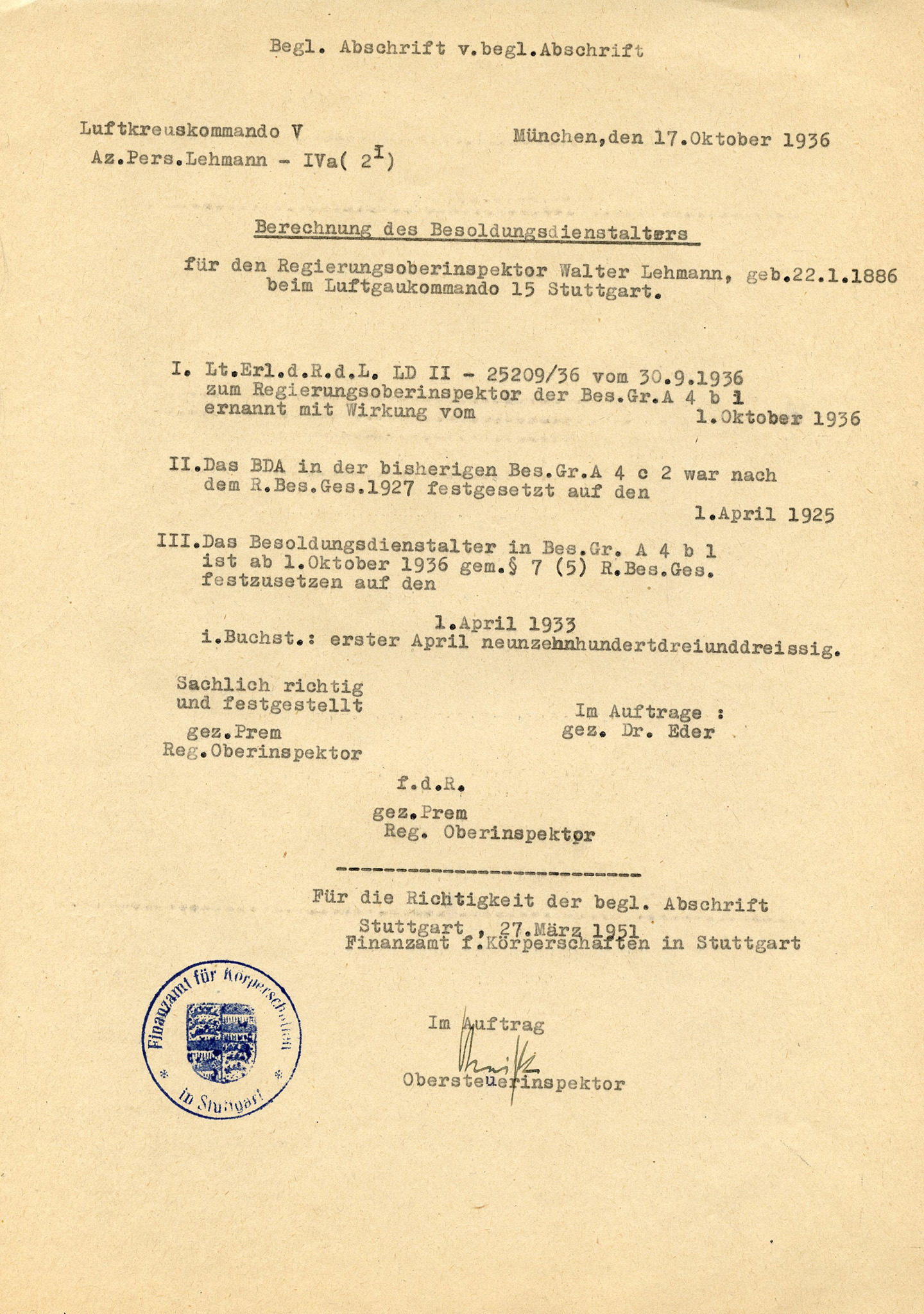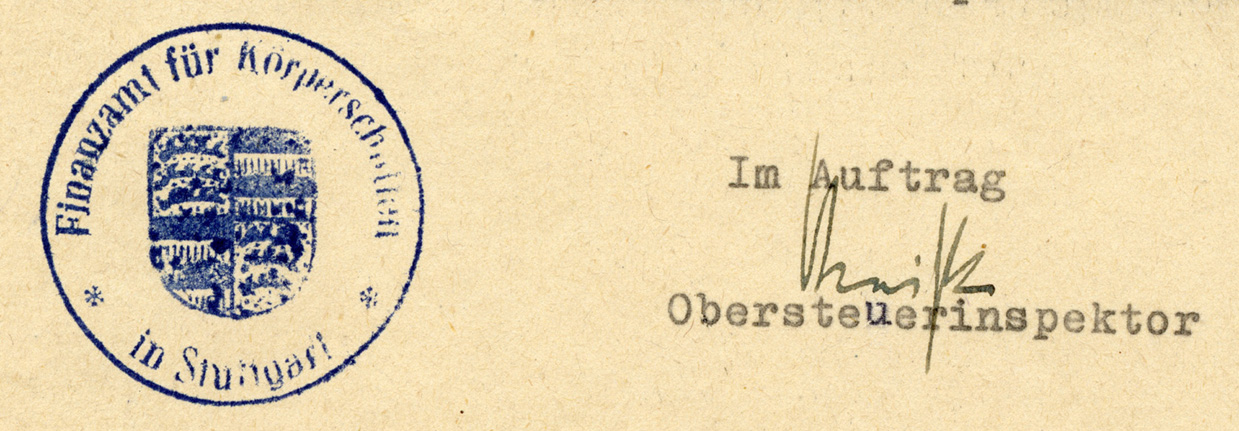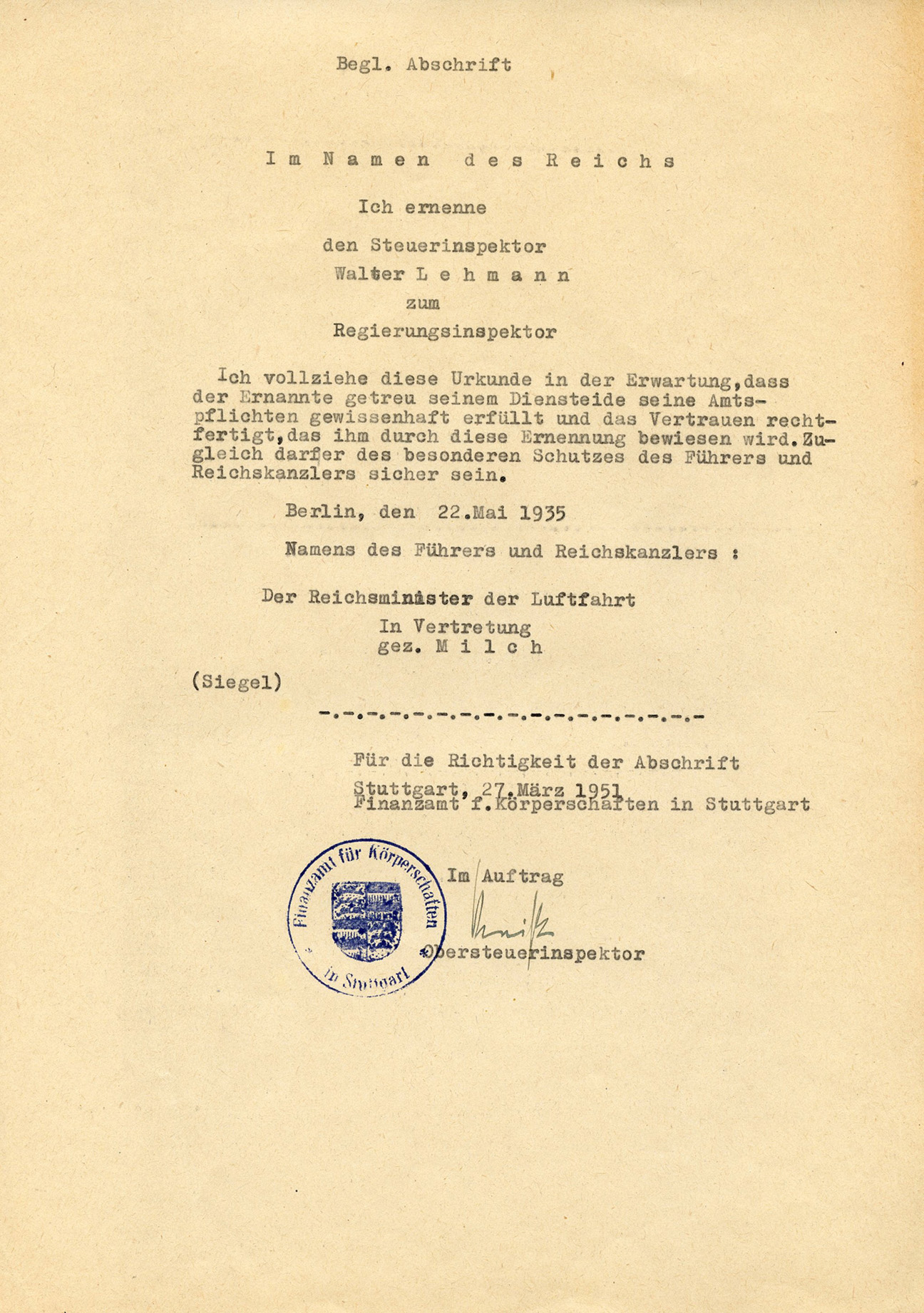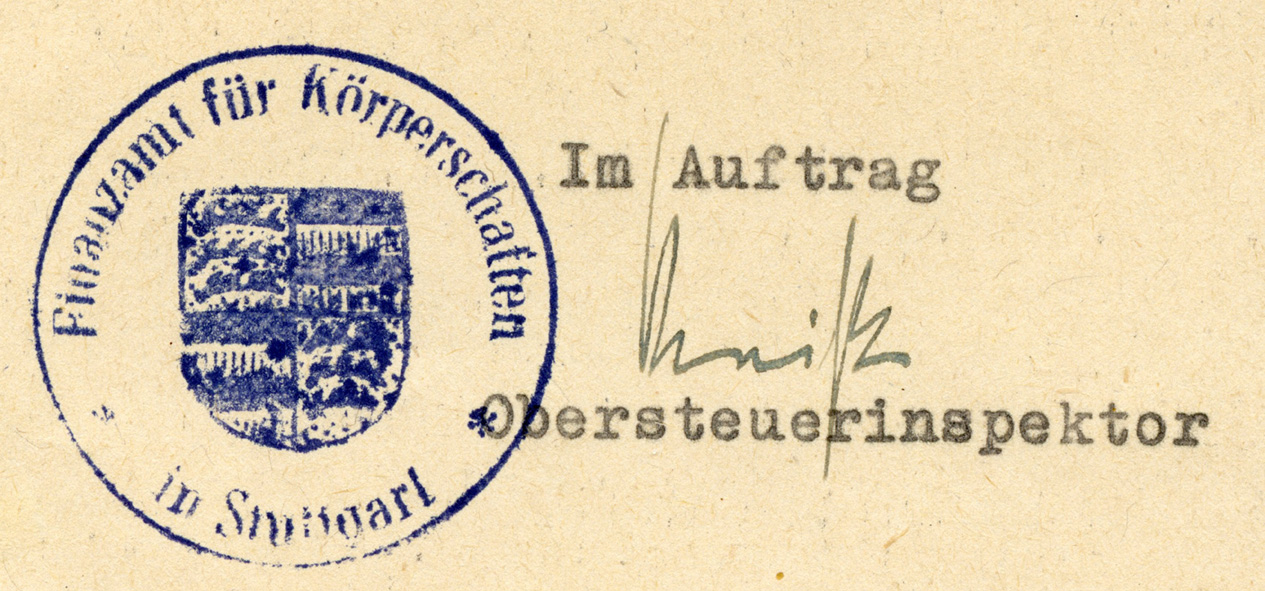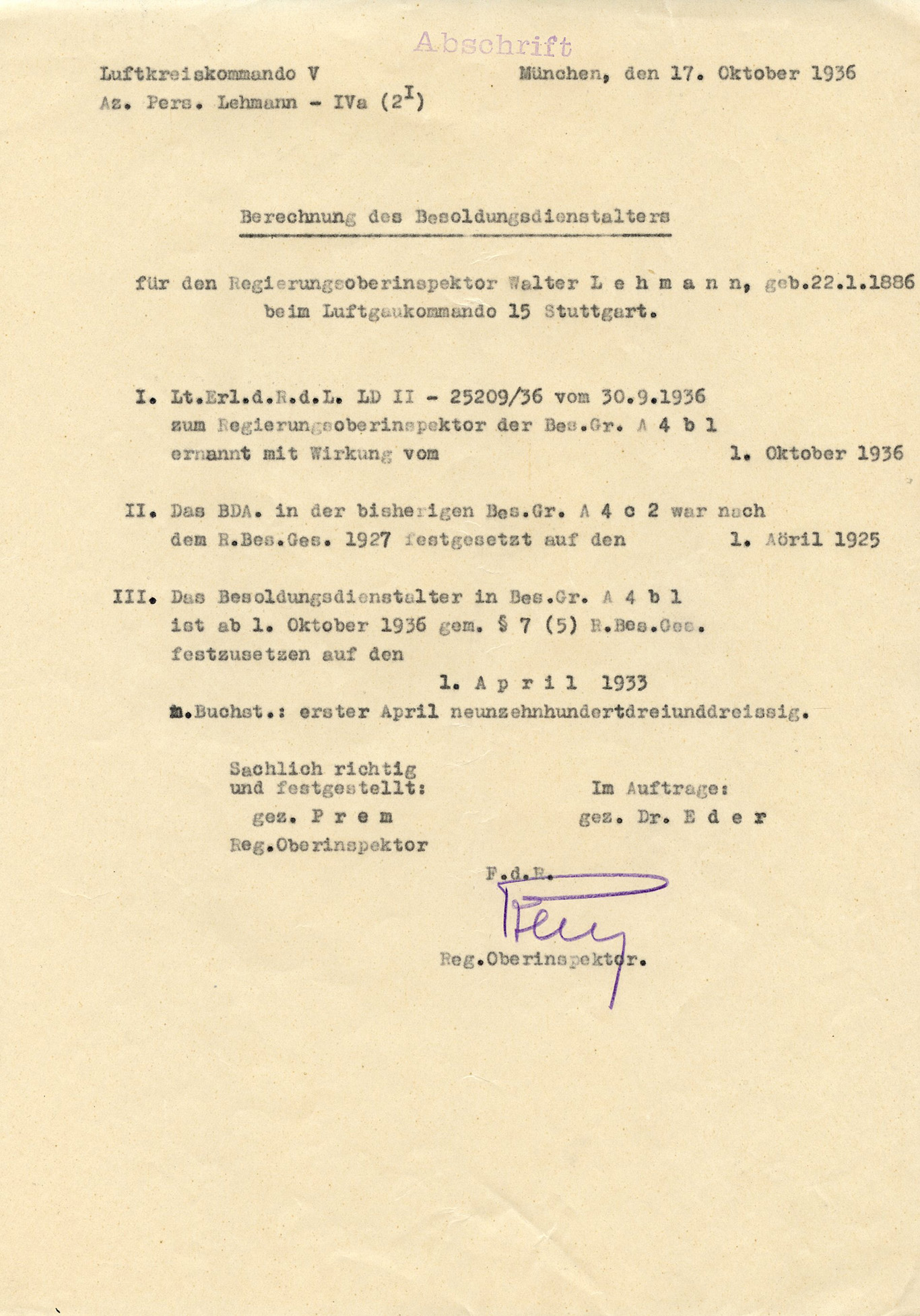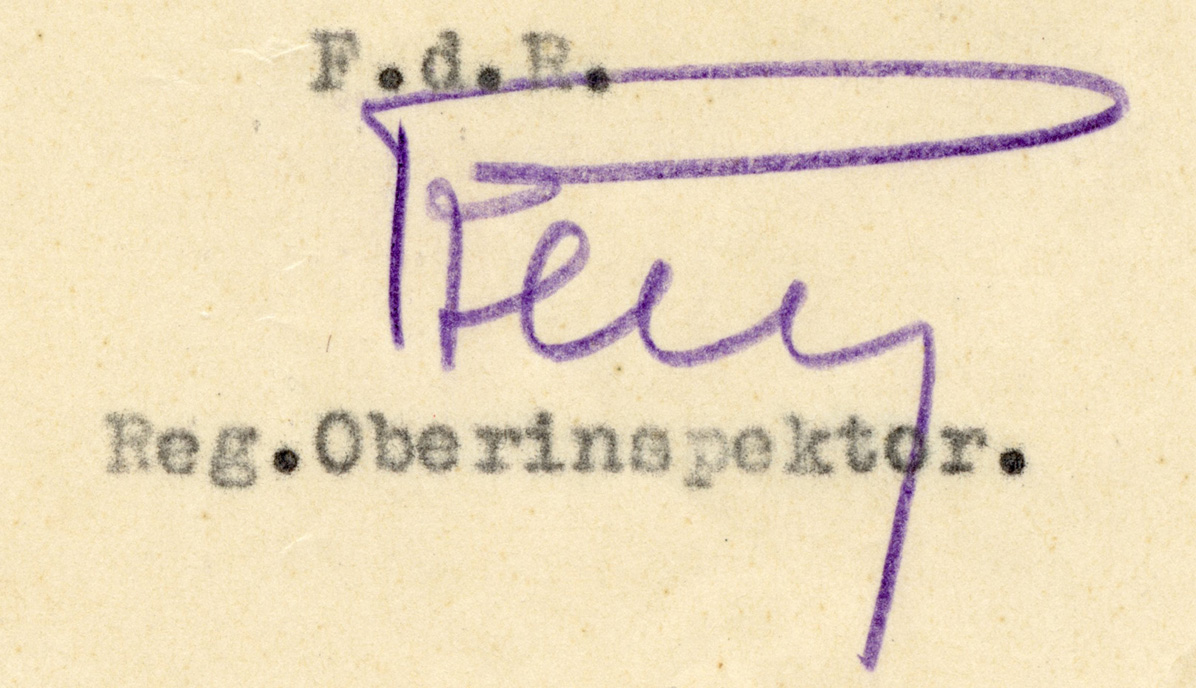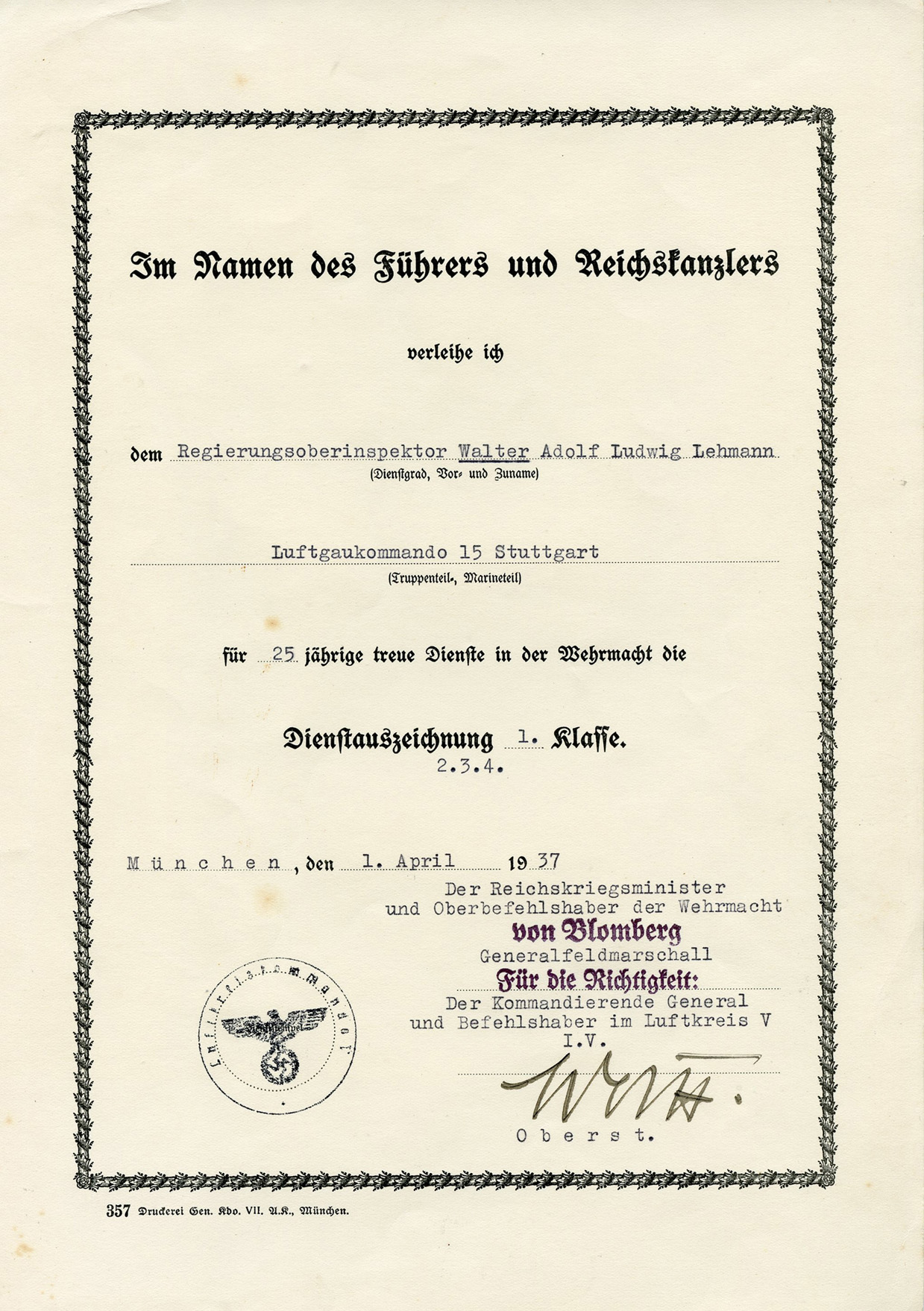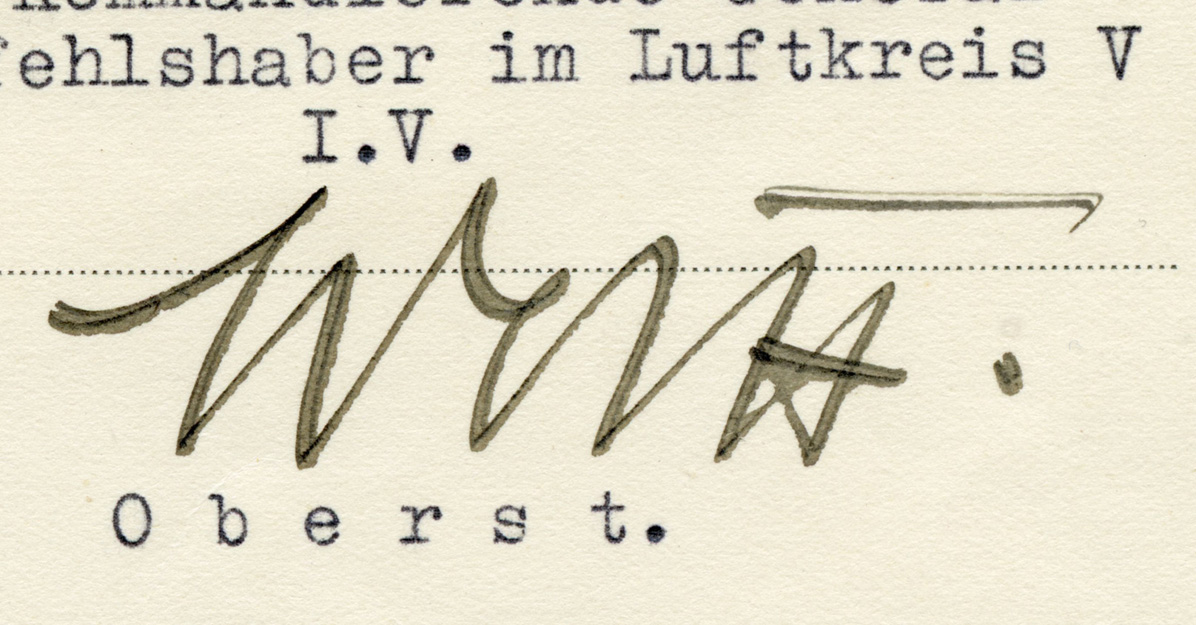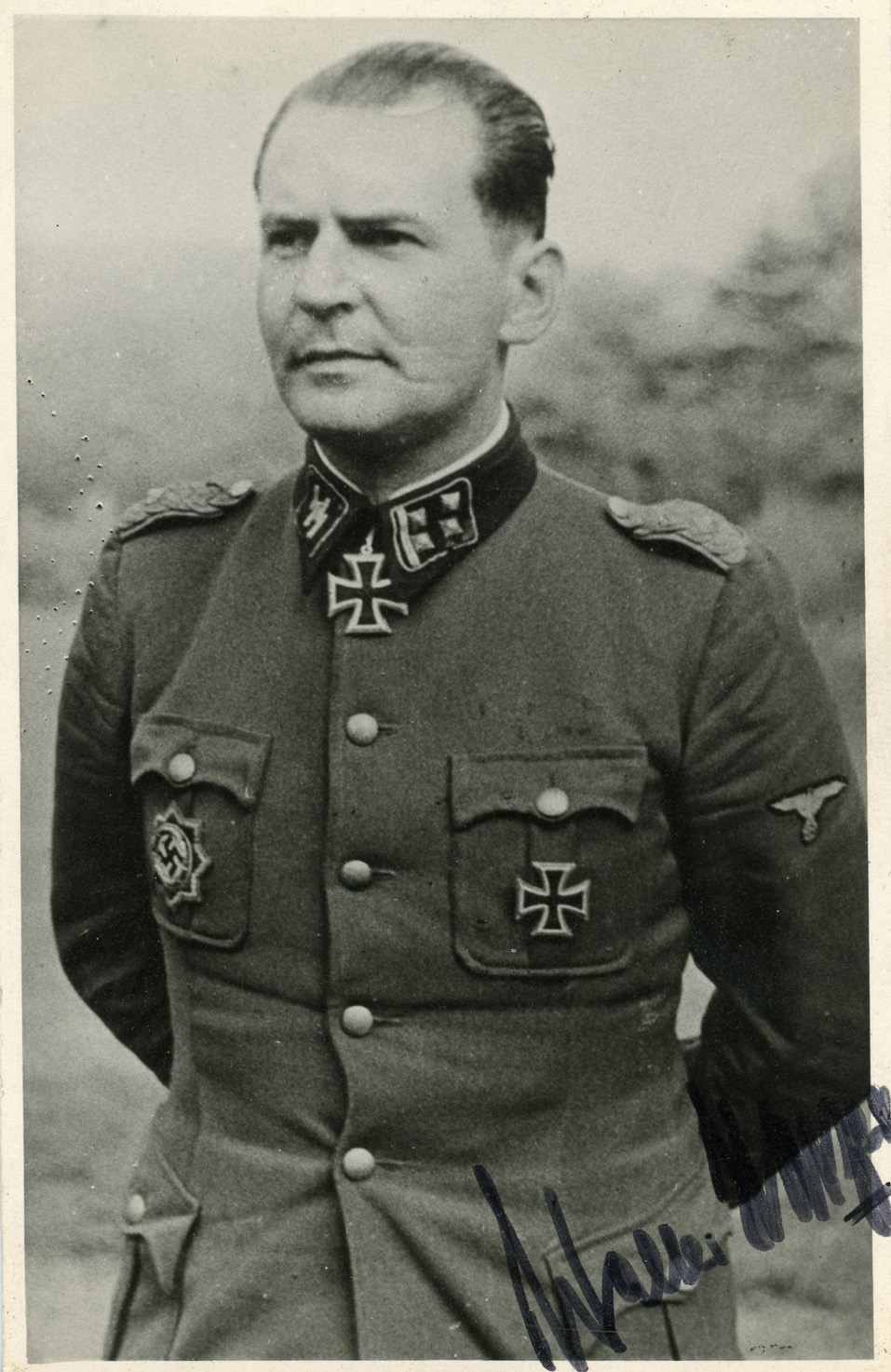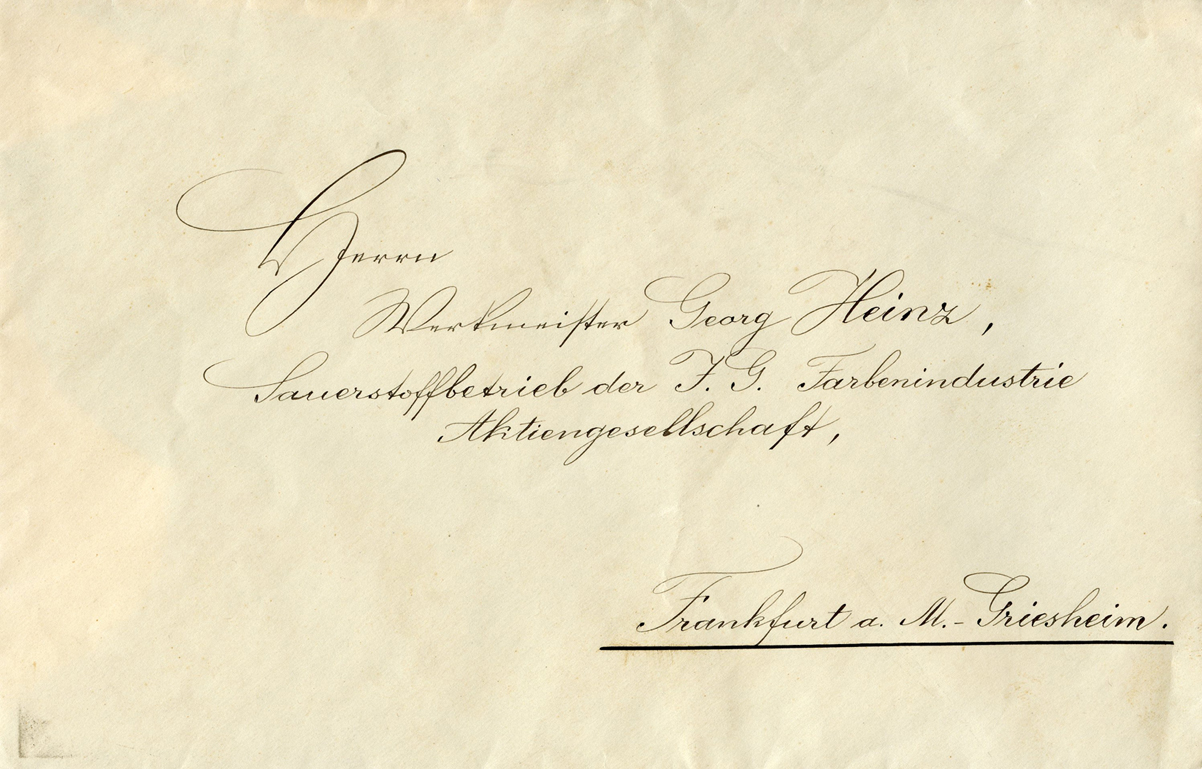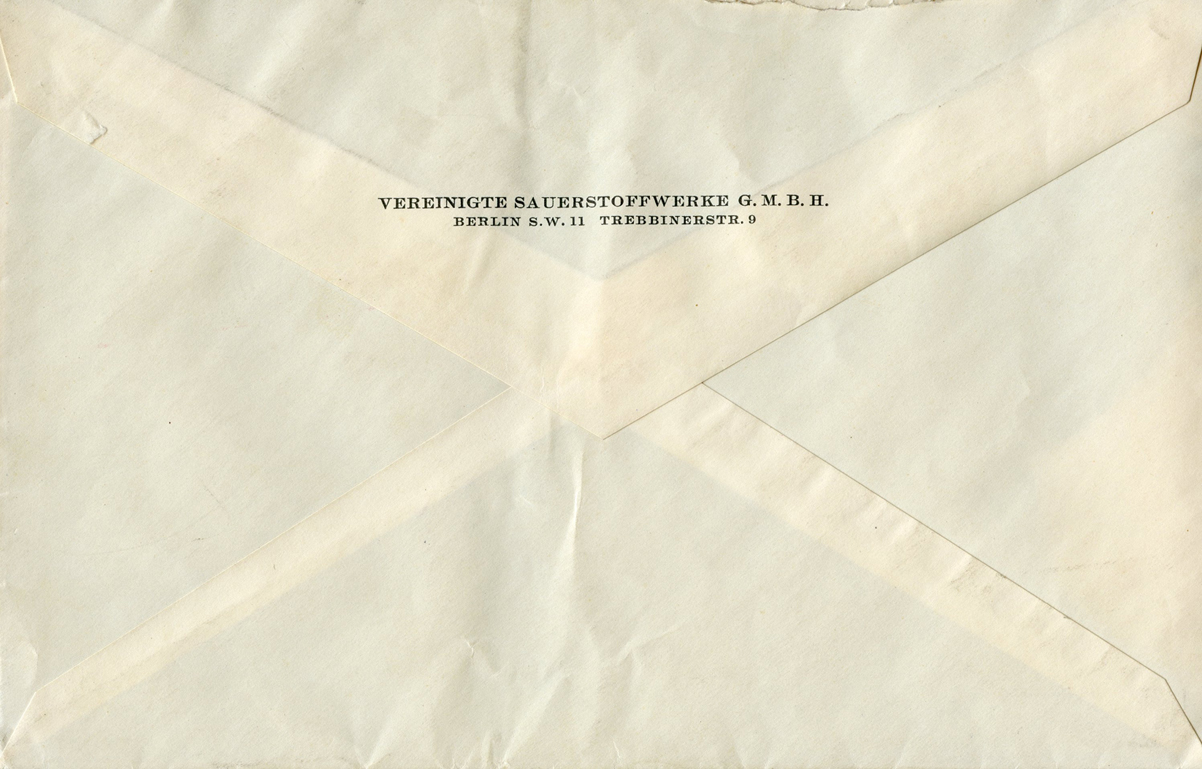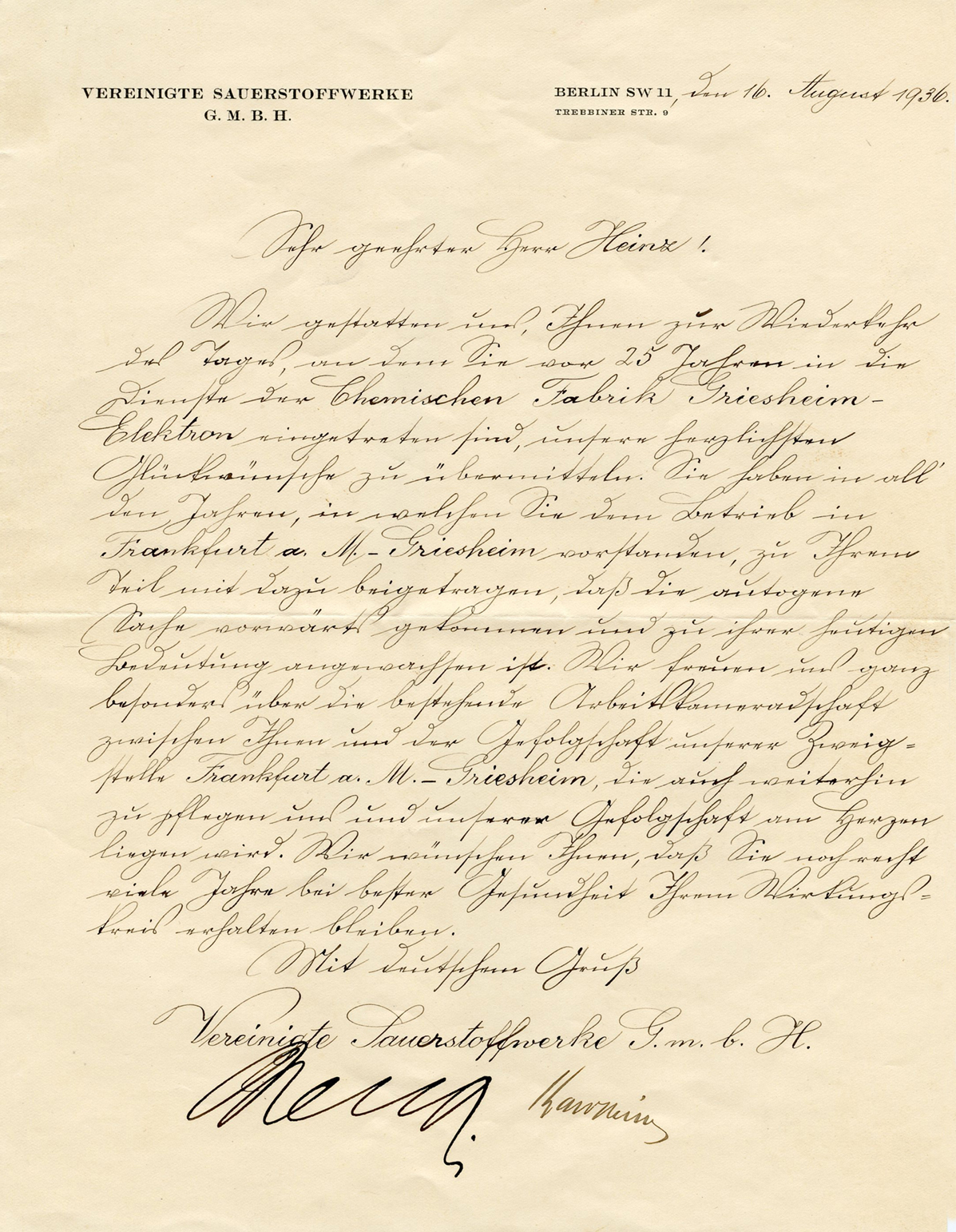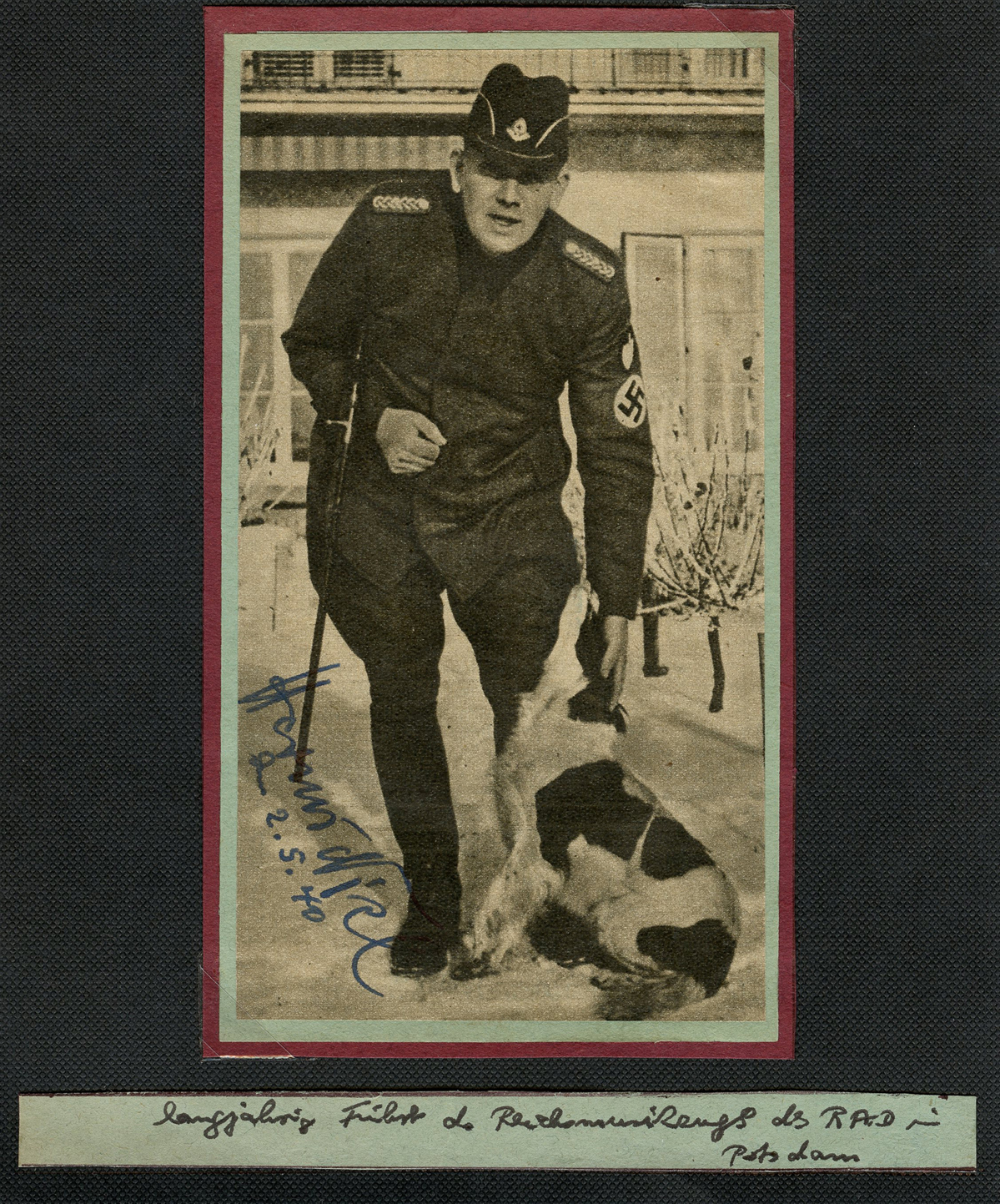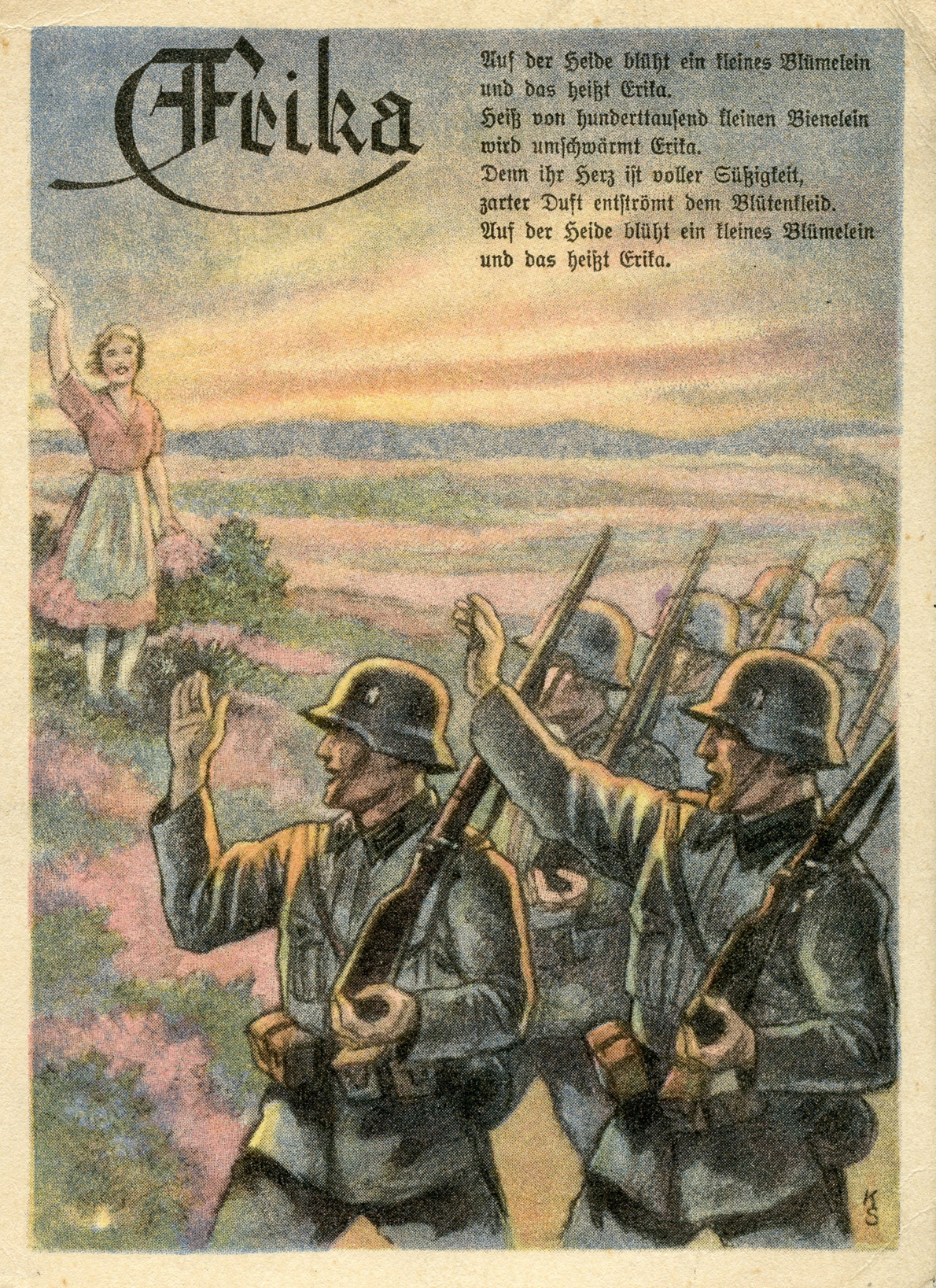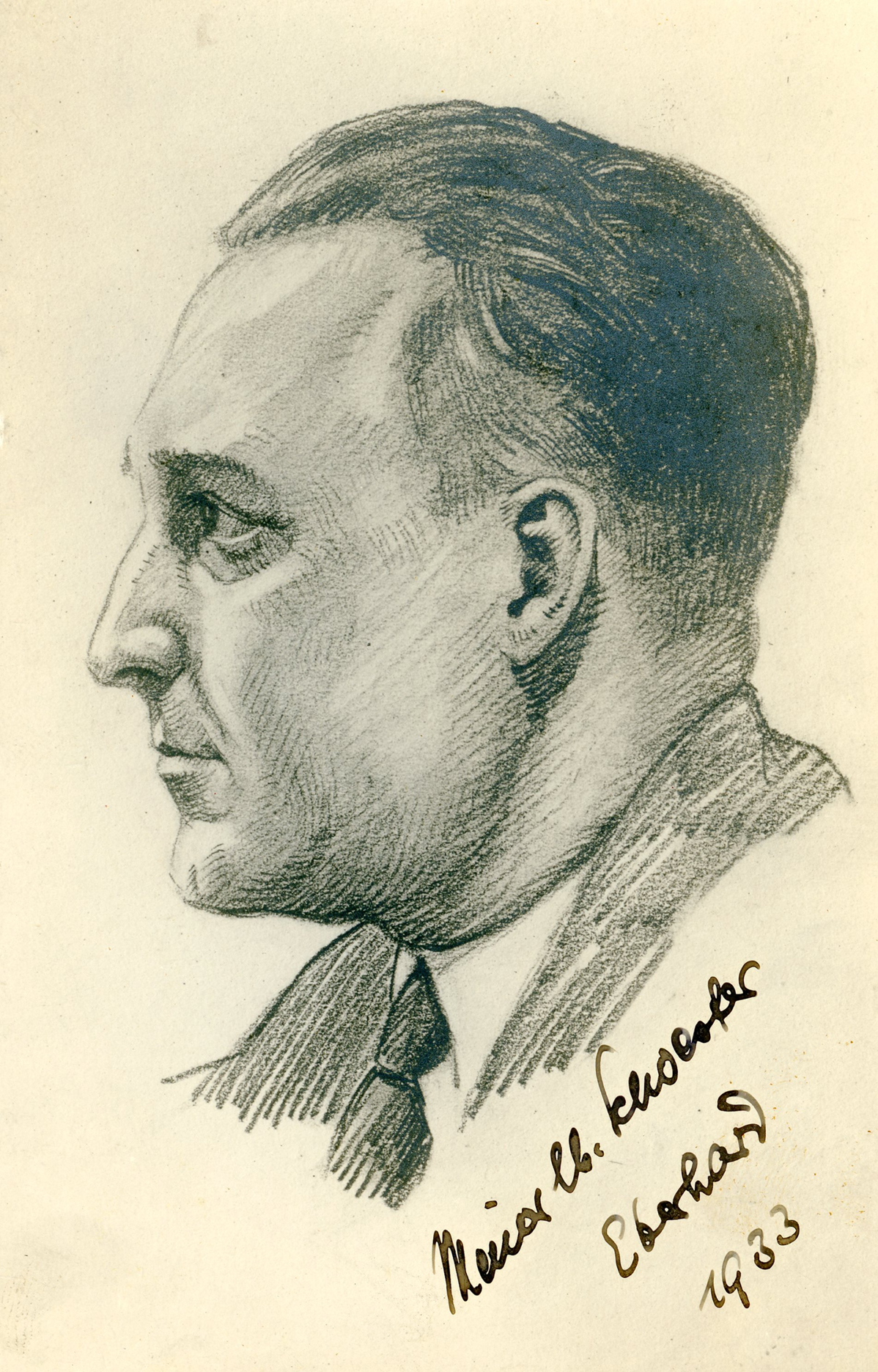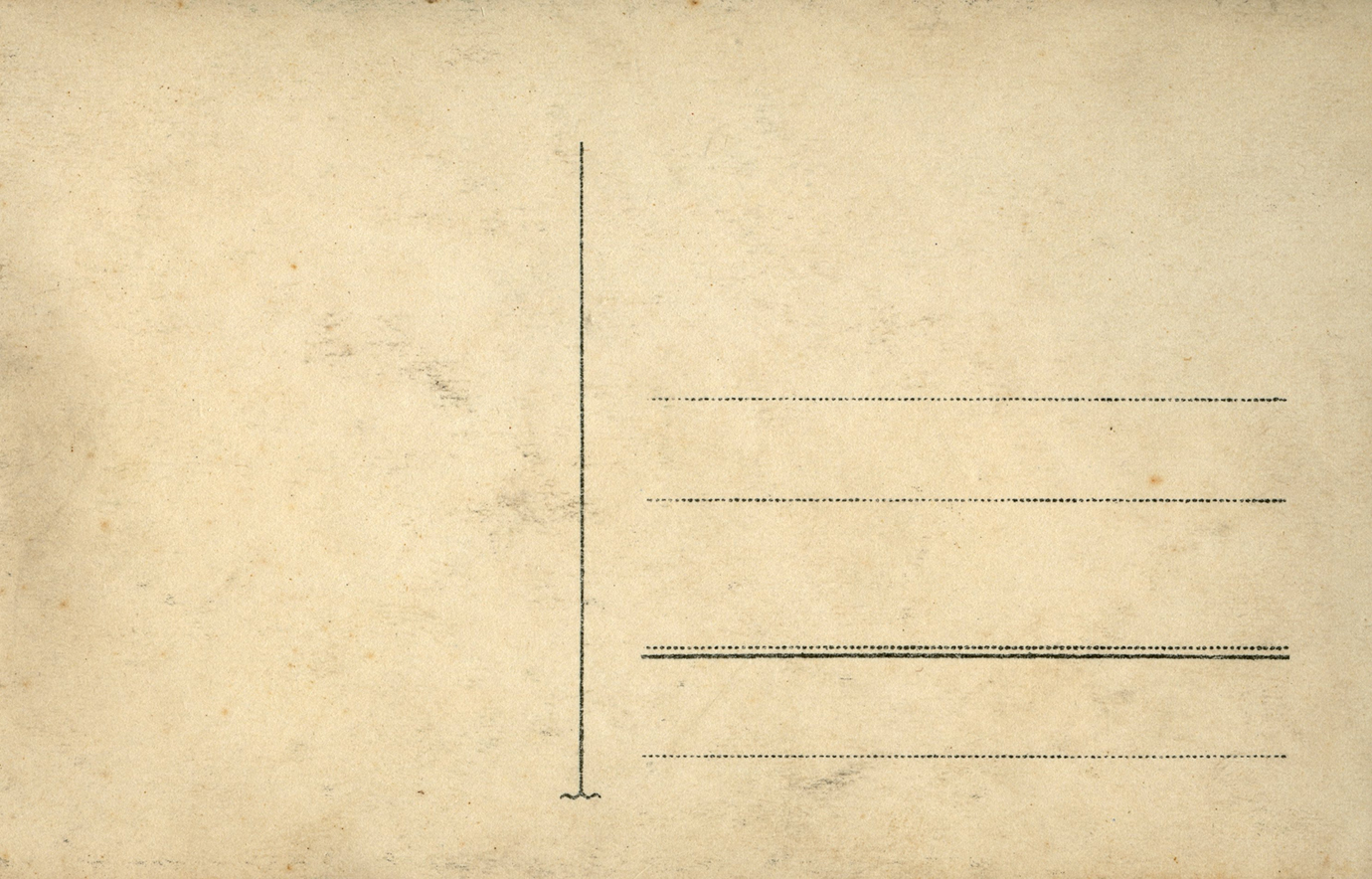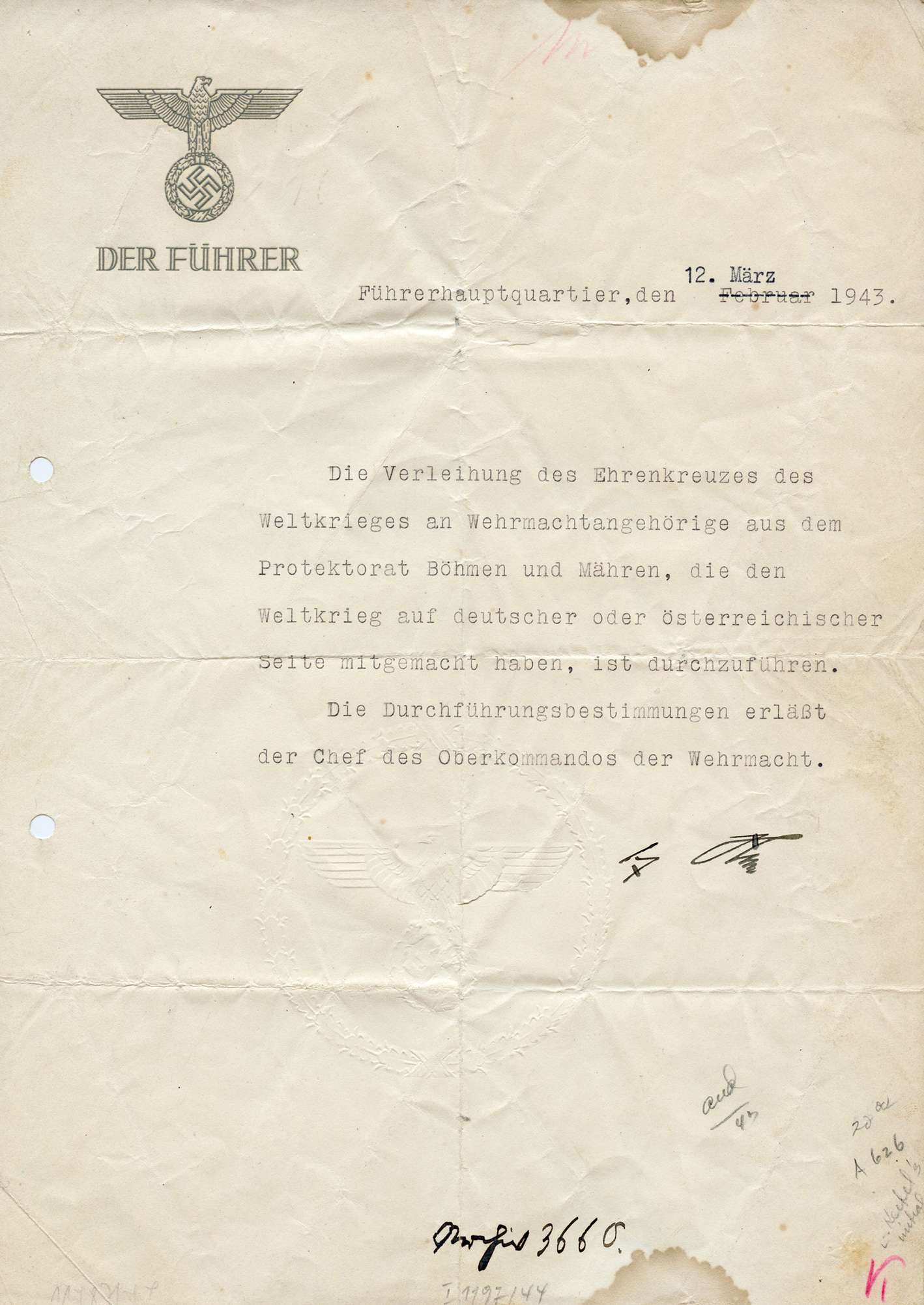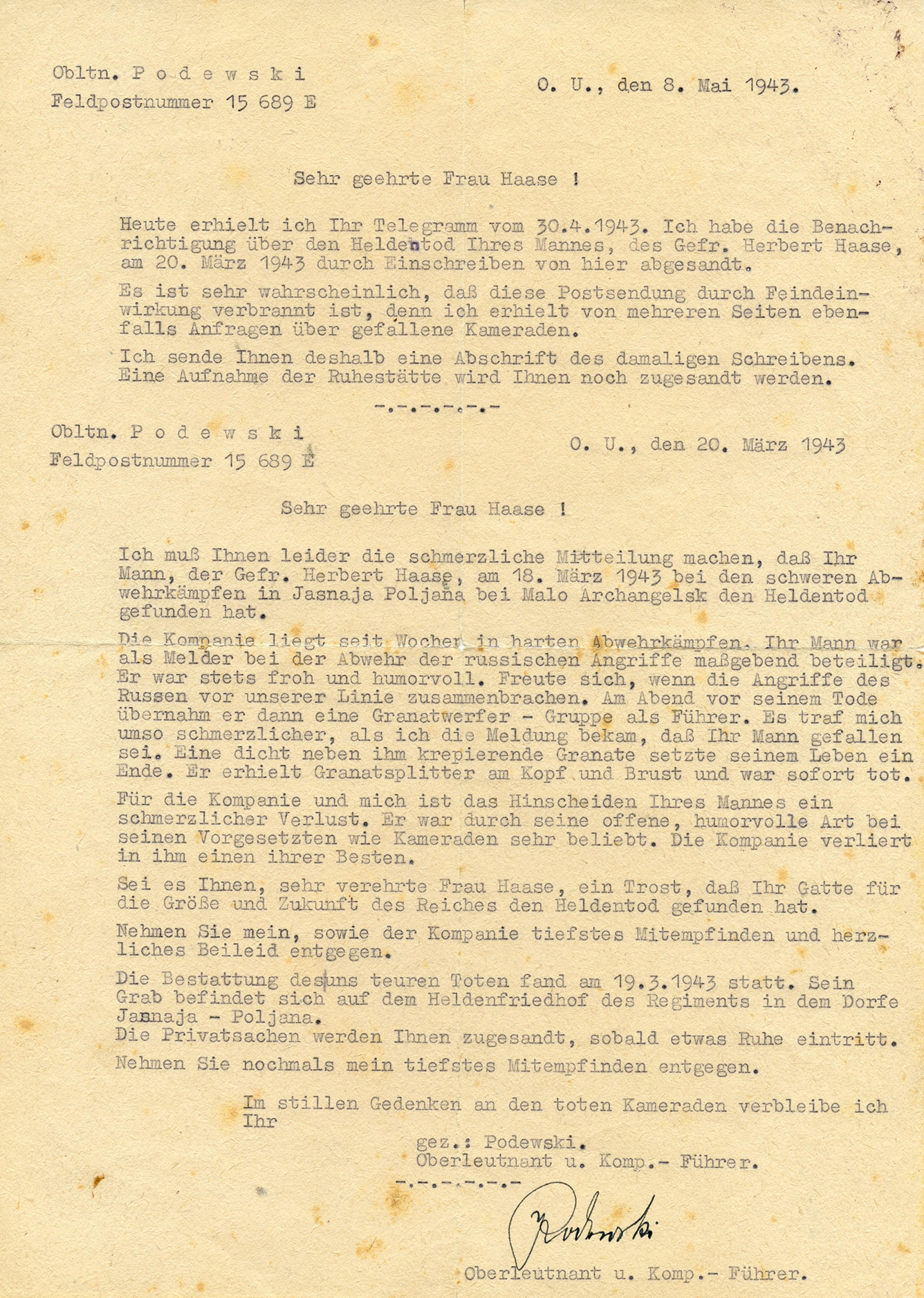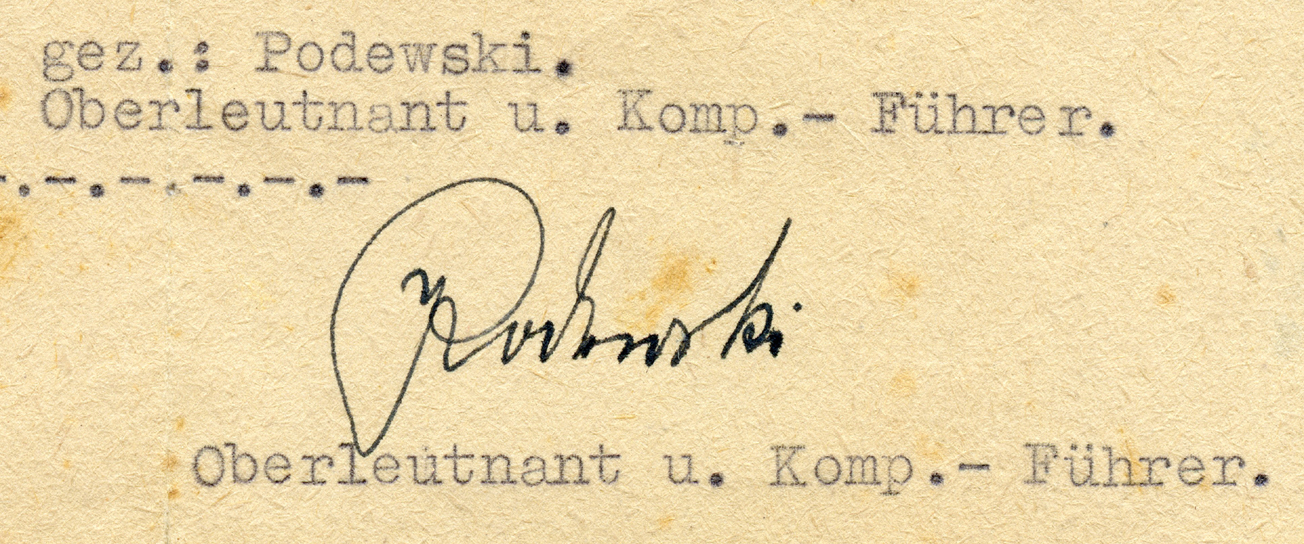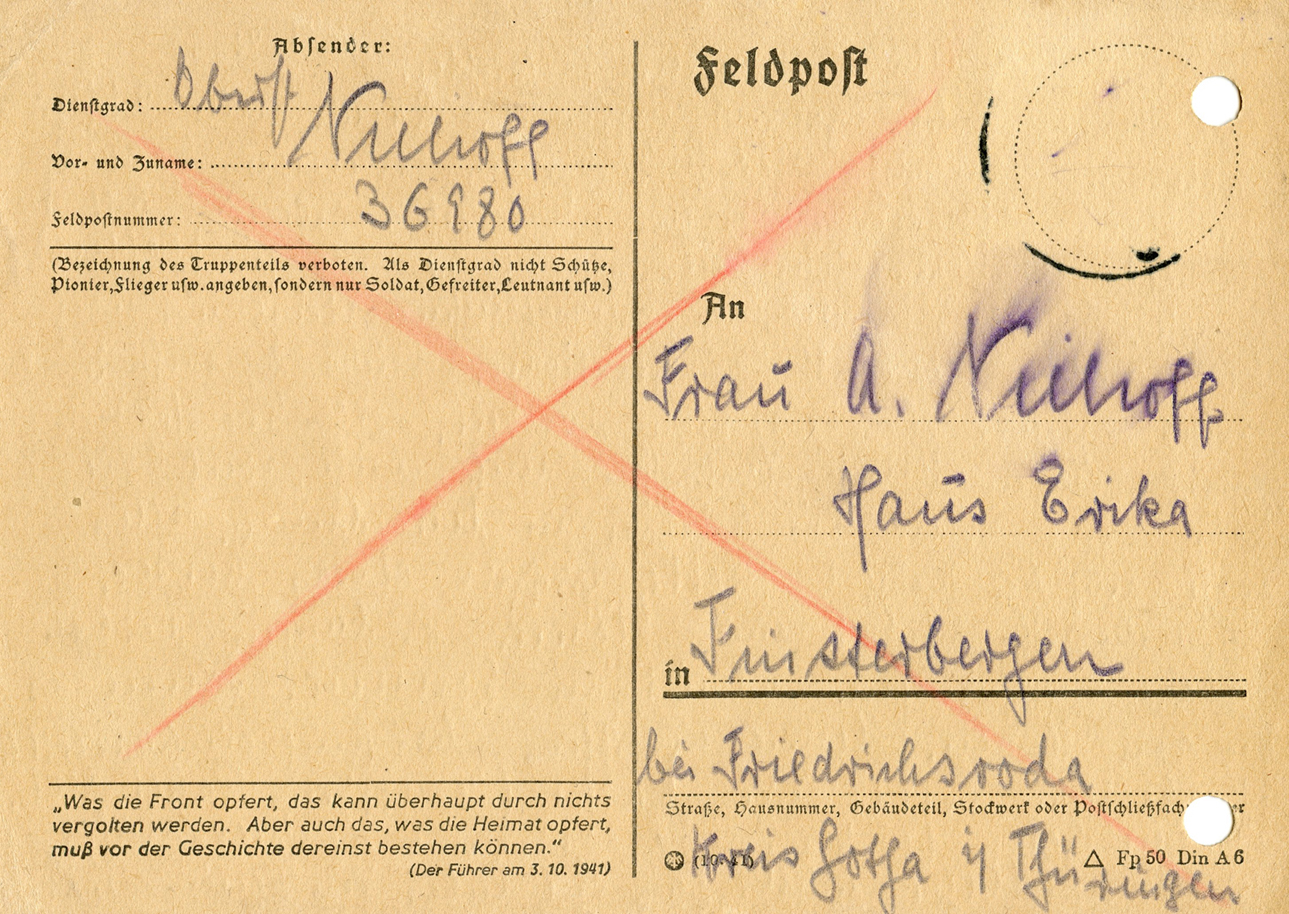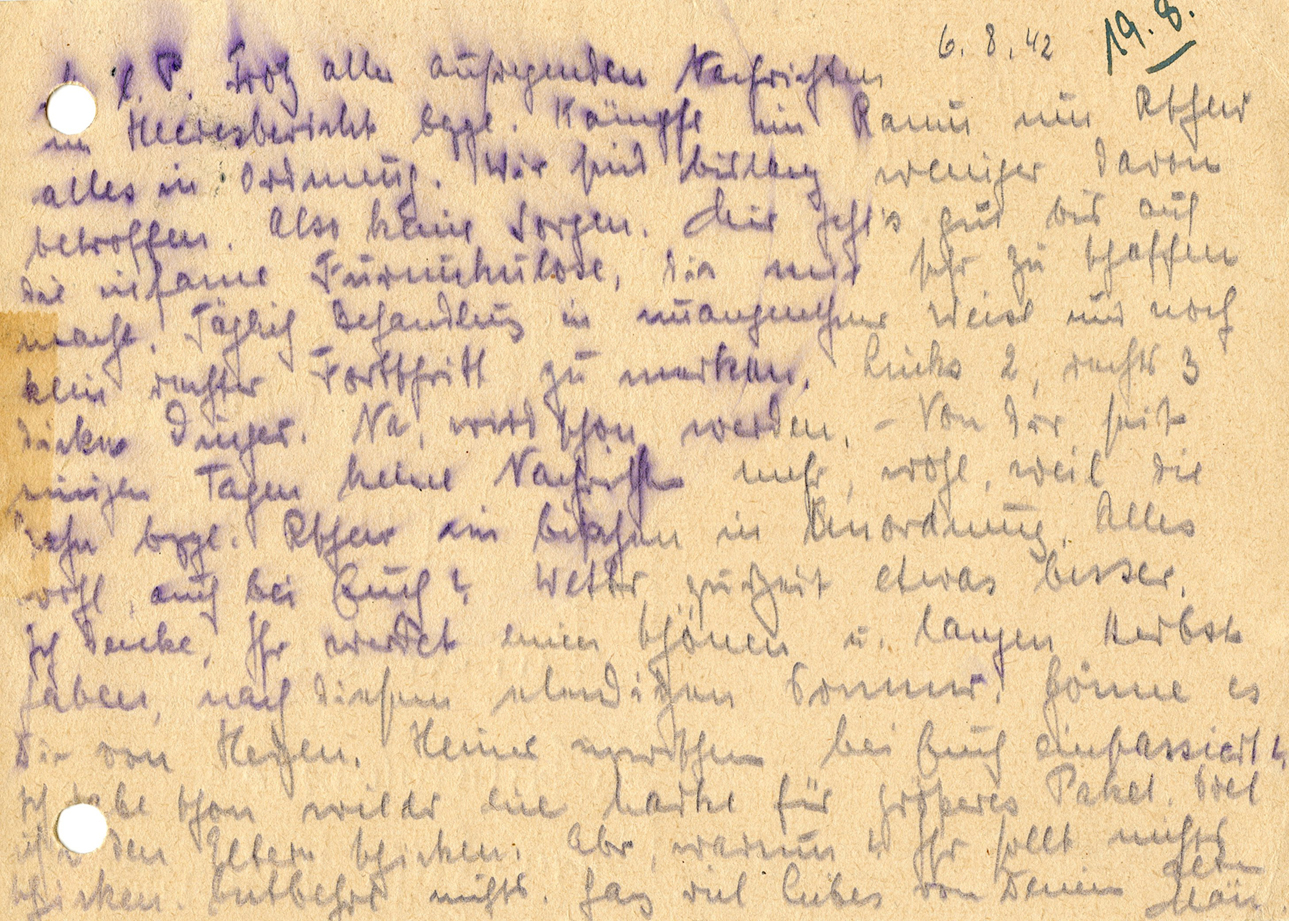
[Below: On this page I'll place paper items having to do with famous Third Reich personalities and places. Let's start with a Christmas card from Adolf Hilter: This is a beautiful card and everything you'd expect from the Führer. The eagle is an embossed, sparkling gold. It says:
'Berlin, den 24. Dezember 1937
Der Führer und Reichskanzler
übersendet hiermit
die besten Weihnachtswünsche'
(Berlin, December 24, 1937
The Führer and Reich Chancellor
hereby sends
the best Christmas wishes).]

[Below: Close-up. There is some age-related wear around the eagle.]


[Below: Another card from the Führer. Again the eagle is beautifully embossed, as are the gold letters beneath. It says:
'Der Führer und kanzler des Deutchen Reiches
bittet
Frau________
am ________ das Abendessen bei ihm einnehmen zu wollen.
Zeit:________
Anzug: Frack oder Uniform
Um Antwort wird gebeten
Adjutantur: Fernruf: A2 Flora 6841'
(The Führer and Chancellor of the German Reich
asks
Mrs.________
to have dinner with him at ________.
Time:________
Suit: tailcoat or uniform
Response is requested
Adjutantur: Long distance call: A2 Flora 6841).
Wow! Could you imagine turning down this dinner request? "Uh no, sorry I already have plans"]

[Below: Close-up.]


[Below: Here's an interesting letter from Adolf Hitler's office on old Brown House stationary. They've noted the new office change from Münich to Berlin. The new address is at the Reich Chancellery. The letter is from November 16, 1933, he was made Reich Chancellor January 30, 1933. On the left it says: 'Bei Rückfragen unbedingt anzugen', which just means 'If you have any questions, please contact'. On the right are the words 'Chirurgishe Klinik' in the recipient's address. This just means 'Surgical Clinic'. The note itself says:
'Sehr geehrter Herr Sickinger!
Der Führer läßt Ihnen für die ihm übersandte
Aufmerksamkeit seinen besten Dank aussprechen.
Mit deutchen Gruss!'
(Dear Mr. Sickinger!
The Führer sends you his best thanks for the attention
you have given him.
With German greetings!)
This is interesting. I wonder what a surgical clinic did for him?]

[Below: Close-up.]


[Below: Here is a heavy, textured paper thank you card from Adolf Hitler. Date unknown, but since it is from Berlin that tells us it is post-1933. It says:
'Adolf Hitler
Mit der mir übersandten Aufmerksamkeit haben Sie mir
eine Freude bereitet.
Ich spreche Ihnen meinen herzlichen Dank dafür aus.'
(Adolf Hitler
With the attention sent to me you have brought me
a pleasure.
I express my heartfelt thanks to you for it.)]
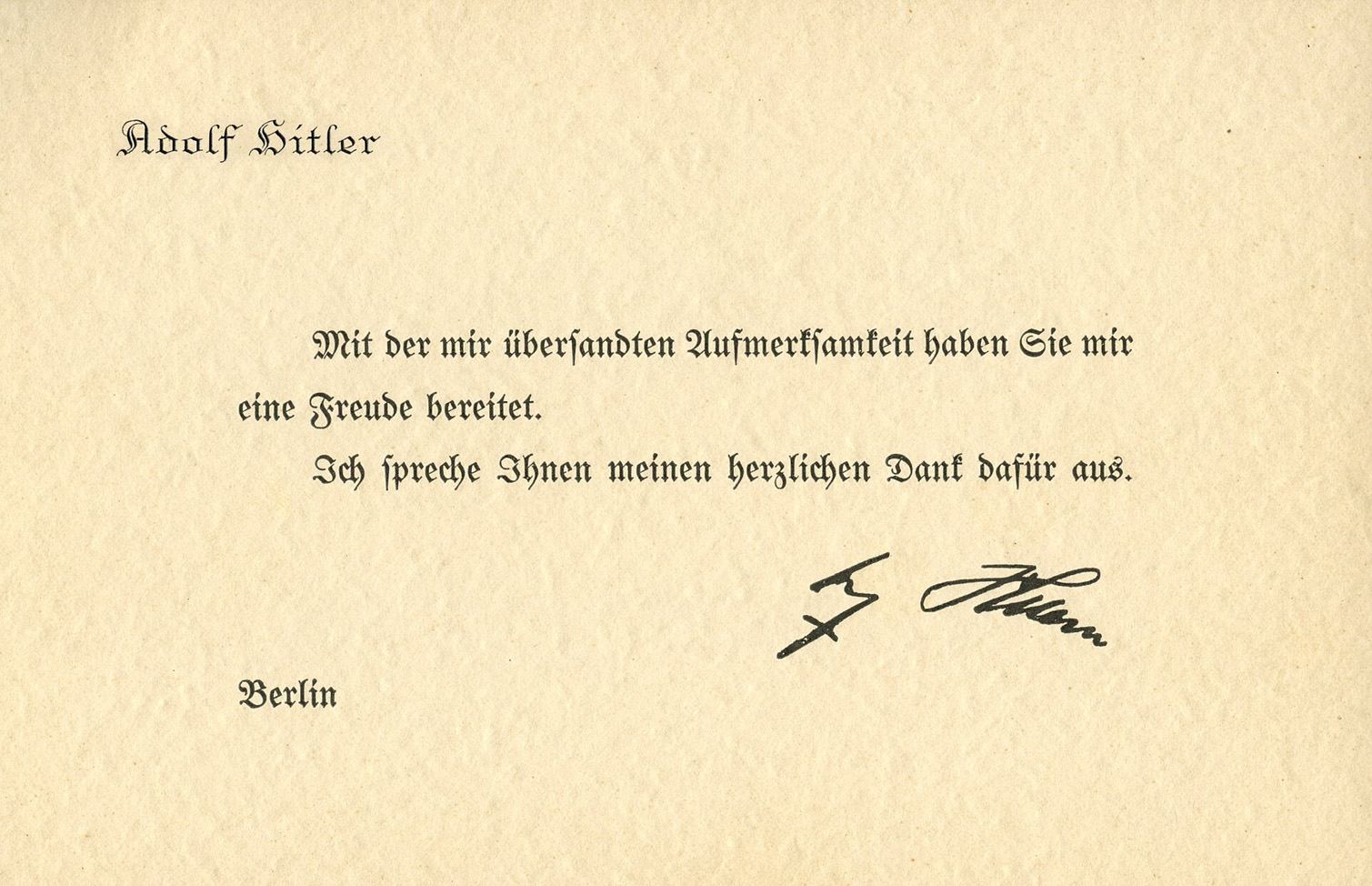

[Below: Here's another letter from the Führer's office in Berlin, date unknown. It is from the 'Reichshauptstellenleiter' (Reich Headquarters). It has an nice embossed eagle and says:
'Amt für Gnadensachen
Aktenzeichen:
Mit Schreiben vom _______ übersandte ich Ihnen zur
Beurteilung und zum Bericht das oben bezeichnete
Gnadengesuch. Eine Antwort liegt von Ihnen noch
nichte vor.
Das Gesuch muß nunmehr beschleuigt bearbeitet
werden. Ich erbitte daher umgehend Ihre Stellung-
nahme.
Reichshauptstellenleiter'
(Office for Clemency Matters
File number: _______
By letter dated _______ I sent you the following for your
information
for evaluation and report the above mentioned
application for clemency. A reply from you is still pending
not yet received.
The application must now be processed in an uncertain manner. I
therefore request your attention immediately.)]

[Below: Close-up.]


[Below: Here's another letter from the Führer's office in Berlin, but unlike the half-sheet above this is a full sheet.
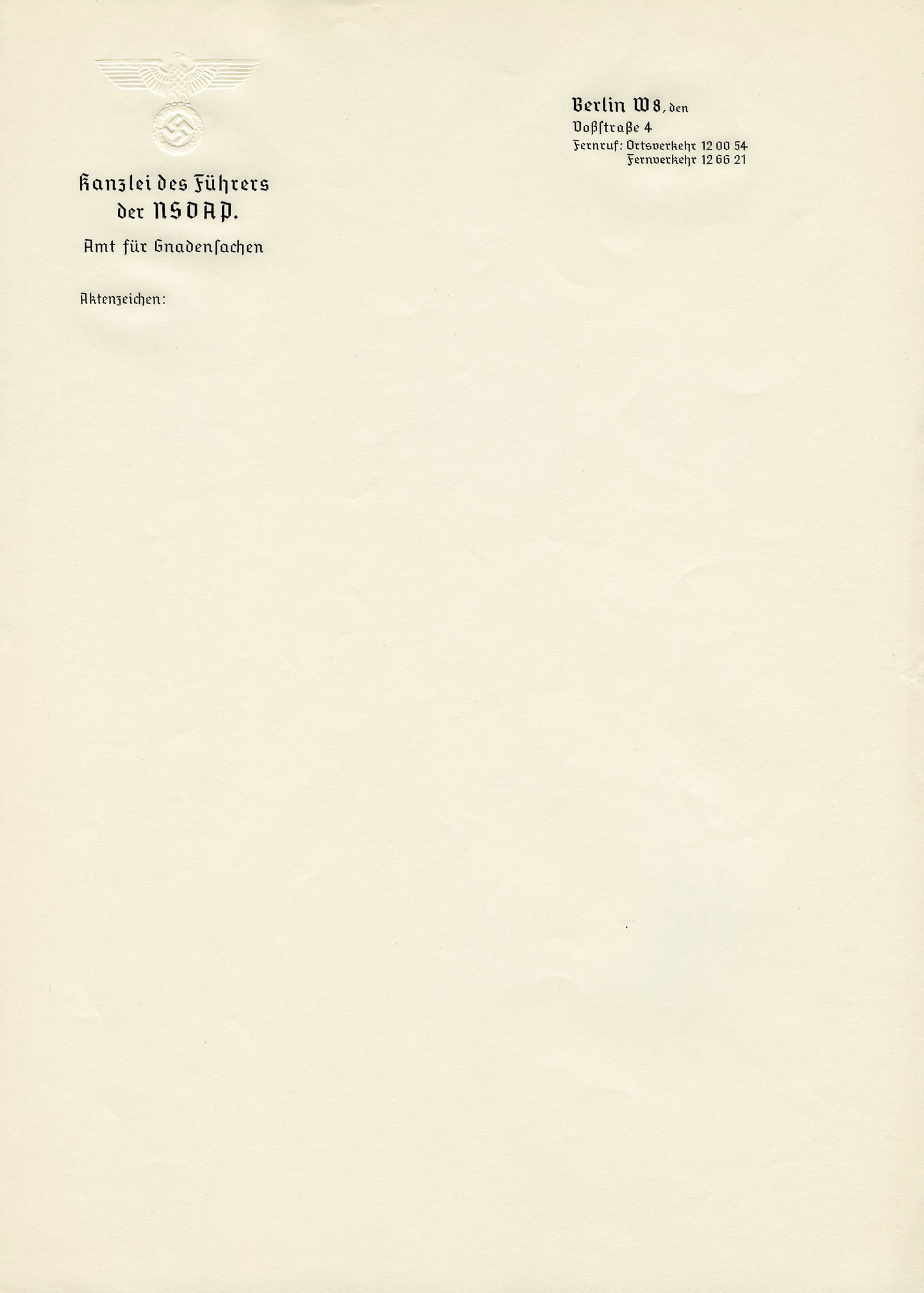
[Below: Close-up.]
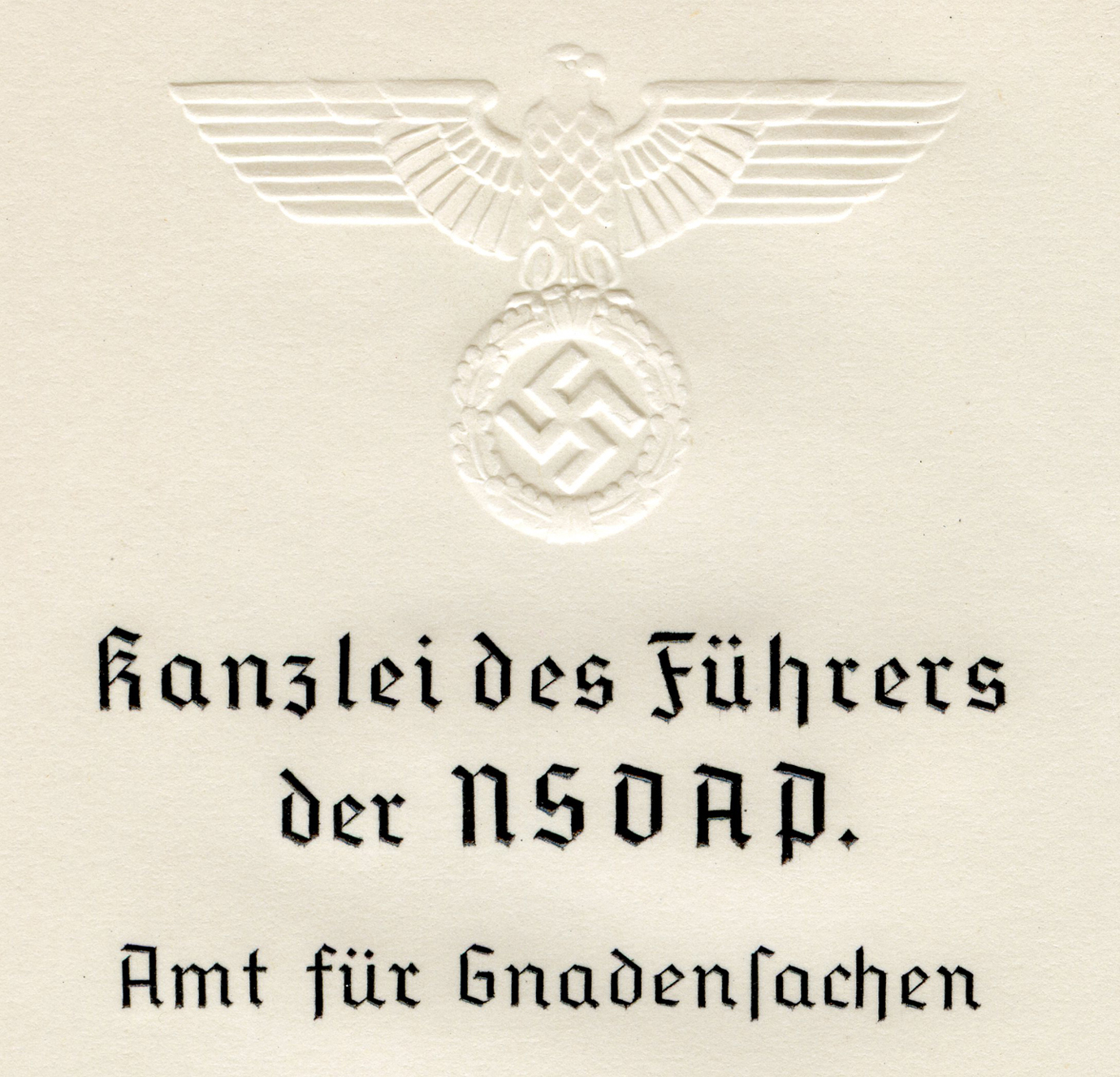

[Below: Here's another letter from the Führer's office in the 'Kanzlei des führers der NSDAP' (Chancellery of the leader of the NSDAP), postmarked on January 24, 1940.]
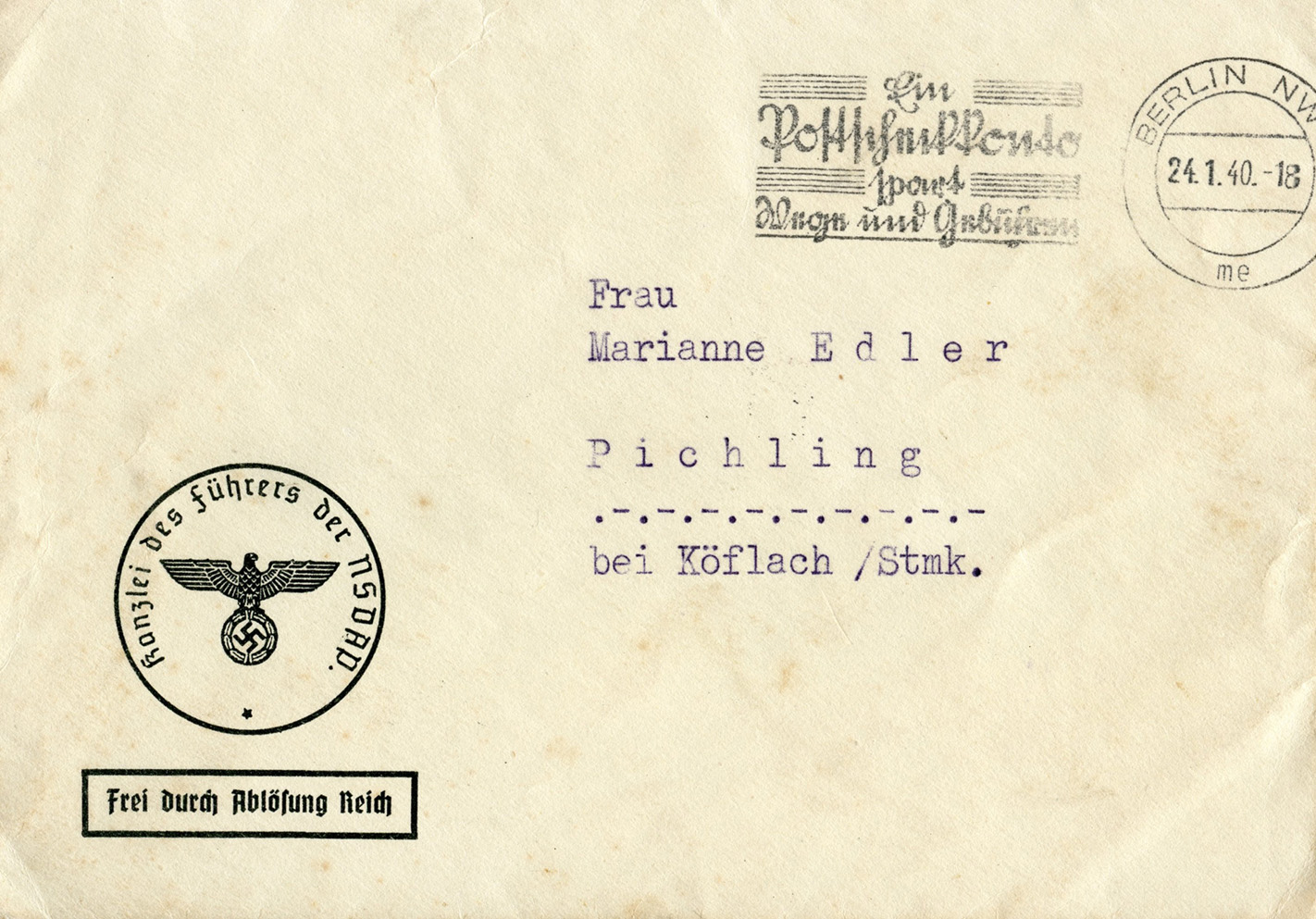
[Below: Close-up of seal.]
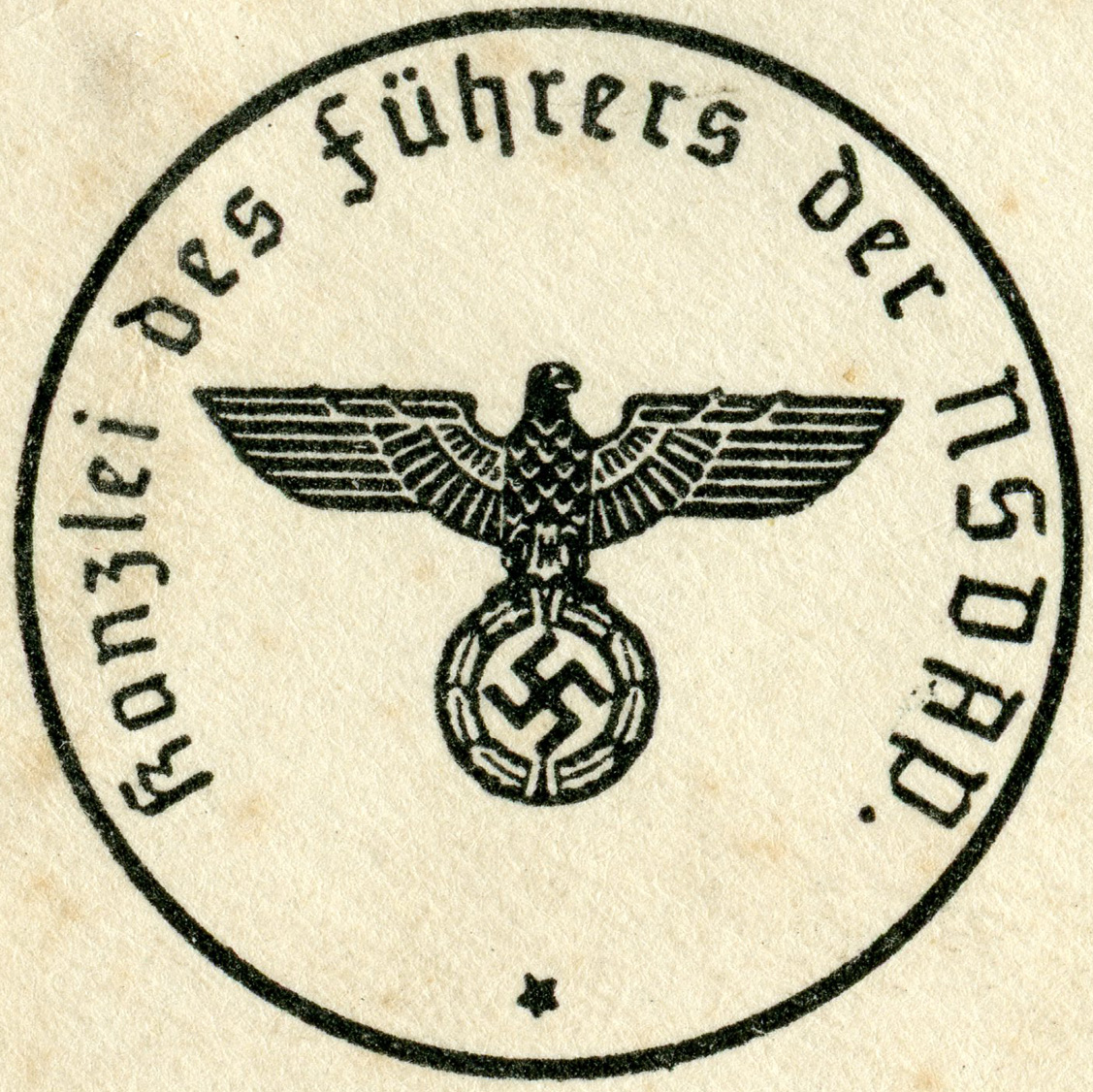
[Below: Reverse of envelope.]
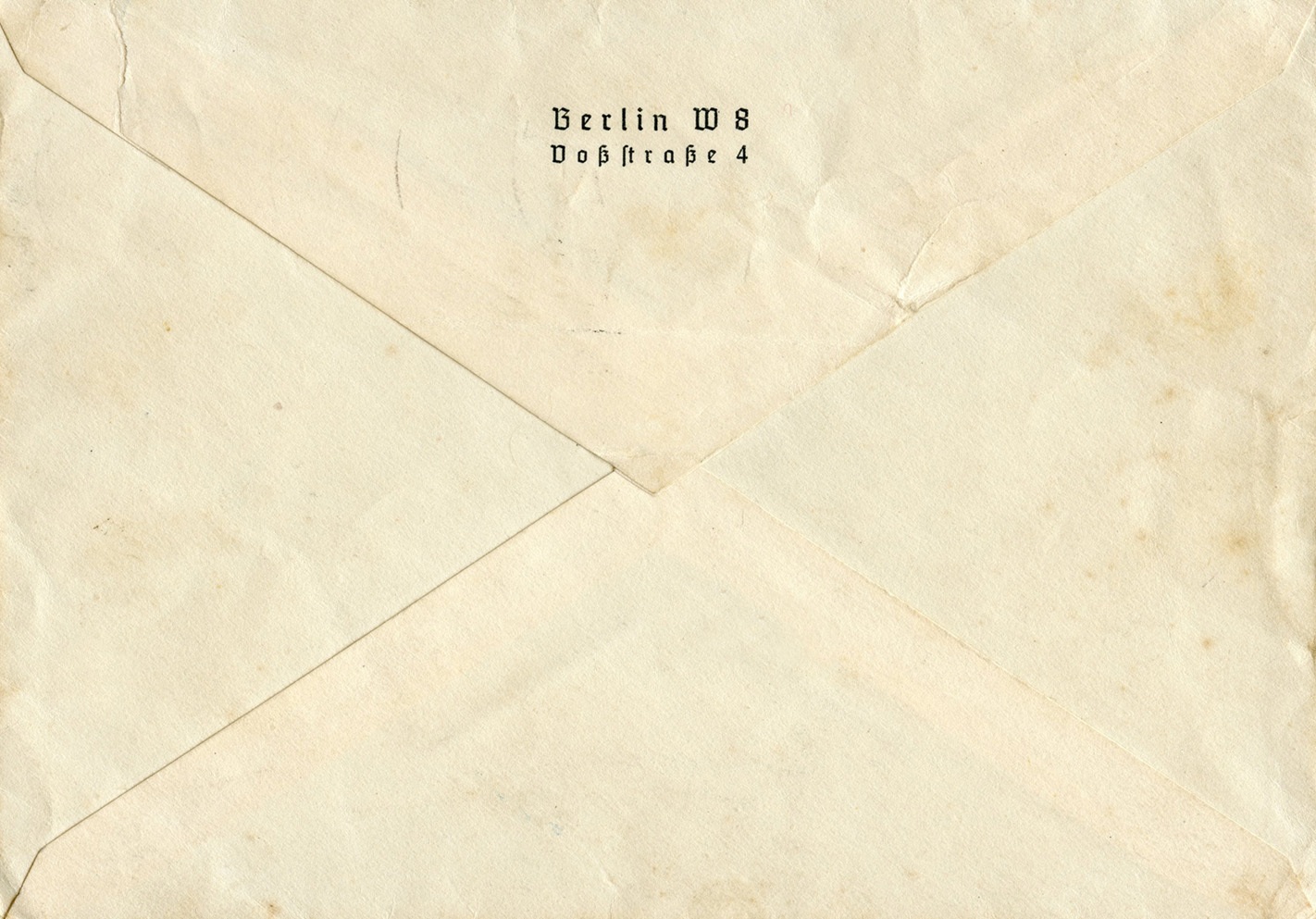
[Below: Letter within. It says:
'Der Eingang Ihres Schreibens vom 13.1.40 wird bestätigt.
Ihre Eingabe wurde heute nach Kenntnisnahme aus Gründen der Zuständigkeit an untenstehende Dienststelle abgegeben. Eine Bearbeitung wird dort in die Wege geleitet.
Ich bitte Sie, weitere Schreiben in dieser Angelegenheit unmittelbar dorthin zu riechten.'
(Receipt of your letter dated January 13, 1940 is acknowledged.
Your submission was forwarded today to the office below for reasons of jurisdiction. Processing will begin there.
I request that you direct any further correspondence regarding this matter to that office directly.)]
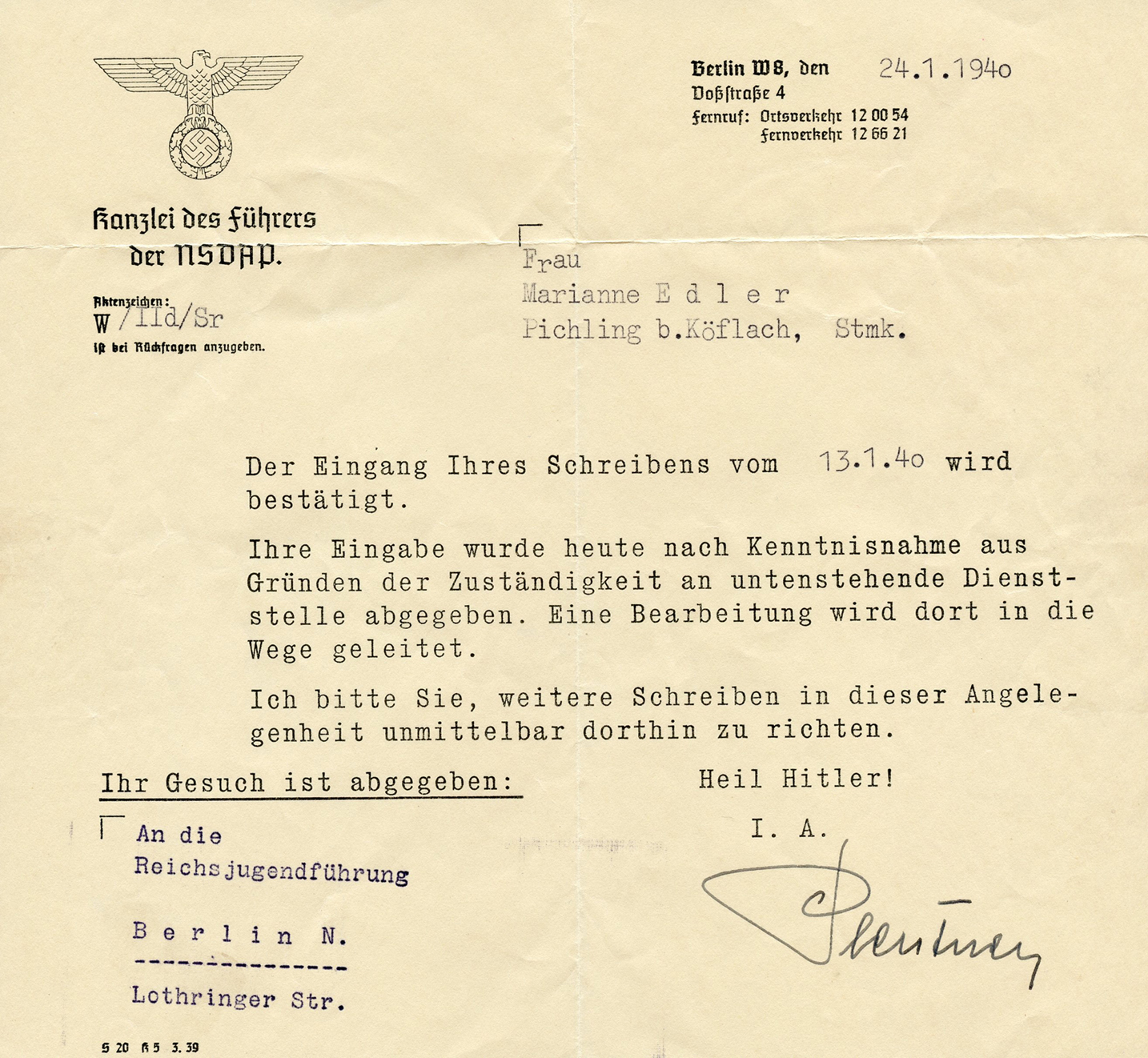
[Below: Close-up.]


[Below: Here is an envelope similar to that above, but brown.]
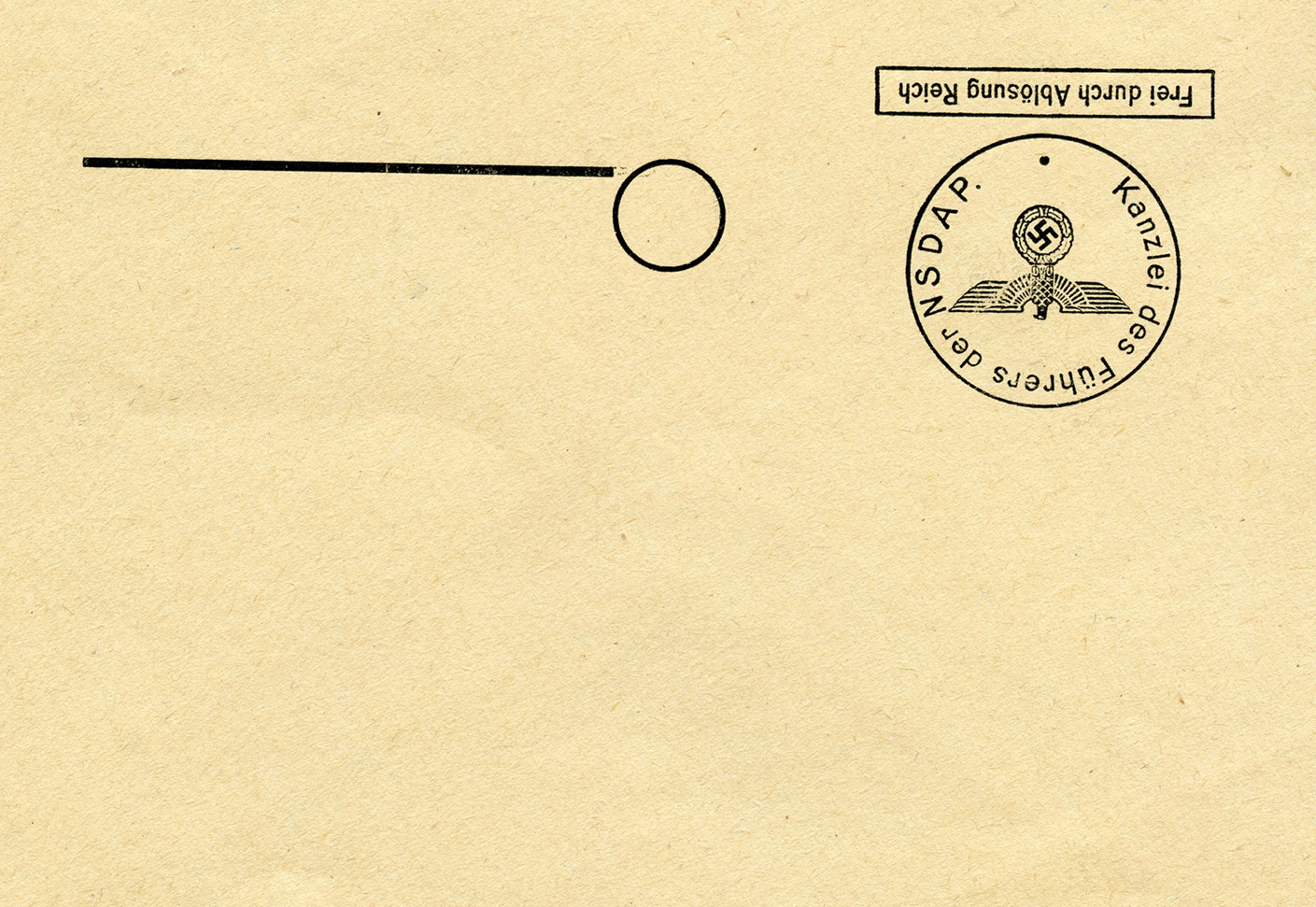
[Below: Reverse.]
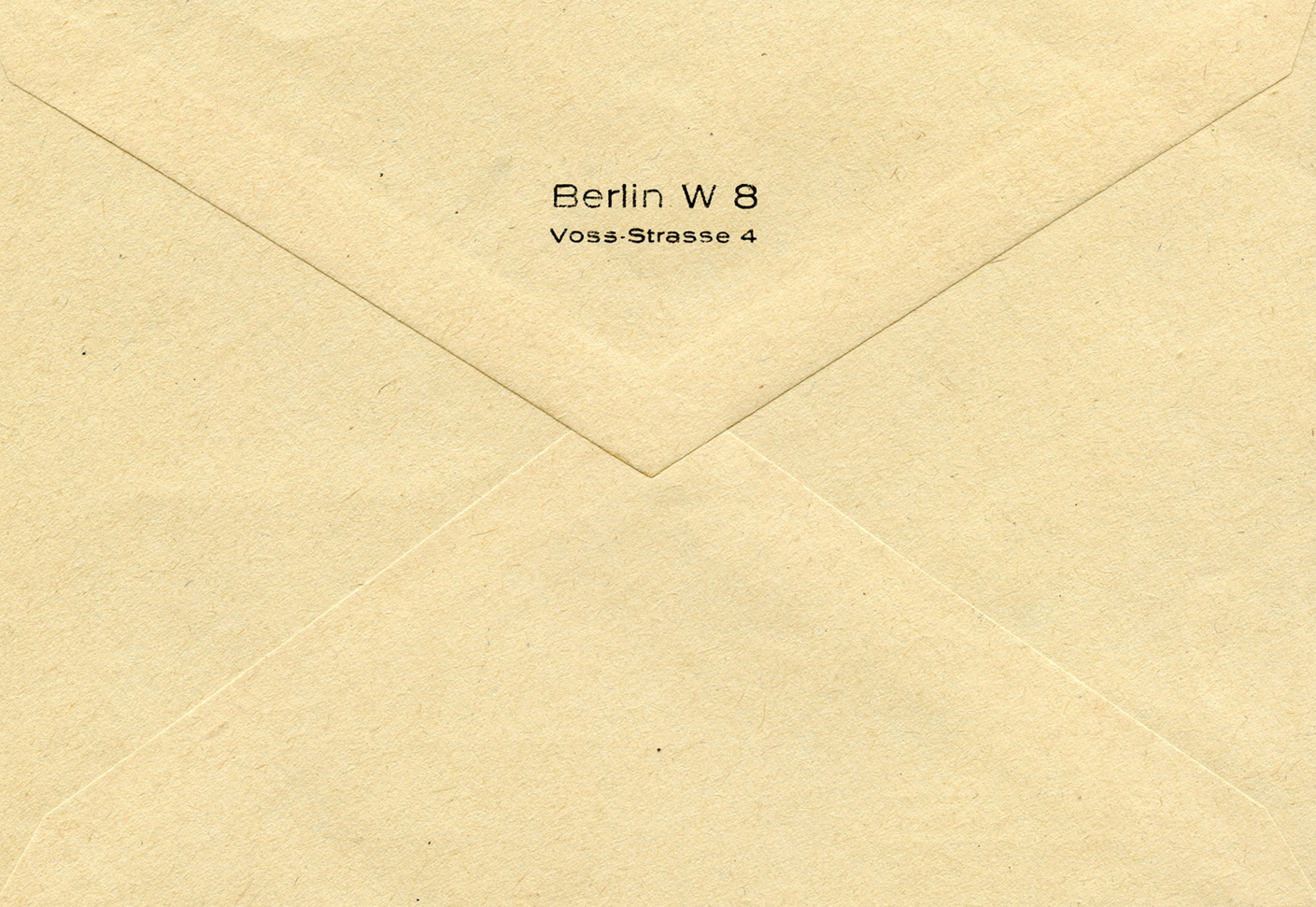
[Below: Close-up of seal.]
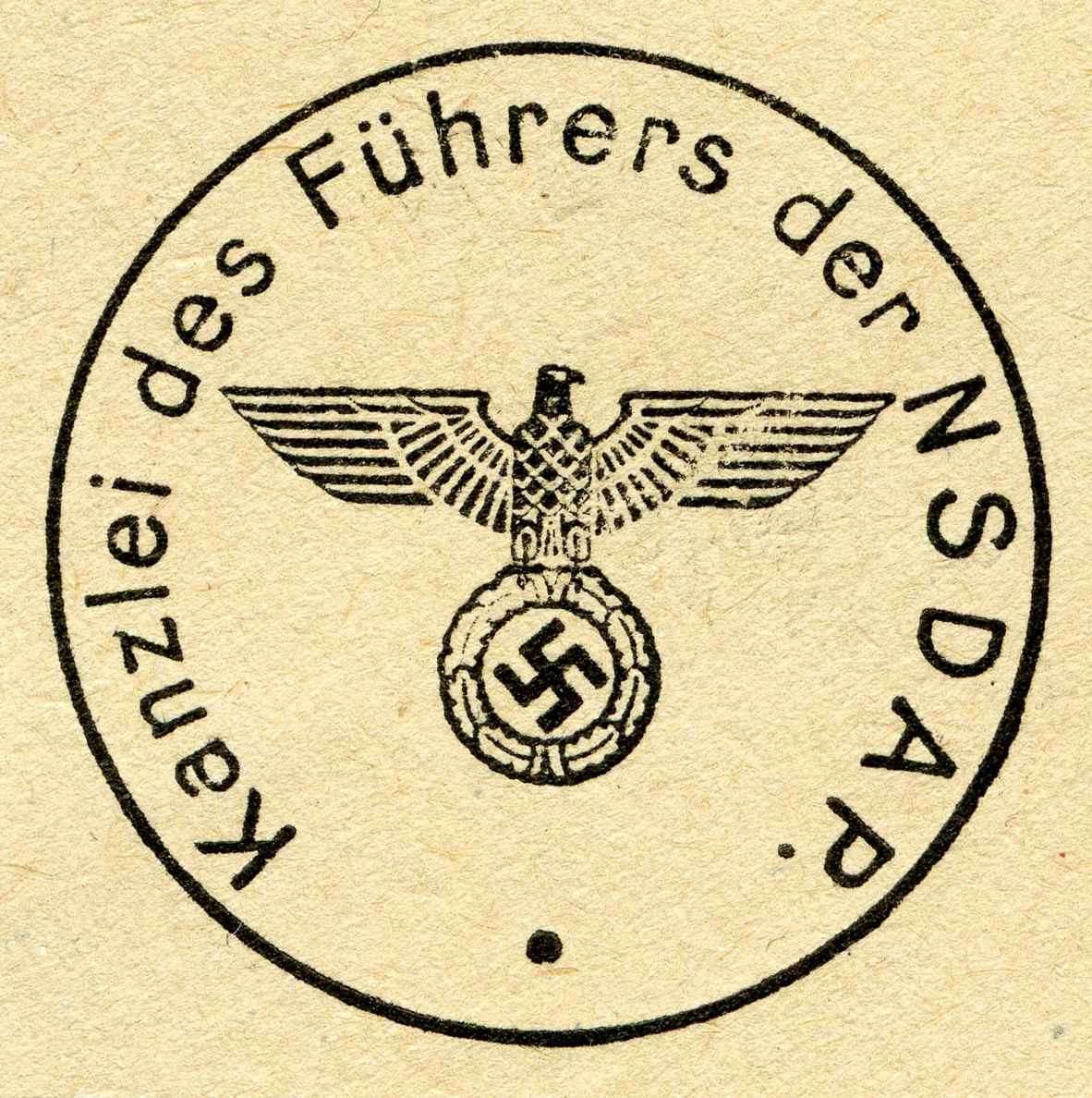

[Below: The Führer's mountain retreat - the Berghof. This postcard was sent on August 30, 1942.]

[Below: Postcard reverse. Here's what makes this postcard extra special, it is from the Platterhof Hotel. This historic hotel was near the Berghof and often served as a place for visitors and dignitaries to stay while visiting Adolf Hitler. Following the official Allied plan to destroy civilian property, even over military targets, the hotel was badly damaged during the war. After the war the American invaders renovated it and made it into a recreation center for American soldiers. No doubt they did all of this as an attempted smug insult to National Socialism and the German people. Incredibly, the Americans would occupy the hotel until 1995! FIFTY years! The German government then tore it down in 2000 in their "oh so typical destroy everything Nazi" style. During this destruction of history it was looted of anything of value, allegedly by the very demolition crews hired by the German government. The hotel site has now been turned into a parking lot. Vengeful, jealous, childish Allies.]


[Below: Official stationary from the historic Führerbau in Munich. Unfortunately there is no date.]

[Below: Close-up.]

[Below: Inside of letter.]

[Below: Letter reverse.]

[Below: The Führerbau draped in the flags of those attending the negotiations.]

[Below: The Führerbau during negotiations. At the table are: (from left) Benito Mussolini, Adolf Hitler, Paul Otto Schmidt (German interpreter) and Neville Chamberlain. The Munich Agreement was signed and Germany was officially given back the Sudetenland, which was stolen from Germany after WWI in the insanely unfair Versailles Treaty. This agreement was concluded on September 30, 1938.]

[Below: The Führerbau with Adolf Hitler and Benito Mussolini on the balcony.]


[Below: A beautiful invitation from 'Ministerpräsident Generalfeldmarschall Göring' with an embossed eagle. This asks that the person come to his home 'Carinhall'.]


[Below: Here's an envelope from November 23, 1933 to Hermann Göring in Berlin. This was during his tenure as Prime Minister of Prussia. It is interesting that this is sent from 'Altjudenhof' which means 'Old Jewish Court'. It's always remarkable to me when stuff like this survives. Like who saved this? How and why was it saved?]


[Below: This odd postcard says:
'Der Reichsmarschall
des Großdeutschen Reiches
Chef des Ministeramtes
Ihr Schreiben vom ___________ ist aus
Gründen der Zuständigkeit an das Amt Z.A.- R. des Reichs-
luftfahrtministeriums, Berlin W 8, Leipziger Straße 7, weiter-
geleitet worden.'
(The Reich Marshal
of the Greater German Reich
Chief of the Minister's Office
Your letter of ___________ for
reasons of competence to the Z.A.- R. office of the Reich-
Aviation Ministry, Berlin W 8, Leipziger Strasse 7.
has been forwarded.)
The rather strange part is the tiny Luftwaffe eagle on the lower left side.]

[Below: Close-up]

[Below: Postcard reverse.]


[Below: This invitation has the most beautiful embossed eagle I've ever seen! Seriously, this picture does it no justice. Wow. This says:
'Ministerpräsident und Reichsminister der Luftfahrt
General Göring
Beehrt Sich
Anläklich Seiner Vermählung mit Frau StaatsSchauspielerin Emmy
Sonnemann
Herrn und Frau Zapp
zur Festvorstellung "Die ägyptische Helena" von Richard Strauss
am Dienstag, den 9. April, 20 Uhr in die Staatsoper Unter den
Linden einsuladen.'
(Prime Minister and Reich Minister of Aviation
General Goering
Honored
On the Occasion of His Marriage to the State Actress Emmy
Sonnemann
Mr. and Mrs. Zapp
to the festive performance of "The Egyptian Helen" by Richard Strauss
on Tuesday, April 9, at 8 p.m. at the State Opera House Unter
den Linden.)]

[Below: Eagle close-up.]


[Below: Here is a sheet of paper with Göring's letterhead when he was commisioner of the Four Year Plan. It says:
'Der Reichsmarschall des Großdeutschen Reiches Beauftragter für den Vierjahresplan'
(The Reich Marshal of the Greater German Reich
Commissioner for the Four-Year Plan)
The Four Year Plan was primarily to provide for the rearmament of Germany and prepare the country for self-sufficiency from 1936-1940. The powers-that-be used the Versailles Treaty to weaken Germany by severely limiting its military.
This was no doubt to ready Germany to be conquered by the coming communist armies.]

[Below: Close-up.]


[Below: This is an envelope addressed to Göring and is from the:
'Chef der Personellen Rüstung und
National-Sozialistischen Führung
der Luftwaffe'
(Chief of Personnel Armament and
National Socialist Leadership
of the Luftwaffe).]

[Below: Close-up.]

This envelope is from the office of Bruno Loerzer (January 22, 1891 – August 23, 1960), an incredible German air force officer during World War I and World War II. He was credited with 44 aerial victories during World War I alone! Making him one of Germany's leading flying aces.
[Below: Bruno Loerzer.]

[Below: Incredibly handsome and dashing, Hermann Göring. He was also a 'Renaissance Man', a man of many talents in many areas.]


[Below: This is a letterhead from Luftwaffe flight general Karl Bodenschatz, who served as Adjutant to Manfred von Richthofen in WWI and the liaison officer between Hermann Göring and Adolf Hitler in WWII. His rank was 'General D. Flieger' (General of the Aviators) which was equivalent to lieutenant general.

[Below: Close-up.]

[Below: Karl Bodenschatz (December 10, 1890 – August 25, 1979).]

Since Bodenschatz has a connection to Manfred von Richthofen, the 'Red Baron', allow me to introduce you to one of the greatest minds of WWII.
Wolfram von Richthofen.
[Below: Wolfram von Richthofen. A nobleman in every sense of the word.]
He was born on October 10, 1895 and died on July 12, 1945 of a brain tumor, which sadly cut short his phenomenal career. Wherever this man went, victories followed. He cut through the bullshit of the in-fighting generals. When Adolf Hitler's inner circle would try to keep him from speaking to the Führer he would get in a plane and fly directly to him! Sometimes for hours and hours, this was a man of superb courage and action. A veteran of both world wars, he was a WWI flying ace. In WWII he achieved the high rank of Generalfeldmarschall in the Luftwaffe. I could sit here and type praise after praise for Wolfram von Richthofen. He's truly one of my very favorite personalities of WWII and National Socialism. And I'm betting that if you take the time to learn about him, he'll be one of your top favorites too.]
[Below: Christmas greeting from Arthur Seyss-Inquart, deputy governor to Hans Frank in the General Government of Occupied Poland, and Reich commissioner for the German-occupied Netherlands. Murdered by the vengeful Allies on October 16, 1946. This is made from a normal width paper.]
[Below: Christmas greeting from Arthur Seyss-Inquart, this one is heavy card stock. You can imagine how rare these must be.]
[Below: Arthur Seyss-Inquart.]
[Below: Official NSDAP envelope from the Munich party headquarters canceled in August 1944. This was sent to the 'Wehrmachtsbeschaffungsamt (Bekleidung und Ausrüstung)' which means 'Wehrmacht Procurement Office (clothing and equipment)'. The ink stamp of 'Einschreiben' means 'Registered mail', which is also what the long stamp with the big 'R' is. The two postage stamps were for official use only and not available to the general public. Envelopes to the Munich NSDAP headquarters are quite rare, despite the fact there must have been a lot of them during the Third Reich. Maybe they were officially destroyed?]
[Below: This envelope was sent to THE Alfred Rosenberg, to Munich, Germany from Rome, Italy, on February 19, 1928. Rosenberg was known as the 'philosopher of the Party', a man of exceedingly high intellect, author of the famed Myth of the 20th Century, and eventually murdered at Nuremberg by the Allies.]
[Below: Reverse.]
[Below: Alfred Rosenberg.]
[Below: This envelpe was sent to THE Heinrich Himmler, to Munich, Germany, from Paris, France, on January 14, 1930. It is sent by 'S.F.B.E.'. Of course, Heinrich Himmler needs no introduction, as his order of knightly soldiers is admired the world over. Not since Arthur and the Knight of the Round Table has an order matched his mighty and mythical SS.]
[Below: Reverse.]
[Below: This envelope was sent to the MAN himself -- Adolf Hitler, addressed to the Führer of the National Socialist German Worker's Party, to Munich Germany, from Pirano, Italy, on July 14, 1925. It is sent by a Karl Haase Portorose.]
[Below: Reverse.]
[Below: This envelope was sent registered to Adolf Hitler from Stuttgart, Germany and postmarked on September 8, 1933. The word following Adolf Hitler's name is 'eigenhandig' meaning 'own hand', meaning only to be opened by Adolf Hitler.]
[Below: Reverse.]
[Below: This envelope was sent to Adolf Hitler from Leipzig, Germany and postmarked on October 8, 1933.]
[Below: Reverse.]
[Below: This envelope was sent to Adolf Hitler from Munich, Germany and postmarked on November 7, 1933. This was sent to the Brown House, the headquarters of the National Socialist German Workers' Party.]
[Below: Reverse.]
[Below: This envelope was sent to Adolf Hitler from Pforzheim, Germany and postmarked on December 21, 1933. This was sent to the Obersalzberg/the Berghof. The word 'Drücksache!' in the upper left hand corner just means 'Printed matter!']
[Below: Reverse.]
[Below: This envelope was sent to Adolf Hitler from Stuttgart, Germany and postmarked on December 27, 1933.]
[Below: Reverse.]
[Below: This envelope was sent to Generalfeldmarschall and President of Germany Paul von Hindenburg. A much rarer envelope to find than say, the Hitler ones, for example. This was sent from Danzig, Germany to Berlin on April 7, 1934. This was only a few months before his death in August.]
[Below: Paul von Hindenburg, 1917.]
[Below: This envelope was sent to Benito Mussolini, in Rome, Italy, on March 24, 1937. It was sent registered from Ponte All'Abate, a village in Lucca, Italy.]
[Below: Reverse.]
[Below: Benito Mussolini.]
[Below: This envelope was sent from the office of the:
'Ministerpräsident
(Prime Minister
'Herrn Ministerpräsident Generaloberst Göring
(Prime Minister Colonel General Göring
This was sent from Göring's office in Berlin to Walter Köhler, who in 1936 was appointed head of the Department of Raw Materials Distribution within the Four-Year Plan. The Four-Year Plan was basically a program to get Germany back on its feet after the crippling Versailles Treaty. Göring was placed in charge of this mammoth initiative.
One last thing to say about this interesting envelope. You'll notice the white residue of something that was once stuck on the front of the envelope. This envelope was reused, they would take a used envelope and stick a new label on top of the original. Someone found the Göring original envelope beneath who-knows-what, and tore it off.]
[Below: Reverse.]
[Below: This envelope was sent to the Berliner Stadtbank in Berlin from Heinrich Himmler's office, on July 22, 1936. It was sent using meter mail, instead of using a stamp, which was and is common for businesses.]
[Below: Reverse.]
[Below: This envelope was sent from the office of the Reich Protector of Bohemia and Moravia to and from Prague on May 31, 1940. There were a total of four men who held this title, including the great Reinhard Heydrich. On May 31, 1940 the title was held by SS-Obergruppenführer Konstantin von Neurath, who had also served as Foreign Minister of Germany.]
[Below: Reverse.]
[Below: SS-Obergruppenführer Konstantin von Neurath.]
[Below: This envelope was sent from the office of the Reich Protector of Bohemia and Moravia to and from Prague on June 28, 1940. On this date the title of Protector of Bohemia and Moravia was held by SS-Obergruppenführer Konstantin von Neurath. What's interesting is a postage due stamp. I wonder why this was necessary? It says 'Gebührenpflichtige Dienstsache' which means 'Chargeable Service Matter', but why is it chargeable? Government stuff is usually 'Free inside the Reich'...]
[Below: Reverse.]
[Below: This envelope was sent from the office of the Reich Protector of Bohemia and Moravia to Erich Hofmann in Berlin on June 25, 1943. On this date the title of Protector of Bohemia and Moravia was held by SS-Obergruppenführer Konstantin von Neurath and Deputy Protector of Bohemia and Moravia SS-Oberst-Gruppenführer Kurt Daluege.]
[Below: Reverse.]
[Below: SS-Oberst-Gruppenführer Kurt Daluege.]
[Below: This envelope was sent via Feldpost on November 9, 1943 to none other than one of the greatest soldiers of all time: SS-Obersturmführer Léon Degrelle! These stamps are of a private issue to benefit the Flemish Legion. There are a lot of fakes out there, so we'll never know 100% if this was indeed sent to Degrelle. The stamps themselves are 'favor canceled', meaning the post office canceled them for a collector, since they aren't real postage, there is no reason to actually cancel them. The cancel says 'Fieldpost Inspection Checkpoint'.]
[Below: Reverse. SS censor tape.]
[Below: SS-Obersturmführer Léon Degrelle.]
[Below: This envelope was sent from the office of the:
'Präsidialkanzleides
(Presidential Chancellery
Yes, indeed this is from the office of Adolf Hitler himself. It was sent on April 21, 1943, one day after Hitler's 54th birthday. It was sent to the Mayor of the area of Weiler, in Schwarzwald, Baden-Württemberg, Germany. A beautiful area in the Black Forest.]
[Below: Reverse.]
[Below: Here is an autographed photo of one of the most important SS men ever, his name of course is Gottlob Berger (July 16, 1896 – January 5, 1975), who held the rank of SS-Obergruppenführer und General der Waffen-SS, but more importantly he was chief of the SS Main Office responsible for SS recruiting. His skill and experience made the SS into the elite fighting force we know it as today. It was he who came up with the idea of recruiting foreigners into the Waffen-SS, this was very important as the Wehrmacht swallowed up all the German manpower. He was truly a titan of men and if you haven't already, read more about him. Herr Berger is on the right in this picture, which was autographed after the war.]
[Below: This is a rare June 17, 1937 letter from German General Friedrich Christiansen, who served as Korpsführer of the National Socialist Flyers Korps (NSFK) and Chief Military Commander (Wehrmachtbefehlshaber) of the German Wehrmacht in the occupied Netherlands, sent to the
Deputy Leader for the Commissioner for Foreign Policy Issues.
Christiansen had a very distinguished career during WWI as a flying ace and the only seaplane pilot to receive the coveted medal 'Pour le Mérite', or better known as the Blue Max. After the German invasion of the Netherlands, Christiansen was appointed the Wehrmachtbefehlshaber (Chief Military Commander) in the Netherlands. He was an incredibly talented and capable man, something the enemies of mankind would not forget.
The Allies tried to invent all sorts of war crimes and crimes against humanity against Christiansen after the war, claiming he was responsible for the deaths of over 20,000 civilians! But of course the charges were more Allied lies, yet they sentenced him to 12 years imprisonment nonetheless.
Wait, 12 years for killing over 20,000 civilians!? Very laughable. Oh but read on, it gets better. In 1948 he was sentenced for these imaginary war crimes but was released in 1951. So, let's get this straight -- he served three years for killing over 20,000 people!? Haha... what disgraceful bullshit these vengeful Allies did after the war. They were so inept they couldn't even provide fake evidence properly apparently. Pathetic.]
[Below: Friedrich Christiansen (December 12, 1879 – December 3, 1972). This guy just glows with cool...]
Let's see what this letter says:
'Der Korpsführer
An den
Ich bestätige dankend den Eingang Ihrer Zeilen
Ich bitte Sie, den Pg.Dr.Garben zu veranlassen,
(The Corps Commander
To the
I gratefully acknowledge receipt of your lines
I ask you to induce the Pg.Dr.Garben,
And on the very bottom, left:
'Nach Kenntnisnahme
zurück an Dr. Garben
(After acknowledging
back to Dr. Garben
[Below: Close-up of letterhead.]
[Below: Close-up of signature.]
[Below: Friedrich Christiansen.]
[Below: Now here is something rare and cool. The tinnies, which are super well-made, aren't particularly too rare, but the document with them is what makes this unique. The letter, from a local leader of the SA from the Nordsee area, and signed by a SA-Brigadeführer, relates to a tinnie badge called 'Tag der SA-Gruppe Nordsee' (Day of the SA Group North Sea) on '6. und 7. Juni 1936'. Let's look at the typed letter:
'An den
(To the
In der Anlage erlaube ich mir, Ihnen zur
(In the enclosure, I take the liberty of presenting you with the
Wait... 'Police Captain Helwes'. Could this be Hans Helwes, who I just added his pictures and awards documents
HERE. What a bizarre and strange coincidence...]
[Below: Here are two types of the tinnies mentioned, whether one of these is the one given to Helwes we'll never know. Further, why did they make two colors, or grades of this tinnie, maybe silver for leaders? Also, the letter mentions a case for the badge. I've never seen a tinnie that came with a case. Odd. Too bad the case is gone, you can't win them all I guess.
[Below: This envelope is from the 'Reichsministerium für die besetzten Ostgebiete' (Reich Ministry for the Occupied Eastern Territories). It was created by Adolf Hitler on July 17, 1941 and headed by Alfred Rosenberg. The organization was formed to govern and organize the vast territories liberated by the German armed forces and their allies.]
[Below: Alfred Rosenberg.]
[Below: This envelope is from the office of the 'Generalkommissar' of Latvia. This office was held by Otto-Heinrich Drechsler.]
[Below: Otto-Heinrich Drechsler (April 1, 1895 – May 5, 1945). He supposedly committed suicide on May 5, 1945, after being captured by the British forces, but like so many other Germans who surrendered to the Allies, they probably tortured and murdered him.]
[Below: This rather crude envelope is from the German High Commissioner in Italy. As it says 'Operationszone Adriatisches Küstenland', from 1943-45 the Germans formed territories out of Italian land occupied by Germany after the Italian government betrayed Mussolini and their Allies and secretly surrendered to the Allies. This is from Triest, a city and seaport in northeastern Italy and the captital of the zone.]
[Below: Here is an envelope from 'Der Kommandant von Wuppertal' (The Commander of Wuppertal) from September 24, 1941. Wuppertal is a city in North Rhine-Westphalia, the most populous state of Germany. Also check out the letter below.]
[Below: Reverse of envelope.]
[Below: Official letterhead of the Commander of Wuppertal, who was Hermann Mueller. It says:
'Sehr verehrte Frau F e l d m a n n !
Zu dem schweren Verlust der Sie durch den Tod Ihres Gatten
betroffen hat, spreche ich Ihnen und Ihren Angehörigen mein
herzlichstes Beileid aus.'
(Dear Mrs. F e l d m a n n !
On the heavy loss that has affected you by the death of your husband,
I extend to you and your relatives my
heartfelt condolences.)]
[Below: Hermann Mueller.]
[Below: Here is an envelope from a Leutnant und Kompanie Führer, sent from the field on November 8, 1941. It sadly involves the death of someone's son during Operation Barbarossa (the invasion of Russia). It was sent to Haldensleben, a town in Saxony-Anhalt, Germany. The town center is located approximately 30 kilometres (19 miles) northwest from Magdeburg. Front.]
[Below: Close-up of ink stamp and field post number 36599.]
[Below: Close-up of registration label.]
[Below: Reverse of envelope. The receiving stamp shows that it reached Haldensleben on November 30, 1941, 22 days later. In pencil we can see someone has done research on the field post number 36599. We learn that this is sent from '2.Pz.Jäger-Abt.900' (PanzerjägerAbteilung 900), also known as the Lehr Brigade. It was formed from school units in preparation for the invasion of Russia and was considered an elite group as many of its soldiers were instructors in tactics from various branch schools. It fought in most of the battles in the central sector of the Eastern Front during Barbarossa, notably the Battles of Minsk, Smolensk, Operation Typhoon and the Battle of Moscow. It was withdrawn in April–May of 1942.]
[Below: Dienststelle 36599 (Service number 36599) ink stamp close-up.]
[Below: Letter within, we learn the name of the hero who died: Walter Körtge. It was written 'Im Felde' (In the Field) on November 4, 1941. This was sent to the dead soldier's parents and is a list of their dead son's possessions. It says:
'Anlie gend ubersendet die Kompanie die Nachlaßsachen für Ihren Sohn Walter Körtge.
1 Führerschein
Weitere Sachen befinden sich nicht bei der Kompanie.
Heil Hitler!
Leutnant und Kompanie - Führer.'
(The company is sending the following items for the estate of your son Walter Körtge.
1 driver's license
There are no other things in the [possession of the] company.
Heil Hitler!
Lieutenant and company leader.)]
[Below: Ink stamp close-up.]
[Below: Signature of the Leutnant und Kompanie - Führer close-up. I couldn't figure out who this actually is. Anyone know?]
[Below: Second document, this one written two days later, on November 6, 1941. It says:
'Anliegend übersendet Ihnen die Kampanie die restliche Löhnung für Ihren Sohn Walter Körtge.'
(Enclosed the company sends you the remaining wages for your son Walter Körtge.)]
[Below: Another shot of the signature of the Leutnant und Kompanie - Führer close-up.]
[Below: Check stub with a feldpost cancel from March 18, 1942.]
[Below: Lastly, also inside the envelope is more research, this time in German. It says:
'Unternehmen Barbarossa (Besonderheiten)
(Company Barbarossa (special features)
[Below: Here is an interesting letter from a seldom seen office of the Third Reich - the National Socialist Medical Association, on an official leader's letterhead from 1942. It says:
'Der Reichsgesundheitsführer
Dringlichkeits-Bescheinigung.
Die kriegswichtigen Arbeiten der Auslandsabteilung der
Reichsärztekammer als Außenstelle des Reichsgesundheitsführers
machen es ständig erforderlich, daß der Hausmeister Dautz
nachts in seiner Privatwohnung im Hause der Auslandsabteilung
der Reichsärztekammer, Berlin NW 40, Beethovenstr. 3, dringende
auswärtige Telefonanrufe entgegennimmt. Hierzu ist es notwendig,
daß für den Telefonapparat, der sich in der Diele
seiner Wohnung befindet, eine Steckdose im Schlafzimmer angebracht
wird, damit von ihm kein Anruf überhört werden kann.
Es wird gebeten, das zur Anbringung einer Steckdose
erforderliche Material zur Verfügung zu stellen und die erforderlichen
Arbeiten schnellstens durchzuführen.
Berlin, 14. Dezember 1942
(The Reich Health Leader
Certificate of Urgency.
The war-related work of the foreign department of the Reich Chamber of Physicians as a branch of the Reich Health Leader make it constantly necessary for the caretaker Dautz to stay at night in his private apartment in the building of the foreign department of the Reich Chamber of Physicians, Berlin NW 40, Beethovenstr. 3, to receive
urgent telephone calls from abroad. For this purpose, it is necessary for the telephone, which is in the hallway of his apartment, to have a socket in the bedroom so that no call can be overheard.
You are requested to provide the material required to attach a socket and to carry out the necessary work as quickly as possible.
Berlin, December 14, 1942
(Berg)
[Below: Close-up.]
[Below: Close-up.]
[Below: Dr. Leonardo Conti (August 24, 1900 – October 6, 1945) was the Reich Health Leader and an SS-Obergruppenführer.]
[Below: Close-up.]
[Below: Adolf Hitler Christmas greetings on his personal stationary from Berlin. God I love these. Let's look at what it says:
'In dankbarer Erinnerung an die schönen Stunden, die ich dank auch Ihrer künstlerischen Mitwirkung in meinem Hause erleben durfte,
(In grateful remembrance of the wonderful hours that I was able to experience in my home thanks to your artistic contribution,
Ah, very cool. That would be the best coffee in the entire world! I wonder who it was that donated it? And who he gave it to for that matter? Some sort of entertainer?]
[Below: Close-up.]
[Below: Now here is something rare! A Christmas card from 'Der Reichsminister für Volksaufklärung und Propaganda'... otherwise known as the great Joseph Goebbels! This is many times rarer than the Adolf Hitler card, for example. Let's look at what it says:
'Den tapferen Soldaten der Flak, die unsere Reichshauptstadt beschützen, mit den herzlichsten Grüßen und Wünschen zu Weihnachten!
Heil Hitler!
Dr. Goebbels'
(To the brave anti-aircraft soldiers who protect our Reich capital, with warmest greetings and wishes for Christmas!
Heil Hitler!
Dr. Goebbels)
Now that is neat. Wow, very cool.]
[Below: Here is a bit of a mystery. This letter was postmarked on October 22, 1942 in Munich. Okay, let's try to interpret this... It was sent to 'Frau Dr. Emmy Neumann' and has a Nuremberg cancel on the Adolf Hitler postage stamp which was postmarked on October 20, 1942. This has to be where it was sent from, although there is no return address. It was originally sent to Munich (I can't make out the address, maybe you can?), where it arrived two days later on October 22, but the address was crossed out... and then, mysteriously, someone wrote in a new address:
Berlin W8
Inside the envelope was a letter. Click on the images to enlarge. I haven't translated anything yet.
This address was a short walk from the Reich Chancellery and was called the Old Chancellery. It was a building where top people had their offices, including Adolf Hitler. This building used to be the liason office of the King of Prussia and the Kaiser. From 1933-1939 Adolf Hitler had his office and private apartment here, at Wilhelmstrasse 77. During this time an air raid shelter was built beneath the building, which would later be referred as the 'Führer Bunker'.
Later on Wilhelmstrasse 55 was Adolf Hitler's office.
At Wilhelmstrasse 54 was the Central Office of the Fuhrer's Deputy/Reich Ministry of Nutrition, Agriculture and Consumer Protection.
At Wilhelmstrasse 49 was the Ministry of Public Enlightenment and Propaganda.
The building itself was destroyed in Allied terror bombings of civilians in 1945.
Now back to our letter and number 63. I found an old map which states that it was 'Preuss Staatsrat u. Verbandungsstab des Stellvertreters des Führers' (Prussian State Councillor and staff of the Deputy Führer).
First, let's look at the Prussian State Councillor. Councillor means 'a member of the council'.
The members of the State Council were elected by the provincial parliaments. The Council had an indirect right to introduce legislation and could object to bills passed by the Reichstag. They also had the power to approve expenditures that exceeded the budget.
After 1933 Hermann Göring was appointed Prussian Minister President. The other office in number 63 was staff of the Deputy Führer. The Deputy Führer was none other than Rudolf Hess!
In addition to this letter was a mourning envelope and card (below). You can spot these death announcements by their black borders on the envelopes/cards. This was common in Europe back in the past, I'm not sure if they still do it.
First you'll note that this is to a person with the last name of Neumann. No doubt related to the woman from the letter above. Remember that the original envelope was sent from Nuremberg, but they didn't put a return address, well this is probably it, although it is nearly impossible to read, since it is in the old German handwriting style called Sütterlin script.
[Below: 'Aufrichtige Teilnahme' (Sincere Condolences), front.]
[Below: Back of card. .]
[Below: Here is a very thin piece of paper, almost like carbon paper. It's a letter no one wanted to get, but millions still did...
Abschrift
Im Felde, den 30. Oktober 1943.
Sehr geehrte Frau Claus!
In dem Gefecht bei Drosdowa im Kampfraum Newel am 27. Oktober 1943 fiel Ihr Ehemann, der Gefreite Hans Claus, im Kampf um die Freiheit Großdeutschlands in soldatischer Pflichterfüllung, getreu seinum Fahneneide für Führer, Volk und Vaterland.
Zugleich im Namen seiner Kameraden spreche ich Ihnen Meine wärmste Anteilnahme aus. Die Kompanie wird Ihrem Ehemann stets ein ehrendes Andenken bewahren und in ihm ein Vorbild sehen.
Die Gewißheit, daß Ihr Ehemann für die Größe und Zukunft unseres ewigen Deutschen Volkes sein Leben hingab, möge Ihnen in dem schweren Leid, das Sie betroffen hat, Kraft geben und Ihnen ein Trost sein.
In aufrichtigem Mitgefühl grüße ich Sie
mit Heil Hitler
gez. Böhm
Oblt. und Kp. Chef der
Einheit Feldpost -Nr. 59 150 D.
Für die Richtigkeit der Abschrift
Bünde, den 22. Dezember 1943
(Kassenleiter)'
The ink stamp is from a worker's insurance fund. It says:
'Allgemeine Ortskrankenkasse für den Landkreis herford'
(Transcript
In the Field, October 30, 1943.
Dear Ms. Claus!
In the battle of Drozdowa [north-eastern Poland] in the Newel combat area on October 27, 1943, your husband, Private Hans Claus, fell in the fight for the freedom of Greater Germany in the fulfillment of his soldierly duty, faithful to his oath of allegiance to the Führer, the people and the fatherland.
At the same time, on behalf of his comrades, I express my warmest condolences to you. The Company will always honor the memory of your husband and see him as a role model.
May the certainty that your husband gave his life for the greatness and future of our eternal German people give you strength and comfort in the great suffering that has befallen you.
With sincere sympathy I greet
you with Heil Hitler
signed Böhm
Oblt. and Kp. Chief of the
Unit Field Post -No. 59 150 D.
For the correctness of the transcript
Bünde, 22 December 1943
(treasurer)
The ink stamp says:
General local health insurance fund for the district of Herford).]
[Below: Package card for a martyr. This soldier gave his life for Europe in the brutal fighting known as the Kuban Bridgehead. This fallen soldier was a part of 97.Jäger-Division.
This tells us:
'Kuban - Brückenkopf Paketkarte Gefallenengepäck mit Kenn Nr.'
(Kuban - Bridgehead parcel card for fallen - baggage with identification no.)
'The Kuban Bridgehead was a German military position on the Taman Peninsula, Russia, between the Sea of Azov and the Black Sea. Existing from January to October 1943, the bridgehead formed after the Germans were pushed out of the Caucasus. The heavily fortified position was intended as a staging area for the Wehrmacht which was to be used to renew attacks towards the oil wells of the Caucasus. Axis positions in the bridgehead were repeatedly subjected to large Soviet offensives, but none ever comprehensively broke the Axis defensive lines. The bridgehead was abandoned when the Red Army breached the Panther–Wotan line, forcing an evacuation of the German forces across the Kerch Strait to Crimea.'
[Below: Reverse of card.]
[Below: Research paper.]
[Below: Men from the 97. Jäger-Division near a damaged Soviet KV-85 after battles near Nikopol, Ukraine. Note the corpse of a dead Russian tanker can be seen in the background, 1943.]
[Below: Another package card for a fallen soldier. He also gave his life for Europe in the brutal fighting known as the Kuban Bridgehead. This fallen soldier was a part of 125.Infanterie-Division. This heroic division fought from Operation Barbarossa, through the Ukraine and eventually being annihilated in August 1944 in Romania. This tells us:
'Kuban - Brückenkopf FP-Paketkarte Verstorbenengepäck mit Kenn Nr.'
(Kuban - Bridgehead parcel card for deceased - baggage with identification no.)
[Below: Reverse of card.]
[Below: Research paper.]
[Below: Award ceremony for Commander Alfred Hermann Reinhard, who was being awarded the coveted Knight's Cross with the 125.Infanterie-Division.]
[Below: Here is an early Viktor Lutze document dated December 23, 1935, sent to Führer der SA-Gruppe Nordsee Gruppenführer Böhmcker. It's on thick, parchment-like paper and the eagle is embossed. It says:
'Frohe Weihnacht und ein gesundes Kampfjahr 1936'
(Merry Christmas and a healthy fighting year 1936).]
[Below: Close-up.]
[Below: Heinrich Böhmcker (July 22, 1896 - June 16, 1944).]
[Below: First let me introduce Oberleutnant and Knight's Cross winner (won on December 6, 1944) Peter Kalden. He was an ace fighter pilot who flew a whopping 538 missions with 84 victories in the east. During the hellish days near the end, on March 11, 1945 during a low level attack on Soviet tanks near Danzig he was shot down by anti-aircraft guns and taken prisoner by the communists. Kalden would survive the war and captivity, and died June 11, 1996, he was 72 years old.
It's remarkable these internal Luftwaffe files survived. This first document is from March 25, 1943 when he was with 3./Jagdgeschwader 105. It says:
'Beurteilungsnotiz'
(Evaluation note)
'Eignungsbeurteilung siehe umseitig'
(Suitability assessment see overleaf)
'Wie wird jetzige Stellung ausgefüllt?
sehr gut ausgefüllt'
(How is the current position filled?
very well-filled)
'Geeignet zur Beförderung zum nächsthöheren Dienstgrad?
letzte Beförderung am 1.12.42'
(Suitable for promotion to the next higher rank?
last promotion on 1.12.42)
[Below: Document front]
[Below: Close-up]
[Below: Document reverse. It says:
'K. ist ein ruhiger, besonnener und ausgesprochen intelligenter Mensch. Er ist zuverlässig und pflichtbewußt. Manchmal neigt er zum Phlegma. Körperlich groß und stattlich. Wird von Untergebenen wegen seiner bestimmten und entschiedenen Art vorgehaltlos als Führer anerkannt. Höflich und korrekt Vorgesetzten gegenüber. Im Kameradenkreis sehr beliebt.
(K. is a calm, level-headed and extremely intelligent person. He is reliable and conscientious. Sometimes he tends to be phlegmatic [a calm and unemotional disposition, seen as a positive trait]. Physically tall and handsome. Subordinates recognize him as a leader because of his firm and decisive manner. Polite and correct towards superiors. Very popular among his comrades.
[Below: Second document. Front.]
[Below: Close-up.]
[Below: Second document. Reverse.]
[Below: Here is an official envelope sent on July 14, 1941. 'Zustellungsurkunde' means certificate of service. A certificate of service is also known as a postal delivery certificate. This is a public document that provides full proof that a specific, usually official, document has been formally delivered to a recipient. In this case it is notification of a subpoena. Front of envelope.]
[Below: Front of letter. It says:
'Im Namen des Deutschen Volkes!
Der Antrag des Bauern Cordes, ihm zu genehmigen, den minderjährigen Johann Evert Willms in Burlage zum Anerben seines Erbhofes Einzusetzen, wird abgelehnt.
(In the Name of the German People!
The application by the farmer Cordes for permission to appoint the minor Johann Evert Willms in Burlage as heir to his hereditary farm is rejected.
Further down, it says:
'Gründe.'
Der Bauer Cordes besitz einen Erbhof von rund 11 ha..
Er ist mit Hilkeline Willms Kinderlos verheitatet. Ays diesem Grunde haben sie ihren Neffen Johann Evert Willms seit seinem 7. Lebensjahre in ihre häusliche Gemeinschaft aufgenommen und an ihm Elternstelle vertreten.
(Reasons.
The farmer Cordes owns a hereditary farm of around 11 ha [Hectare = 2.5 acres].
He is married to Hilkeline Willms without children. For this reason they took their nephew Johann Evert Willms into their household from the age of 7 and took his place as his parents.
[Below: Back of letter. It says:
'Anerbe des Erbhofes eingesetzt wird. Der Bauer Cordes beantragt deshalb, ihm die Genehmigung zu dieser Anerben=einsetzung zu erteilen. Diese konnta nicht erteilt werden. Der Bauer Cordes hat noch mehrere Brüder, von denen der Jüngste, allerdings verstorbene Bruder, wieder einen Sohn hat, der als gesetzlicher Anerbe in Krage käme. Bei dieser Sachlage geht es nicht an, den Neffen welcher mit dem Erbhof keine blutsmässige Bindung besitzt, dem gesetzlichen Anerben vorzuziehen, selbst wenn er im Hause des Bauern erzogen ist. Dies würde sich auch nicht dadurch ändern, dass eine Annahme an Kindesstatt erfolgte, da diese Kindesannahme auf die anerbenfolge keinen Einfluss haben könnte.'
(Heir to the hereditary farm. The farmer Cordes therefore applies for permission to appoint him as heir. This could not be granted. The farmer Cordes has several brothers, the youngest of whom, although deceased, has another son who could be a legal heir. In this situation, it is unacceptable to prefer the nephew, who has no blood ties to the hereditary farm, to the legal heir, even if he was brought up in the farmer's house. This would also not be changed by an adoption in lieu of a child, as this adoption as a child could have no influence on the succession to the inheritance.)]
[Below: Back of envelope showing official seal.]
[Below: Official seal up-close.]
[Below: Here is an official letter to Rudolf Brinkmann (August 28, 1893 – August 1, 1955), a German economist and banker who rose to become the State Secretary of the Reich Ministry of Economics and the Vice President of the Reichsbank. This is a rare document, as on February 17, 1939, a little over a month later, it was announced that Brinkmann was placed on an indefinite leave of absence due a 'severe nervous breakdown'. A few months later Brinkmann was retired and admitted to a psychiatric hospital in Bonn, where he remained until the end of WW2. Nothing is known of Brinkmann's fate thereafter. The document is from the Reich Minister of Labor, Dr. Friedrich Syrup. After WWII, on June 7, 1945, Dr. Syrup was in the 'NKVD special camp Nr. 7' in the Allied concentration camp Sachsenhausen, where he was murdered a few months later. The document says:
'Sehr geehrter Herr Brinkmann! Haben Sie recht herzlichen Dank für die freundliche Übersendung Ihrer Veröffentlichung über "Wirtschaftspolitik aus nationalsocialistischem Kraftquell". Sie haben mir damit eine besondere Freude gemacht.'
(Dear Mr. Brinkmann! Thank you very much for kindly sending your publication on "Economic Policy from a National Socialist Source of Power". You gave me a special pleasure.)]
[Below: Reich Minister of Labor, Dr. Syrup]
[Below: Here is a document from an organization you very seldomly see -- the NSRB (Nationalsozialistischer Rechtswahrerbund, or The National Socialist Association of Legal Professionals). The NSRB was an organization of German legal professionals (lawyers, judges, public prosecutors, notaries and legal academics). It is dated May 22, 1942 and is addressed to the main district of Franconia. This specific letterhead is from the Reich Business Leader. It is signed by the department manager Dr. Brockhage. It is regarding a man by the name of Dr. Ferdinand Sammern-Frankenegg of Wirzbürg. It mentions that Herr Frankenegg resigned owing money. First, let's look at what it says:
'Auf das Schreiben vom 27.4.42 senden wir die anliegende Abschrift des Schreibens unseres früheren Bundesmitgliedes Dr. Sammern-Frankenegg. Dass das Schreiben vom 8.1.41 eine eindeutige Austrittserklärung darstellt, wird der Genannte bei Wiederlesung nicht bestreiten wollen.
Wir sind jedoch bereit, unser früheres Bundesmitglied wieder auszunehmen, müssen jedoch die Wiederaufnahme davon anhängig machen, wie Dr. Sammern-Frankenegg den rückstädigen Bundesbeitrag ausser dem in unserem Schreiben vom 4.9.41 erwähnten Prämienbetrag für die Sterbegeldversicherung zu ordnen gedenkt.
Wegen der Beitragspflicht für das Jahr 1942 verweisen wir auf unsere Anordnung 27/41 in Verbindung mit der Anweisung 35/41, die wir Dr. Sammern-Frankenegg auszuhändigen bitten.'
(In response to the letter dated April 27, 1942, we are sending the enclosed copy of the letter from our former member of the Federation, Dr. Sammern-Frankenegg. Upon rereading it, the person named will not deny that the letter dated January 8, 1941 is a clear declaration of resignation.
We are, however, prepared to exempt our former member of the Federation, but must make the reinstatement dependent on how Dr. Sammern-Frankenegg intends to settle the outstanding federal contribution, apart from the premium amount for the funeral insurance mentioned in our letter dated September 4, 1941.
With regard to the contribution obligation for the year 1942, we refer to our order 27/41 in conjunction with instruction 35/41, which we ask that you hand over to Dr. Sammern-Frankenegg.)]
Now for the very interesting part...
Herr Sammern-Frankenegg was actually a very important man! A martyr who was murdered on September 20, 1944 in Serbia. Now listen to this guy's story: he served in World War I as a member of the Kaiserschützen (Imperial rifleman who were mountain infantry), then of the K.u.k. Feldjäger (light infantry) and after WWI he served in German Freikorps Oberland (Highlands Free Corps who fought the communists in the streets of Germany after WWI) and the Steirischer Heimatschutz (home defense paramilitary organization which allied with the NSDSAP).
After the war he earned his PhD in legal studies at the University of Innsbruck in 1922, later working as a lawyer in Peuerbach.
During the golden years of National Socialism Herr Sammern-Frankenegg rose to be an SS Brigadeführer. He served as the Police Leader of the Warsaw area in Poland from 1941-1943.
[Below: SS Brigadeführer Sammern-Frankenegg.]
His enemies claim that he was in charge of the 'the single most deadly operation against the Jews in the course of the Holocaust in occupied Poland, which entailed sending between 254,000 and 265,000 men, women and children aboard overcrowded Holocaust trains to the extermination camp in Treblinka.'
He later led the first offensive operation in the suppression of the Warsaw Ghetto Uprising on April 19, 1943. After this time he was replaced by the great Jürgen Stroop.
After being transferred to Serbia he was killed in a terrorist ambush on September 20, 1944.
Wow, what an interesting paper this has become!
[Below: Herr Sammern-Frankenegg looking grim and suave.]
[Below: Herr Sammern-Frankenegg in traditional dress.]
[Below: This government postcard was sent on January 5, 1937. It says:
'Preußisches Staatsarchiv in Marburg
(Prussian State Archives in Marburg
[Below: Close-up]
[Below: Reverse of postcard. It says:
'Genaue Auskunft über die Geschichte
der Familie Ruppersberg kann Ihnen Herr Professor Dr. med. Karl Justi, Marburg Wilhelm-Strasse, geben.'
(Professor Dr. med. Karl Justi, Marburg Wilhelm-Strasse, can give you detailed information about the history of the Ruppersberg family.)]
The archivist and sender of this postcard is Dr. Carl Knetsch, who died in Marburg on July 27, 1938, at the tender age of 64. He avidly studied history and since 1898 had worked for the Prussian State Archives Administration. In 1929 he was given the job of archive director.
Also of note, Professor Karl Justi, mentioned on the postcard, also lived in Marburg and was a famous art historian.]
[Below: Dr. Justi in 1906.]
Also of interest, The State Archives in Marburg served as a 'collection point' for American looted art ojects after the war. Although they didn't use the word 'stolen', oh no, they used the word 'evacuated'. Kinda like how that robber on the subway 'evacuated' you of your wallet.
[Below: Very rare invitation for a reception on April 5, 1940 at the Beverly Hills hotel. This was in honor of Carl Eduard Duke of Sachsen-Coburg und Gotha, who was not only a National Socialist politician, but also leader of the German Red Cross and an unofficial diplomat for Germany. The paper is heavy parchment-like with an embossed eagle. Reverse/front:
[Below: Eagle close-up.]
[Below: Inside.]
[Below: This postcard was mailed to the famous architect Fritz Paeplow, and since it has no return address and uses his personal ink mailing stamp, it was also mailed by Paeplow. It would appear that he was a stamp collector, since there was no message on the card and it has the WHW (Winterhilfswerk) cancel used twice (for collecting purposes). It was canceled on March 31, 1940:
[Below: Mailing address stamp up-close.]
[Below: Hamburg-Altona WHW cancel close-up. It says
Schaffende Sammeln-Schaffende geben
(Creative people collect-creative people give
[Below: 1938 Reichsparteitag event booklet from Gau Weser-Ems (part of the Free State of Oldenburg, the state of Bremen and the western parts of the Prussian Province of Hanover). Click to see the pages within.]
[Below: Carl Röver autograph! He was not only an Old Fighter (joined the NSDAP in 1923) but was also the Gauleiter of Gau Weser-Ems and Reichsstatthalter of both Oldenburg and Bremen. He suffered a stroke in May 1942 and died in Berlin soon afterwards. A state funeral was held at the Reich Chancellery, with Adolf Hitler and many other famous National Socialists in attendance and Alfred Rosenberg delivering the eulogy.]
[Below: Wow, these documents are beautiful. This is a promotion for a tax inspector! This is a folder (it opens up to hold a document within). It says:
Im Namen des Reichs
(In the name of the Reich
This is from May 22, 1935 and is signed by none other than Field Marshal Erhard Milch. Milch, as you already know, was half Jewish. This and many, many other things destroys their narrative they've forced down our throats about Jews. Only criminal, subversive Jews were singled out and stripped of their rank or power. But this went for any non-Jews as well. If you hurt or used the people for your own gain you were punished.
[Below: Milch's signature.]
[Below: The document within the award certificate folder above. It is signed by Milch. It says:
'Auf Grund der Anstellungsurkunde vom heutigen Tage verleihe ich Ihnen mit Wirkung vom 1.Mai 1935 eine im Haushalt des Reichsluftfahrtministeriums für das Rechnungsjahr 1935 vorgesehene Planstelle eines Regierungsinspektors in Besoldungsgruppe'
(On the basis of today's certificate of appointment, I award you in effect from May 1, 1935, a post of government inspector in grade provided for in the budget of the Reich Ministry of Aviation for the financial year 1935)
[Below: Milch's signature.]
[Below: Field Marshal Erhard Milch.]
[Below: Another beautiful award certificate/folder (it opens up to hold a document within), except this one has the National Socialist eagle, not the former Imperial German eagle, as shown above. This is another promotion document, a little over a year from the last promotion. This is also signed by Milch. It says:
'Im Namen des Reichs
(In the name of the Reich
[Below: Close-up of embossed eagle.]
[Below: Close-up of Milch's signature.]
[Below: A paper within the award folder above, also signed by Milch, from September 30, 1936. It says:
'Auf Grund der Anstellungsurkunde vom heutigen Tage
(On the basis of today's certificate of employment
[Below: Close-up of Milch's signature.]
[Below: This is a 'Fragebogen' (Questionnaire), which tells us lots of details of our tax man. This is the first sheet of six stapled together. So this is 1/6.]
[Below: 2/6.]
[Below: 3/6.]
[Below: 4/6. We learn here that he was in the SA.]
[Below: 5/6.]
[Below: 6/6.]
[Below: Close-up of unknown signature.]
[Below: More documents. This says:
'Berechnung des Besoldungsdienstalters'
[Below: Close-up of seal and unknown signature.]
[Below: Another document like that above.]
[Below: Close-up of seal and unknown signature.]
[Below: Another document like those above.]
[Below: Close-up of seal and unknown signature.]
[Below: Another 'Calculation of seniority in remuneration' document.]
[Below: Close-up of unknown signature.]
[Below: Award document for the Wehrmacht Long Service Award, ist class, for 25 years of service.]
[Below: Close-up of unknown signature.]
[Below: Wehrmacht Long Service Award.]
[Below: Signed photo of Waffen-SS Standartenführer Walter Harzer. During WWII Harzer commanded the SS Division Hohenstaufen and SS Polizei Division, also winning the coveted Knight's Cross as well. After the war he was active in HIAG (Hilfsgemeinschaft auf Gegenseitigkeit der Angehörigen der ehemaligen Waffen-SS, or 'Mutual Aid Association of Former Waffen-SS Members), a lobby group established by senior Waffen-SS men in 1951 in West Germany. Harzer was entrusted with a very important post, he was the organization's official historian and also coordinating the writing and publications of revisionist Waffen-SS unit histories.]
[Below: Walter Harzer in a captured American Jeep, Arnhem, 1944.]
[Below: Walter Harzer was loyal to the Waffen-SS and its high ideals until the very end.]
[Below: Jakob Sprenger (July 24, 1884 – May 7, 1945), 1942. Sprenger was a Gauleiter (regional leader), Reichsstatthalter (governor) and an SA-Obergruppenführer. Sprenger, who came from humble roots, the son of a farmer, became quite an important man in the Third Reich. In WWI he performed many heroic actions and was wounded, losing a toe. His final rank before WWI ended was deputy company commander, after serving on the Western Front and the Eastern Front.
In 1922, Sprenger became a member of the NSDAP, thus being awarded the Golden Party Badge. I can't begin to tell you all of this exceptional man's great achievments, the offices he held, and his absolute dedication. You'll have to find that out for yourself.
In the end, as the enemy approached and darkness fell over Germany, he issued the order for all Germans to fight the invaders, and on a memo, reportedly said:
'Germans who do not defend themselves on the approach of the enemy or who wish to flee, are to be shot down ruthlessly...
What leader in his situation wouldn't have said this? Our enemy tries to act like this is a bad thing, while we National Socialists know what was at stake. Look around at this horrible world to see what the enemy wanted.
To rob the enemy of the pleasure of capturing him and torturing him, Sprenger and his wife committed suicide on May 7, 1945. Click to enlarge.]
[Below: December 1942 letter from the office of Jakob Sprenger, handwritten and signed by him.]
[Below: Embossed eagle seal. Click to enlarge.]
[Below: Letter page two. Click to enlarge.]
[Below: Letter page three. Click to enlarge.]
[Below: Signature close-up. Click to enlarge.]
[Below: Letter envelope, canceled on December 18, 1942. Click to enlarge.]
[Below: NSDAP stamp close-up. Click to enlarge.]
[Below: Ink stamp of office.]
[Below: Sprenger (on the left of Hitler) with Adolf Hitler, as Hitler prepares to dig the first shovel of dirt for the Autobahn.]
[Below: Ceremoniously, the first shovel of dirt, Sprenger is again on Hitler's left.]
[Below: A worker joins the Führer.]
[Below: Postcard of the event. Click to enlarge.]
[Below: Jakob Sprenger. Click to enlarge.]
[Below: Jakob Sprenger and the great Grand Mufti.]
[Below: A very interesting envelope/letter... if you look closely you'll see that it is addressed to none other than the I.G. Farben, the manufacturer of Zyklon B. Yeah, the insect killer they blamed for killing Jews. Anyway, this says 'Saurstoffbetrieb der I.G. Farbenindustrie' (Oxygen plant of the I.G. Farbenindustrie). What is an oxygen plant? Hmm... Click to enlarge.]
[Below: Reverse of envelope. It says 'Vereinigte Sauerstoffwerke' (United Oxygen Works). Click to enlarge.]
[Below: The letter within, dated August 16, 1936. The handwriting is too messy to read. Maybe a German could help us decipher some of this? Click to enlarge.]
[Below: Now this is cool! It is a signed photo of Professor Herms Niel, Germany's best loved and most famous composer of songs and marches. He was also involved in various war time propaganda films, often mentioned in the credits. He created the incredibly famous (even today) song Erika! Like many other people, I love this song. Herms was an NSDAP member and dedicated himself to making music for the soldiers on the front. In 1941 he composed the score 'Sieg Heil Viktoria' for the Waffen-SS. At the NSDAP party rallies in Nuremberg he was the conductor of all RAD (Reichsarbeitsdienst, or Reich Labor Service) music bands. He also invented and designed a fanfare trumpet, known as the Herms Niel-Doppelfanfare, which is still in use today. Here is an example of some of his works:
"Adlerlied"
Click to enlarge.]
[Below: Erika postcard. Click to enlarge.]
[Below: Herms Niel.]
[Below: Herms Niel.]
[Below: Herms Niel.]
[Below: Here is a privately made postcard (no publisher information) that is autographed and signed 1933. Unfortunately I can't make out the name... but the sketch is truly top-notch of whoever this is. Hmm... Any ideas? Click to enlarge.]
[Below: Reverse. Click to enlarge.]
[Below: 'Der Führer' stationary. Wow, how cool is this?]
[Below: Close-up.]
[Below: Used 'Der Führer' stationary. This is different in a few ways, however; it is grey ink instead of black and it has a giant embossed eagle at the bottom. It is from the Führer's Headquarters, dated March 12, 1943 and signed with an autopen of Adolf Hitler's signature. It says:
'The awarding of the Honor Cross of the World War to members of the Wehrmacht from the Protectorate of Bohemia and Moravia who fought in the World War on the German or Austrian side is to be carried out. The implementing regulations will be issued by the Chief of the High Command of the Armed Forces.']
[Below: Close-up.]
[Below: Close-up.]
[Below: This is for a sponsorship application. This says:
'Zu beiliegendem Ehrenpatenschaftsantrag des
bitte ich um Mitteilung, ob und unter welchen Eintrittsdatum der Antragsteller der NSDAP. angehort
und unter welcher Mitgliedsnummer.
Ferner benötige ich ein arztliches Gutachten
des zustandigen Amtes für Volksgesundheit der NSDAP.
uber die Erbgesundheit der Familie.
Ich bitte um schnellste Beschaffung und obersundung mit dem hiet beigefügten Antrag.'
(Regarding the enclosed honorary sponsorship application,
I request information as to whether and on what date the applicant joined the NSDAP, and under what membership number.
I also require a medical report from the relevant NSDAP Office for Public Health on the family's genetic health. I request that this be obtained as soon as possible and examined with the attached application.)]
[Below: Close-up.]
[Below: Reichschancellery stationary of Chief of the Chancellery of the Führer of the NSDAP Philipp Bouhler. Bouhler (September 11, 1899 – May 19, 1945) was a German senior National Socialist Party functionary who was also a Reichsleiter. All sorts of nonsense has been stacked on his name since his probable murder in an American concentration camp. They say he was responsible for killing 250,000 adults and children and murdered 15,000–20,000 concentration camp prisoners.]
[Below: Close-up.]
[Below: This is a letter that would be hard to write, especially after you wrote many of them. This is a Feldpost death notice to a soldier's wife...]
[Below: English machine translation. The place where this soldier died is named 'Yasnaya Polyana', which translates as 'Clear Glade' or 'Bright Glade' from Russian. Today it looks a lot like it probably did during the war, which is a bunch of trees surrounding a few estates. One of the mansions on the property was the former home of the writer Leo Tolstoy. There is no sign of the German cemetery mentioned.]
[Below: Close-up.]
[Below: Yasnaya Polyana.]
[Below: Here is a very special postcard from a hero of the Third Reich. The name probably won't be familiar to you, but his deeds probably are. This is from Hermann Niehoff (April 3, 1897 – November 5, 1980) who would eventually become a general during World War II. At the time of this postcard he was an Oberstleutnant in Infanterie-Regiment 464. He fought in Russia, France and probably other theaters of war, but unfortunately there isn't a whole lot of information on him. He earned a staggering array of awards, from the Iron Cross 1st Class, the Clasp to the Iron Cross (1st & 2nd class), Honor Roll Clasp of the Army, German Cross in Gold, Knight's Cross with Oak Leaves and Swords.
So what makes him important? Niehoff was the last commander of Fortress Breslau. A city which held out despite being outnumbered and surrounded for months. It was a symbol of courage and tenacity for all of Germany.]
[Below: Postcard reverse.]
[Below: Hermann Niehoff.]
You've probably never even heard of him, I only recently was introduced to this extraordinary man myself.
It is a crime of history that he is not as well-known as the other generals of Germany. His name is:
































Generaloberst Göring
Beauftragter für den Vierjahresplan
Amt für deutsche Roh=und Werkstoffe'
Colonel General Göring
Commissioner for the Four-Year Plan
Office for German Raw Materials)
Beauftragter für den Vierjahresplan
Geschäftsgruppe Rohstoffverteilung
z.Hd.V. Herrn Ministerpräsident Köhler
'
Commissioner for the Four-Year Plan
Raw Materials Distribution Business Group
for the attention of Minister President Köhler)
















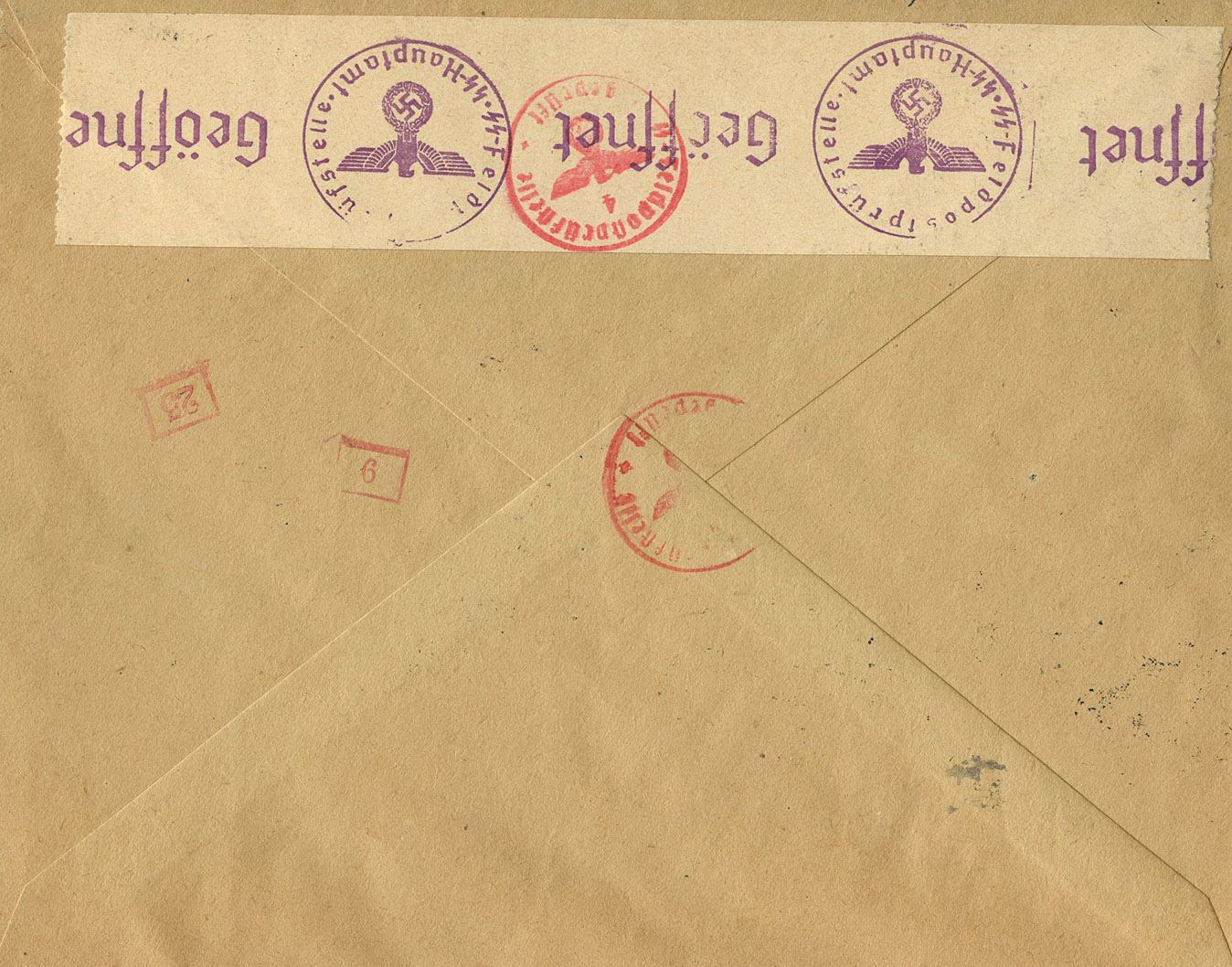


des Führers
und Reichskanzlers'
of the Führer
and Reich Chancellor)





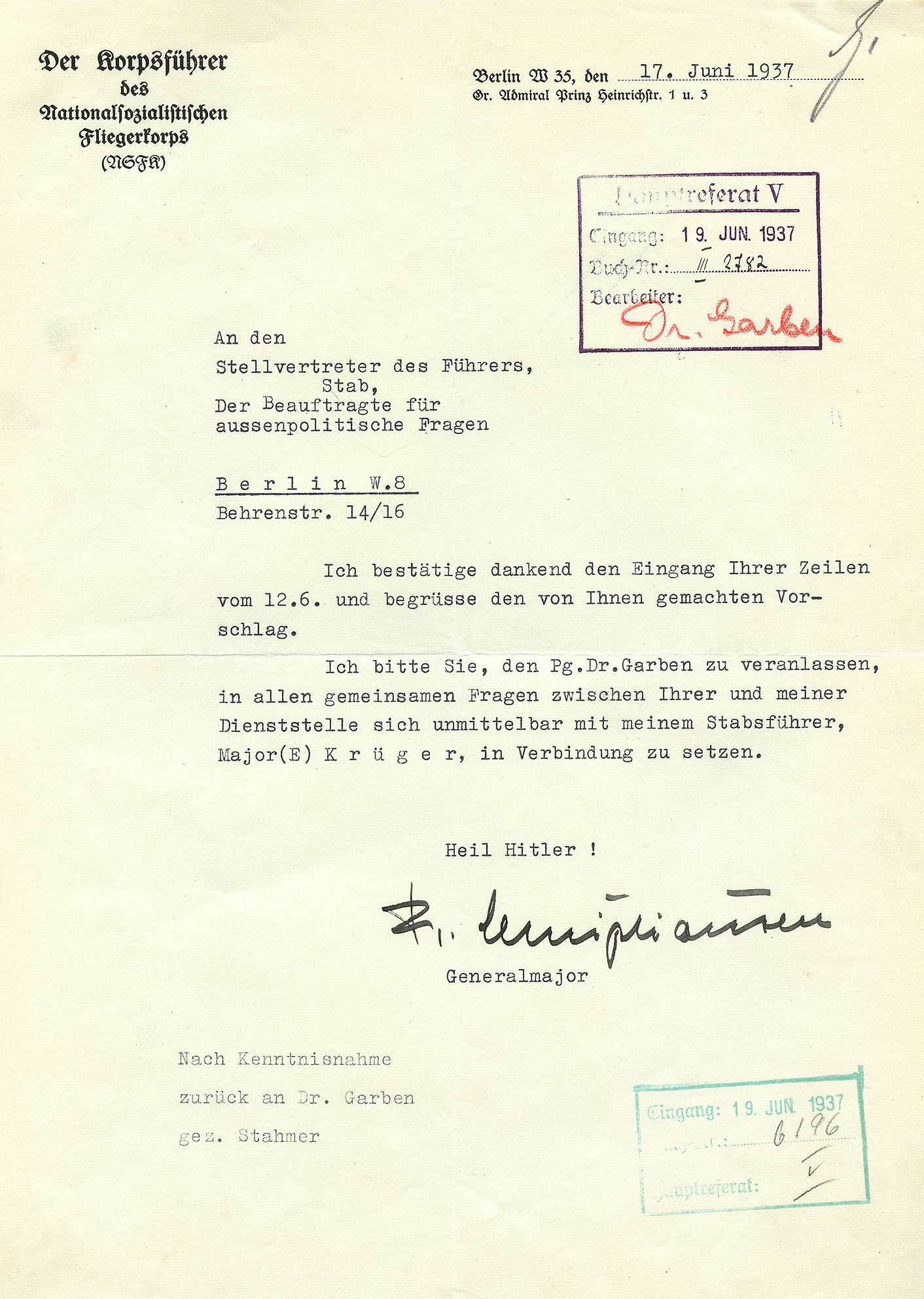

des
Nationalsozialistischen
Fliegerkorps
(NSFK)
Stellvertreter des Führers,
Stab,
Der Beauftragte für
aussenpolitische Fragen
vom 12.6. und begrüsse den von Ihnen gemachten Vorschlag.
in allen gemeinsamen Fragen zwischen Ihrer und meiner
Dienststelle sich unmittelbar mit meinem Stabsführer,
Major (E) K r ü g e r, in Verbindung zu setzen.
of
National Socialist
Flyer Corps
(NSFK)
Deputy Leader,
Staff,
The Commissioner for
Foreign Policy Issues
of 12.6. and welcome the proposal you have made.
on all common issues between yours and mine
Liaise directly with my Chief of Staff,
Major (E) K r ü g e r, to contact.)
gez. Stahmer'
signed Stahmer)




Verbindungsführer zur
Schutzpolizei,
Herrn Polizeihauptmann Helwes,
Bremen'
Liaison Leader to the
Protection Police,
Police Captain Helwes,
Bremen)
Erinnerung an den "Tag der SA-Gruppe Nordsee" eine versilberte
Plakette mit Etui zu überreichen.
Damit verbinde ich meinen Dank für Ihre
Tätigkeit als Verbindungsführer im Aufmarschstab.
Heil Hitler!
Der Führer des Aufmarschstabes:
[unknown signature]
Brigadeführer
"Day of the SA Group North Sea" a silver-plated badge with case.
With it I express my gratitude for your
activity as a Liaison Leader in the Marching Staff.
Heil Hitler!
The Leader of the Marching Staff:
[unknown signature]
Brigadeführer)





















1 Notizbuch
1 Geldbörse
2 Bleistifte
1 Brieftasche mit Bilder
2 Liederbucher
einige Bilder und Briefe
Geldbetrag RM. 9.72
1 Fullhalter
Briefpapier u. Briefe.
1 notebook
1 wallet
2 pencils
1 wallet with pictures
2 songbooks
some pictures and letters
amount of money RM. 9.72
1 full holder
stationery & letters.






8.11.41, FP-E-Brief mit Kenn-Nr.
667 = Zweig-FP-Amt SS-Totenkopf-Division
3699 = 2.Kp.Pz.Jäg.Abtl. 900
mit interessantem Inhalt (Nachlaßsachen
eines Gefallenen)'
8.11.41, FP-E letter with identification no.
667 = Branch FP Office SS Totenkopf Division
3699 = 2.Kp.Pz.Jäg.Abtl. 900
with interesting contents (estate matters
of a fallen man).]


Verbindungsstelle Berlin
(Berg)
Leiter der
Verbindungsstelle Berlin'
Liaison Office Berlin
Director of the
Berlin Liaison Office)






bitte ich Sie, das Paket Kaffee als kleines Weihnachtsgeschenk entgegennehmen zu wollen. Es entstammt einer grösseren Sendung, die mir aus dem Auslande gespendet wurde.
Mit den herzlichsten Glückwünschen für das Weihnachtsfest und zum Neuen Jahr!'
I would ask you to accept the coffee package as a small Christmas present. It comes from a larger shipment that was donated to me from abroad.
With warmest wishes for Christmas and the New Year!)




Wilhelmstr. 63
Parteikanzlei

















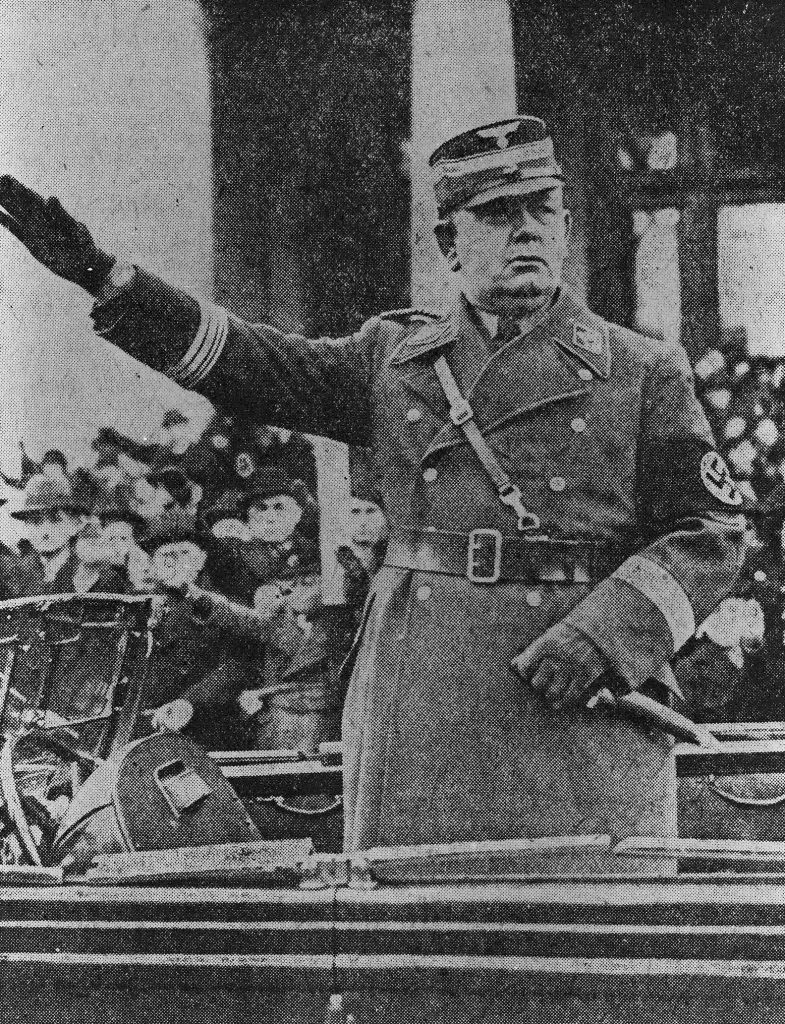

Geistig sehr durchgebildet, durch sein gutes Allgemeinwissen gestaltet er den Unterricht sehr anschaulich und interessant.
Lt. K. gesitzt Eigeninitiative und die Fähigkeit zur Improvisation.
Er steht auf dem Boden der nat. soz. Weltanschauung und ist jederzeit in der Lage, das nat. soz. Gedankengut zu verwerten und weiterzugeben.'
Mentally very well-educated, his good general knowledge makes his lessons very clear and interesting.
According to K., he showed initiative and the ability to improvise.
He is grounded in the natural social world view and is always able to utilize and pass on natural social ideas.)]

Die Kosten hat der Bauer Cordes zu tragen.
Der Geschäftswert beträgt 1000, -
R.M.'
The farmer Cordes has to bear the costs.
The value of the transaction is 1000.
R.M.)
Sie wollen nun ihren Neffen an Kindesstatt annehmen. Diese Annahme soll aber nur erfolden, wenn Johann Willms auch als Anerben'
They now wish to adopt their nephew in his place. However, this adoption is only to take place if Johann Willms is also named as an heir.)]



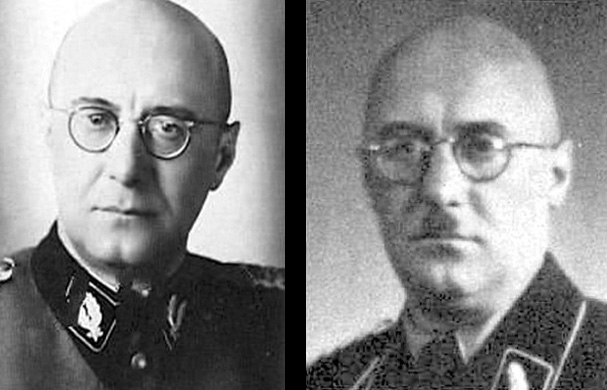
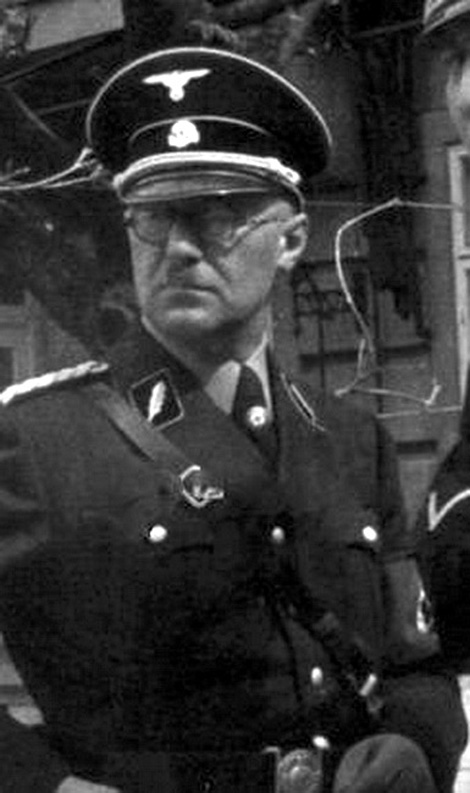


Portopflichtige Dienstsache'
Official matter subject to postage)]
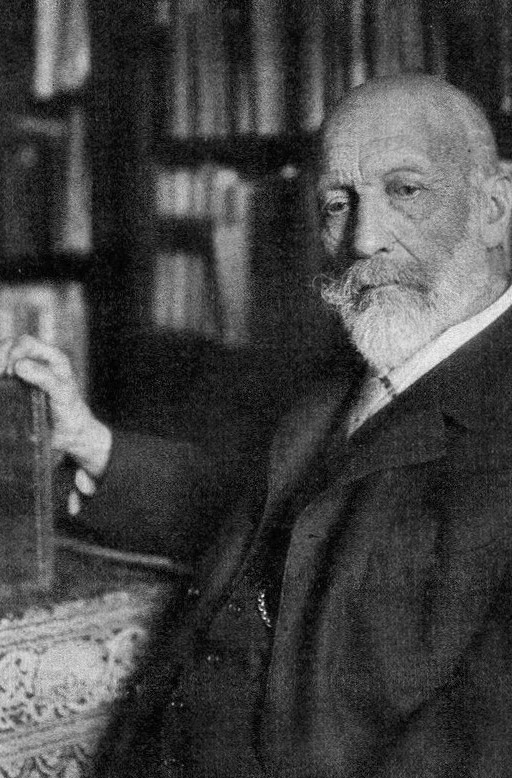

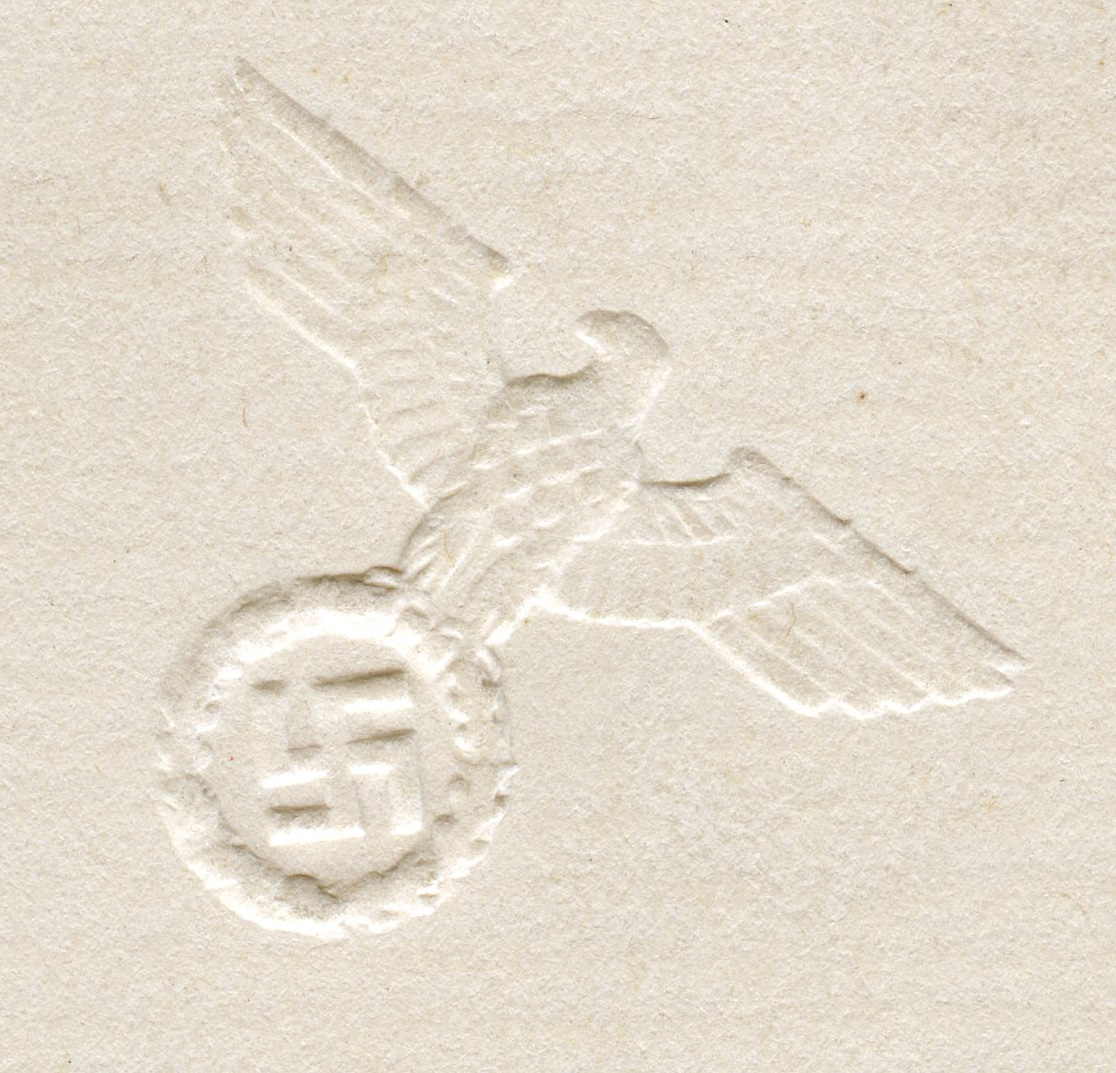

6. WHW - Reichs-Strassensammlung''
6. WHW - Reich Street Collection).]


Ich ernenne
den Steuerinspektor
Walter Lehmann zum
Regierungsinspektor.]
I appoint
the tax inspector
Walter Lehmann to
Government Inspector)

Ich ernenne
den Regierungsinspektor
Walter Lehmann
zum Regierungsoberinspektor
im Reichsdienst'
I appoint
the Government Inspector
Walter Lehmann
to senior government inspector
in the service of the Reich)]
verleihe ich Ihnen mit Wirkung vom 1. Oktober 1936 eine
im Haushalt des Reichsluftfahrtministeriums für
das Rechnungsjahr
1936 vorgesehene Planstelle
eines Regierungsoberinspektors
in Besoldungsgruppe
Das Besoldungsdienstalter wird besonders festgesetzt.'
With effect from October 1, 1936, I grant you,
in the budget of the Reich Ministry of Aviation, for
the financial year
permanent post in 1936
of a senior government inspector
pay grade
The length of service in remuneration shall be fixed
separately.)]
(Calculation of seniority in remuneration)
*Renumeration: money paid for work or a service.]
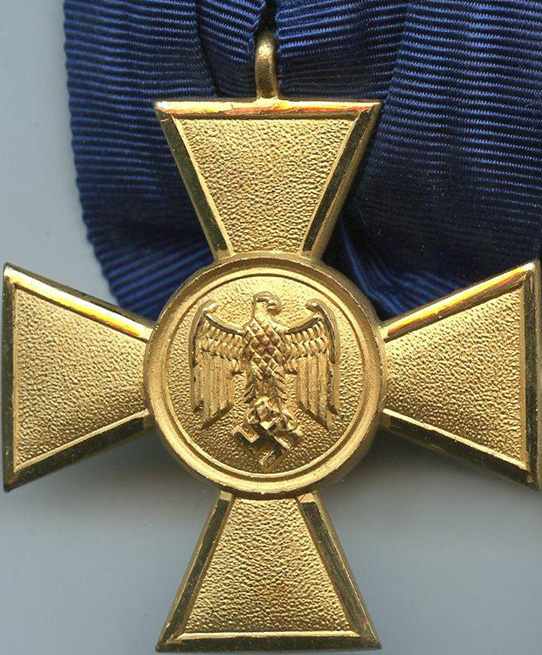

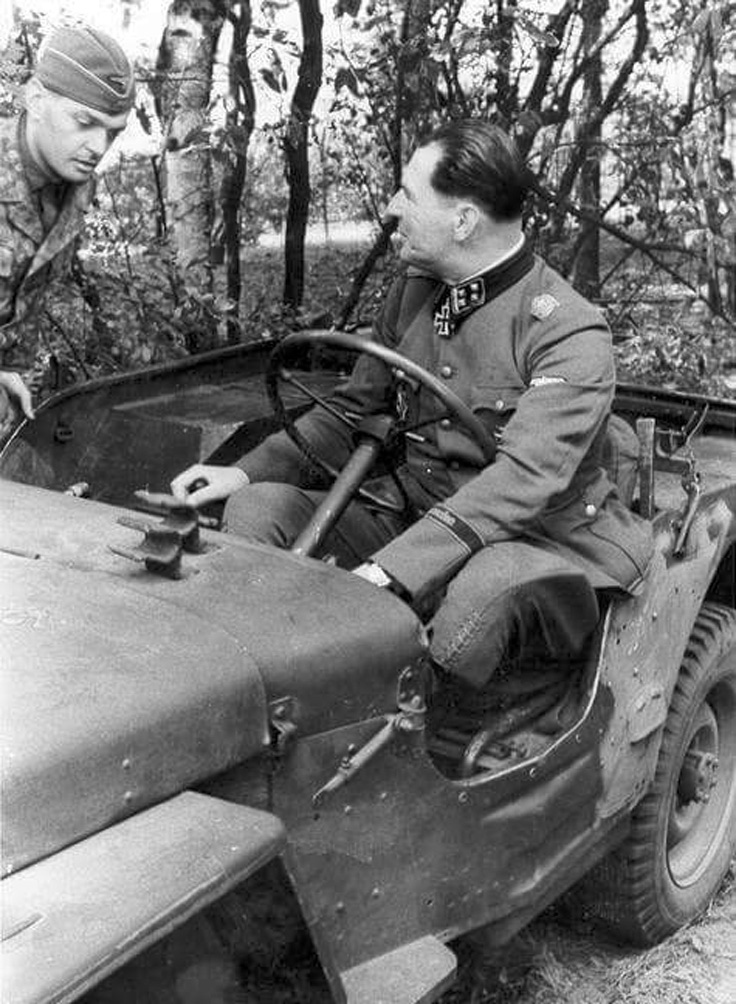
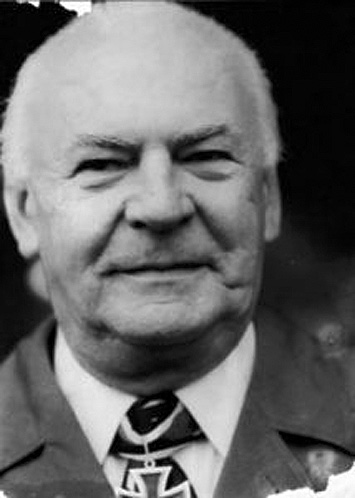





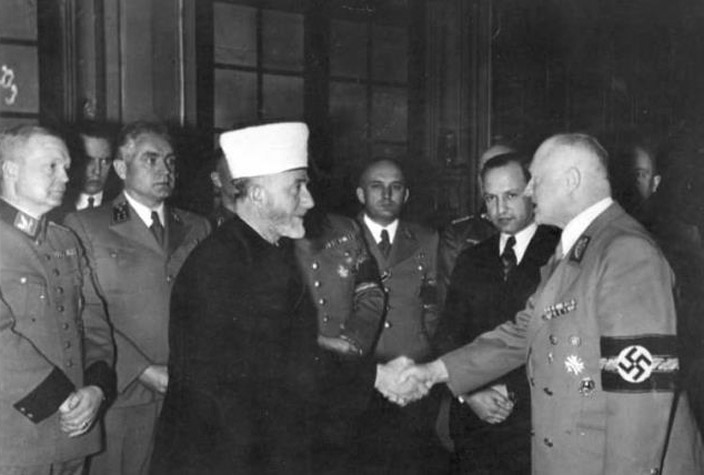


"Antje, mein blondes Kind"
"Das Engellandlied" (1939), lyrics: Hermann Löns)
"Die ganze Kompanie"
"Du Schönste von Städtel, schwarzbraunes Mädel"
"Es blitzen die stählernen Schwingen"
"Erika (Auf der Heide blüht ein kleines Blümelein)" (1938)
"Es geht ums Vaterland"
"Es ist so schön, Soldat zu sein, Rosemarie"
"Es war ein Edelweiß"
"Edelweißmarsch"
"Fallschirmjägerlied"
"Fliegerkuss"
"Frühmorgens singt die Amsel"
"Gerda – Ursula – Marie"
"Hannelore Marschlied"
"Heut´ sind wir wieder unter uns"
"Heut’ stechen wir ins blaue Meer"
"Heute muß ich scheiden"
"Im Osten pfeift der Wind"
"In der Heimat steh’n auf Posten"
"Jawoll, das stimmt, jawoll"
"Kamerad, wir marschieren gen Westen"
"Liebchen adé (Annemarie-Polka)" (1934)
"Liebling, wenn ich traurig bin…"
"Marie - Mara - Maruschkaka!"
"Matrosenlied"
"Mein Bismarckland"
"Mit Mercedes Benz voran"
"Rosalinde"
"Rosemarie (Rosemarie, ich lieb' dich gar so sehr)"
"Ruck Zuck"
"Sieg Heil Viktoria"
"Stuka über Afrika"
"Unsere Flagge"
"Veronika - Marie"
"Waltraut ist ein schönes Mädchen"
"Wenn die Sonne scheint, Annemarie (Die Landpartie)"
"Tschingta, Tschingta, Bummtara"
